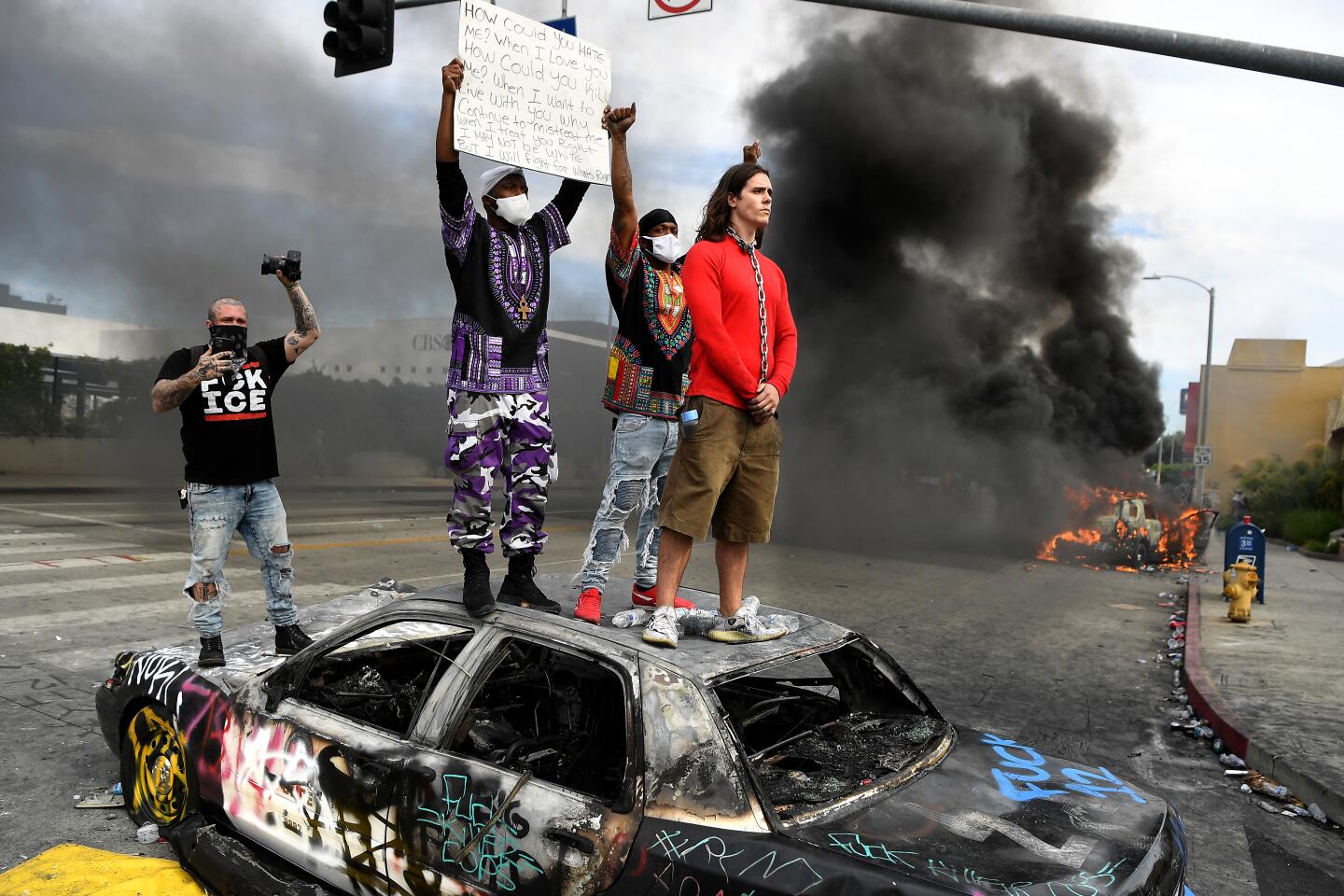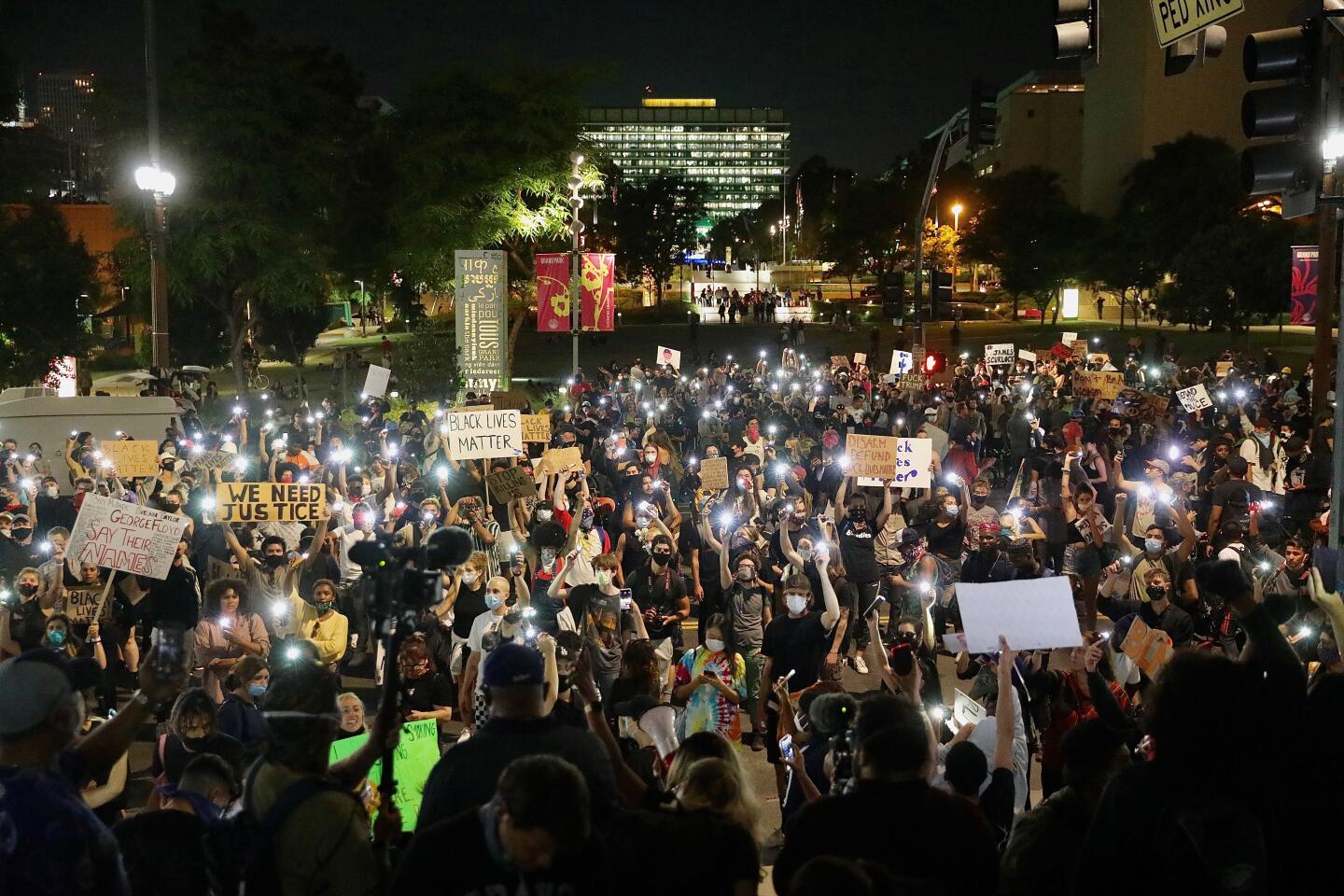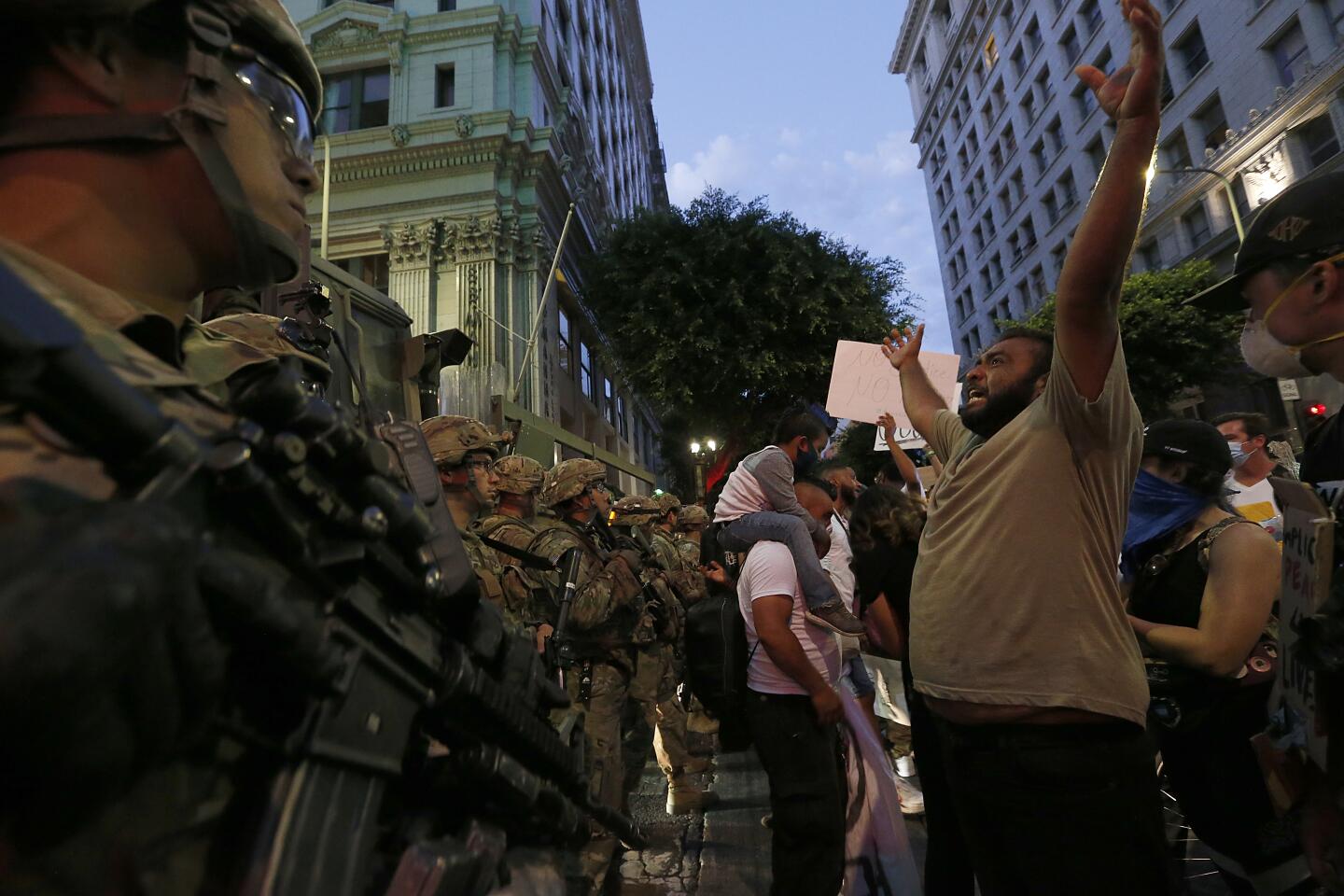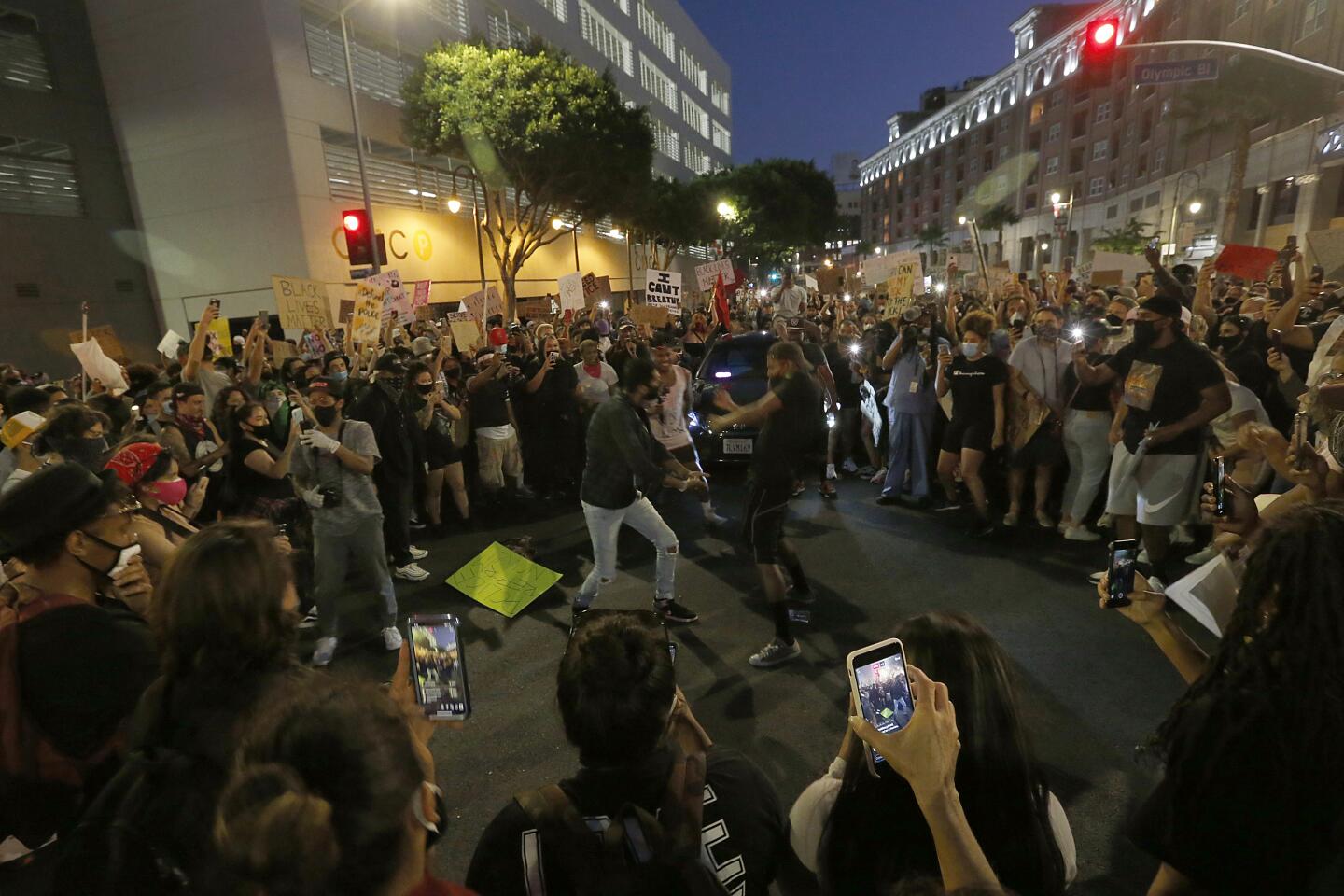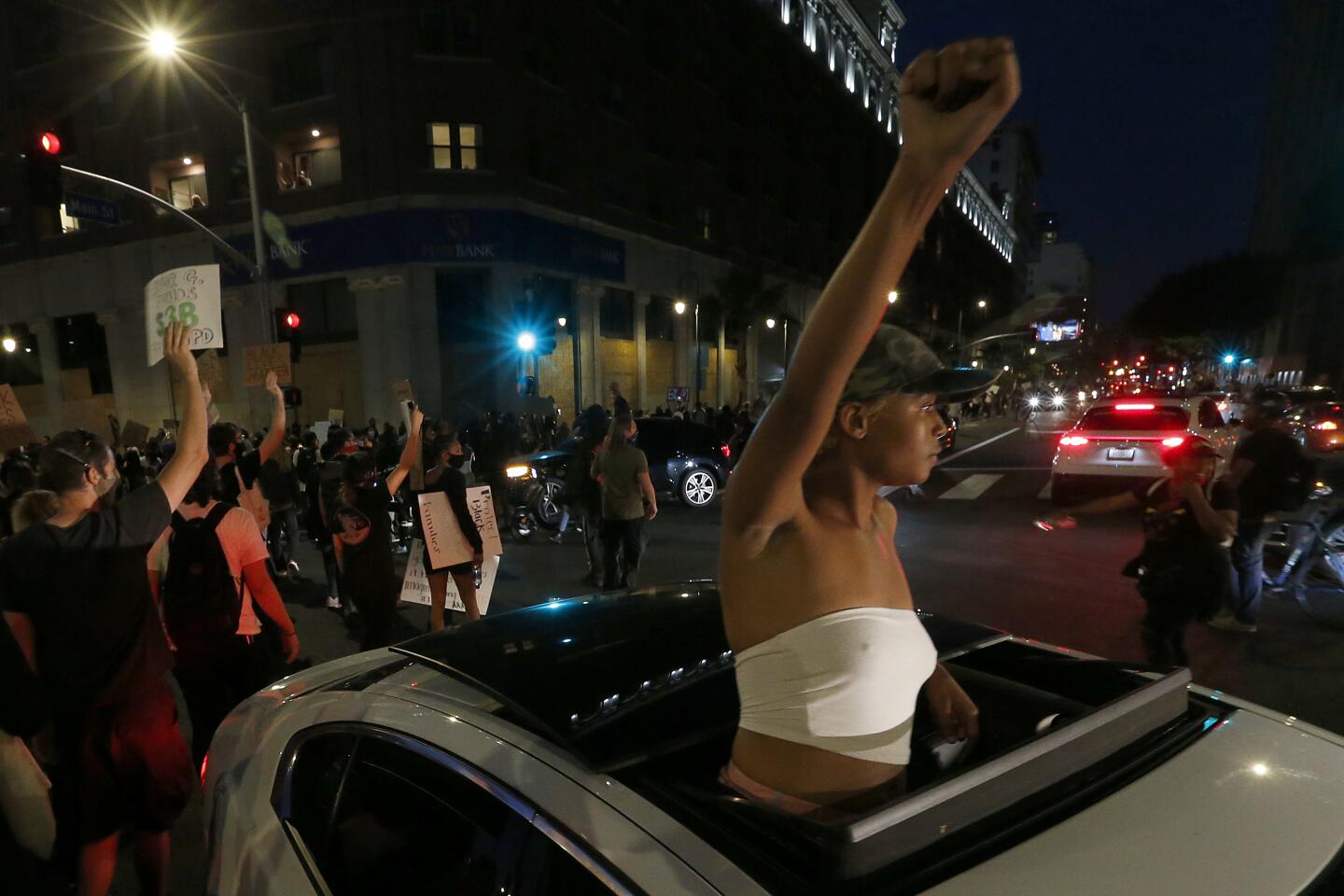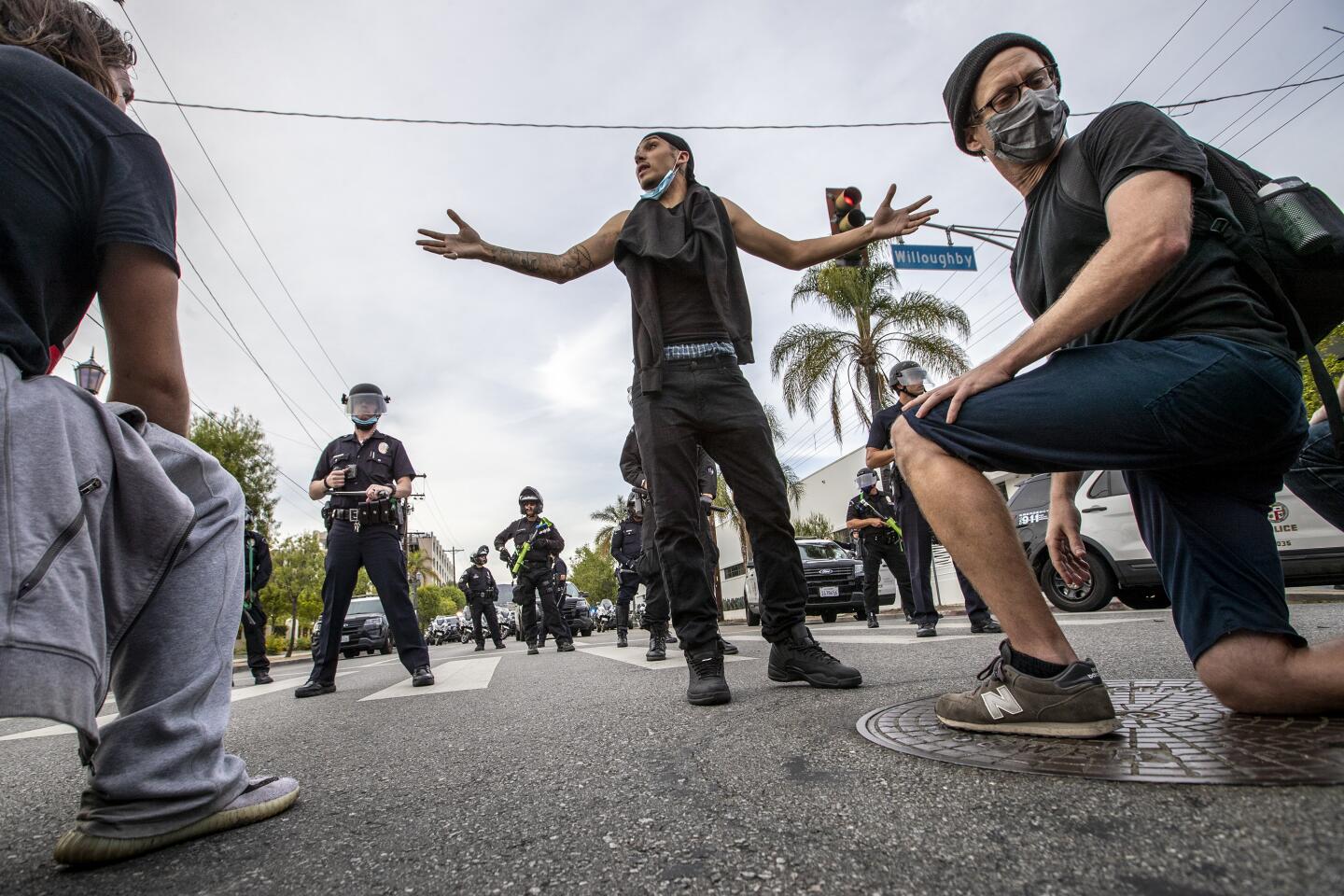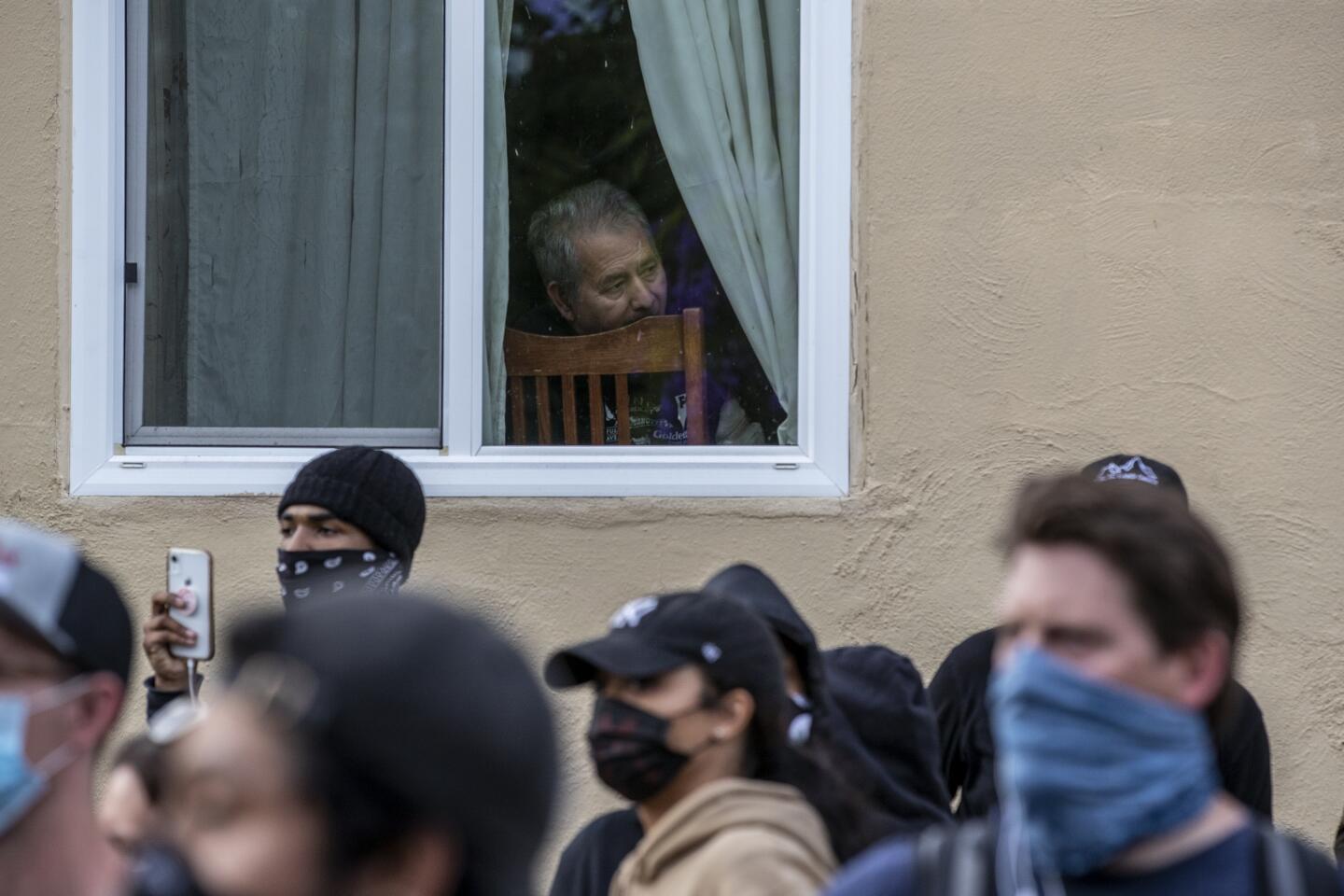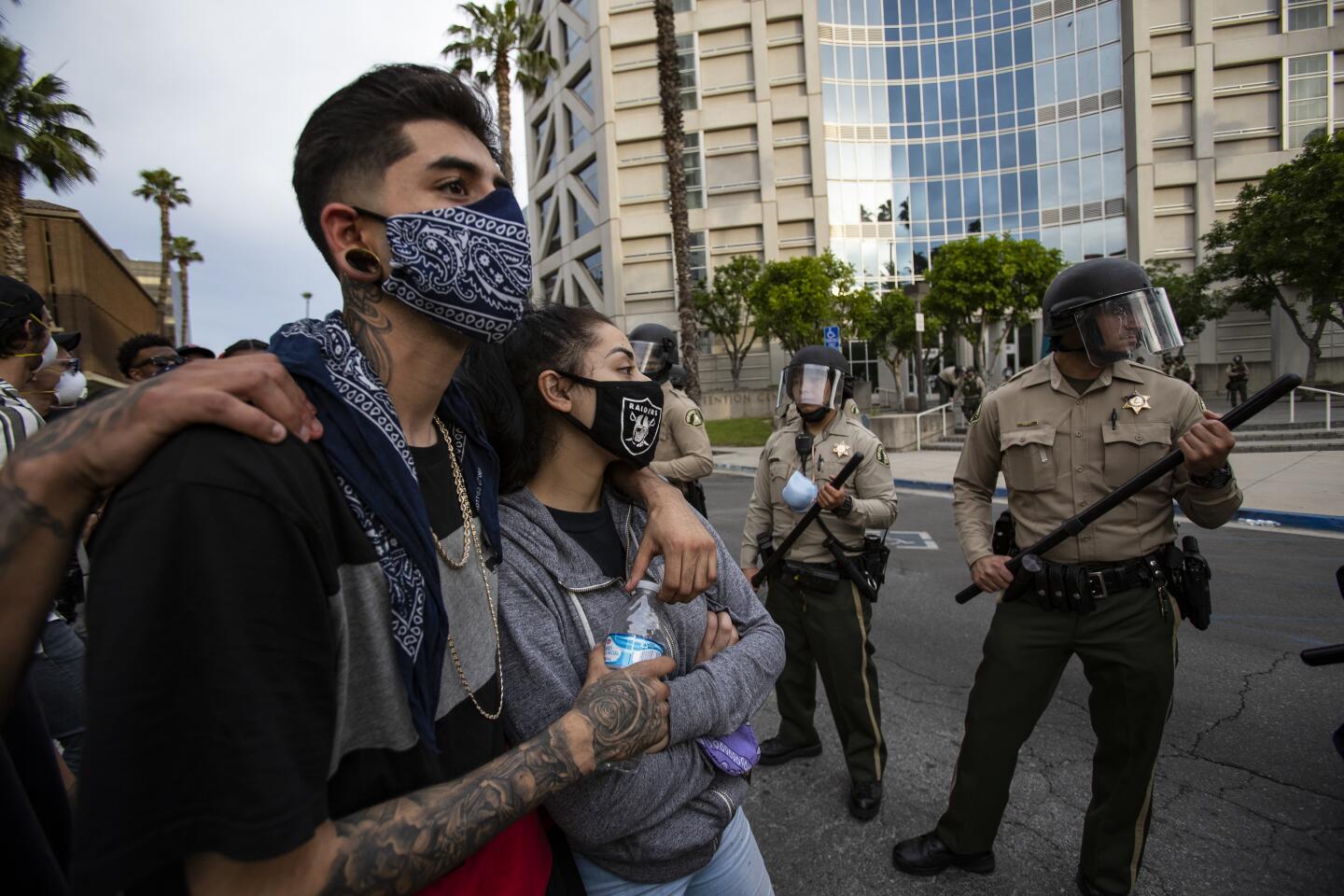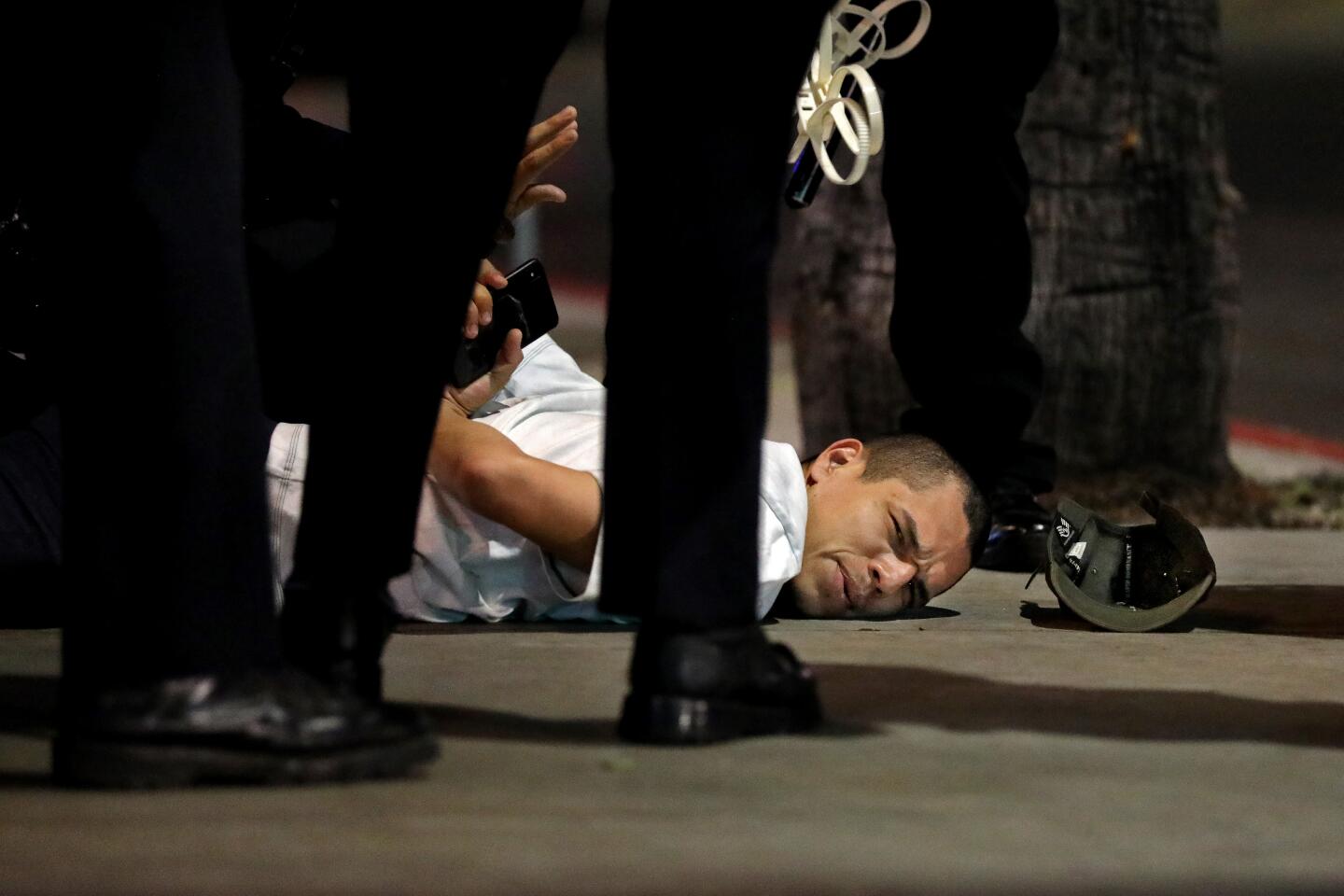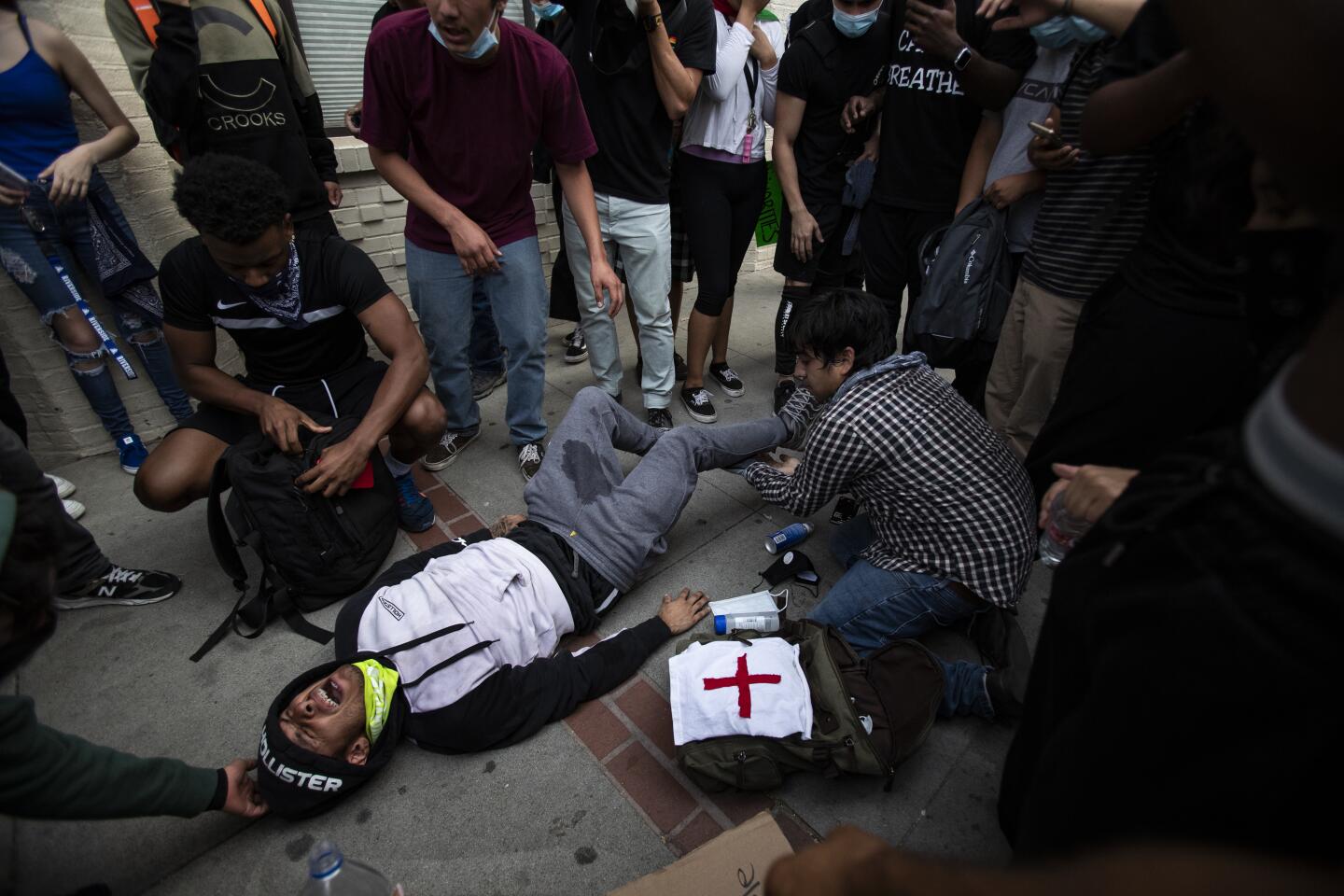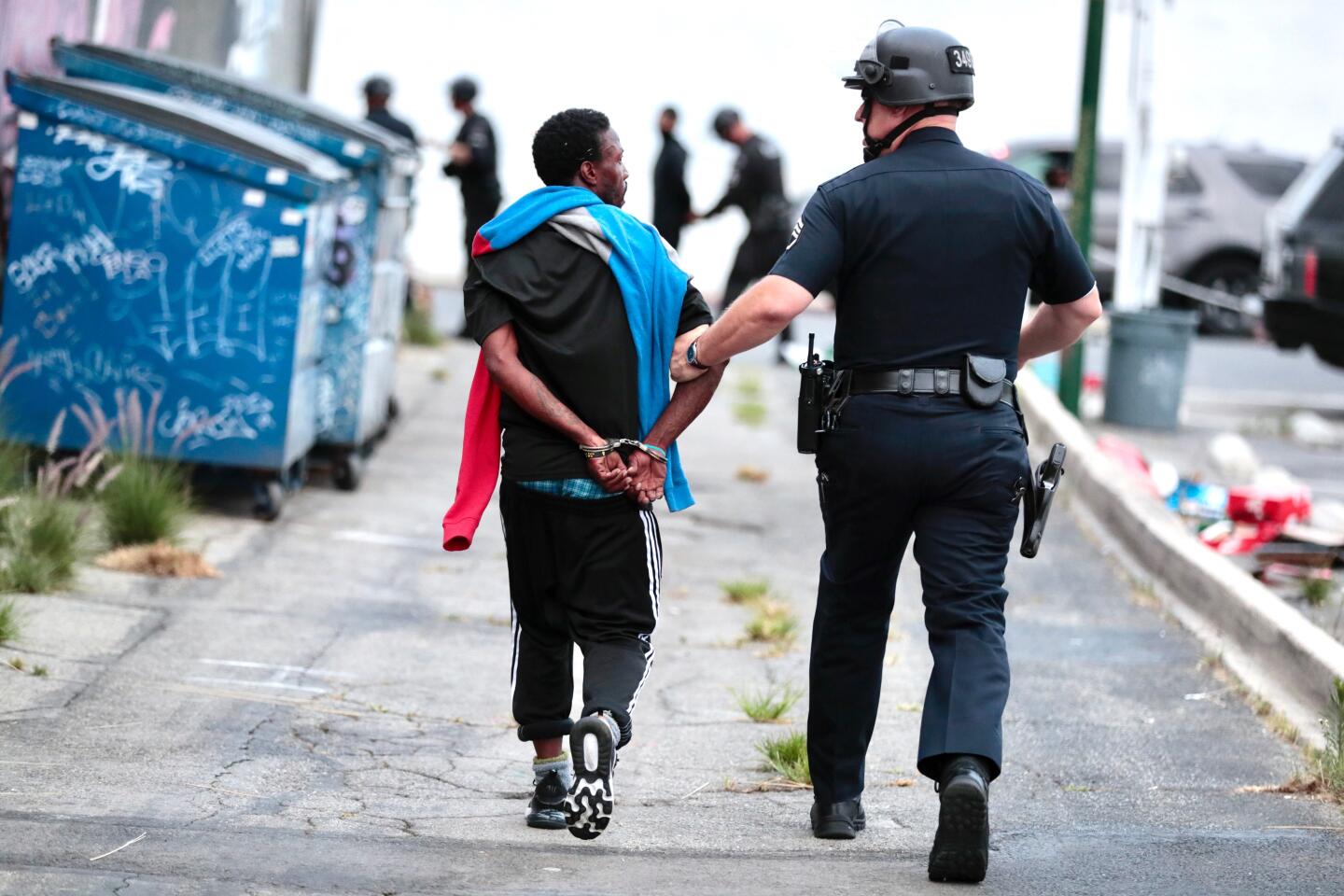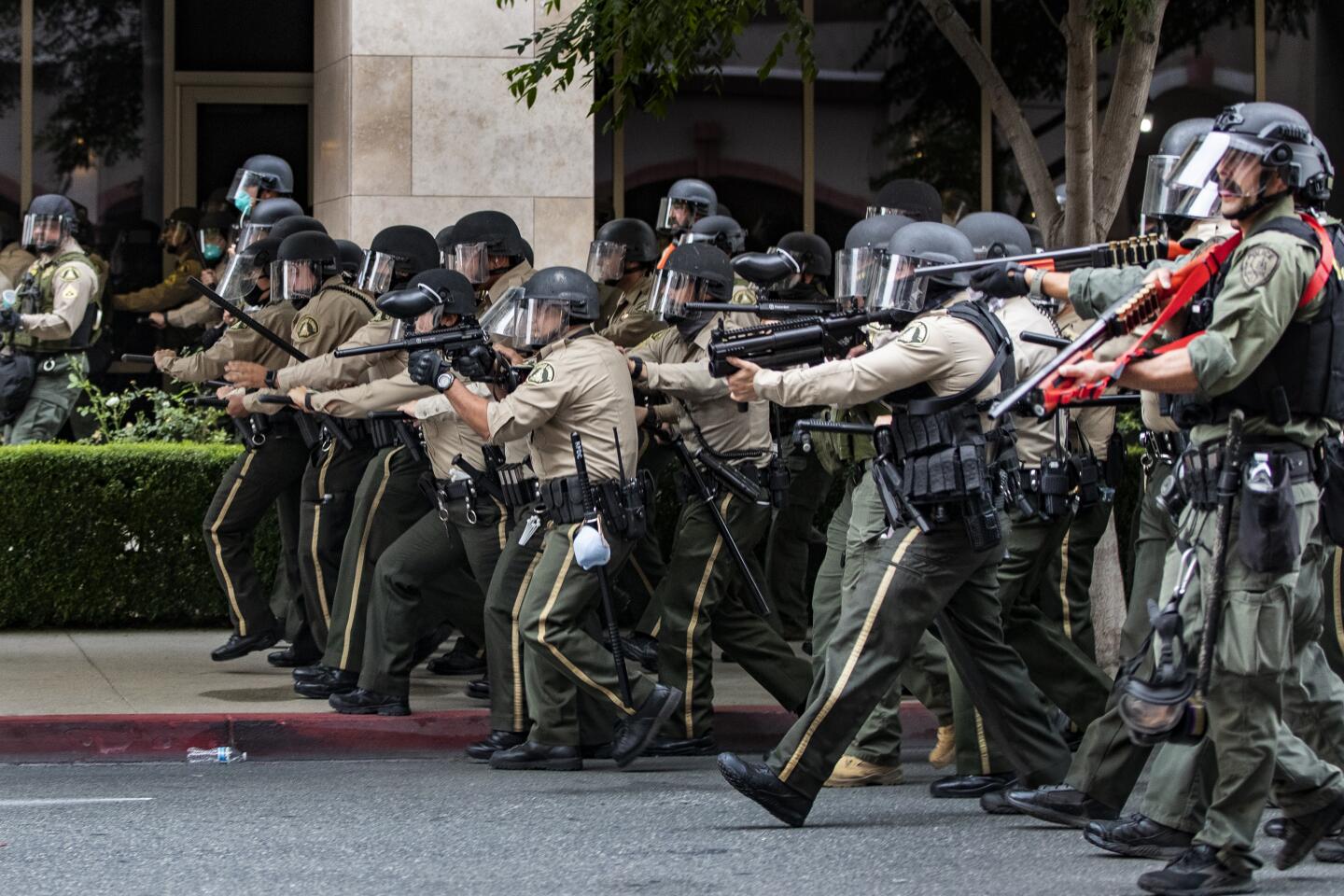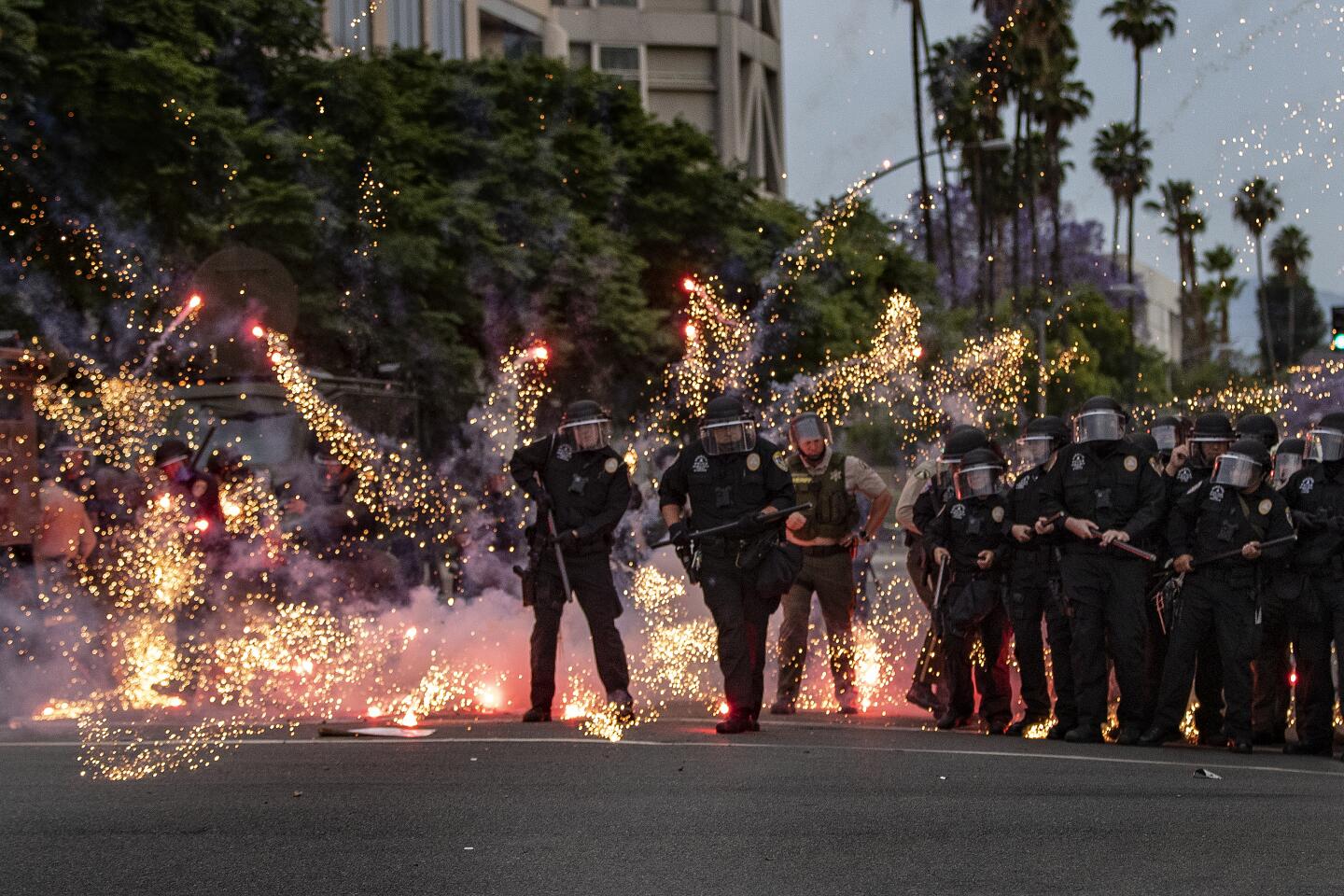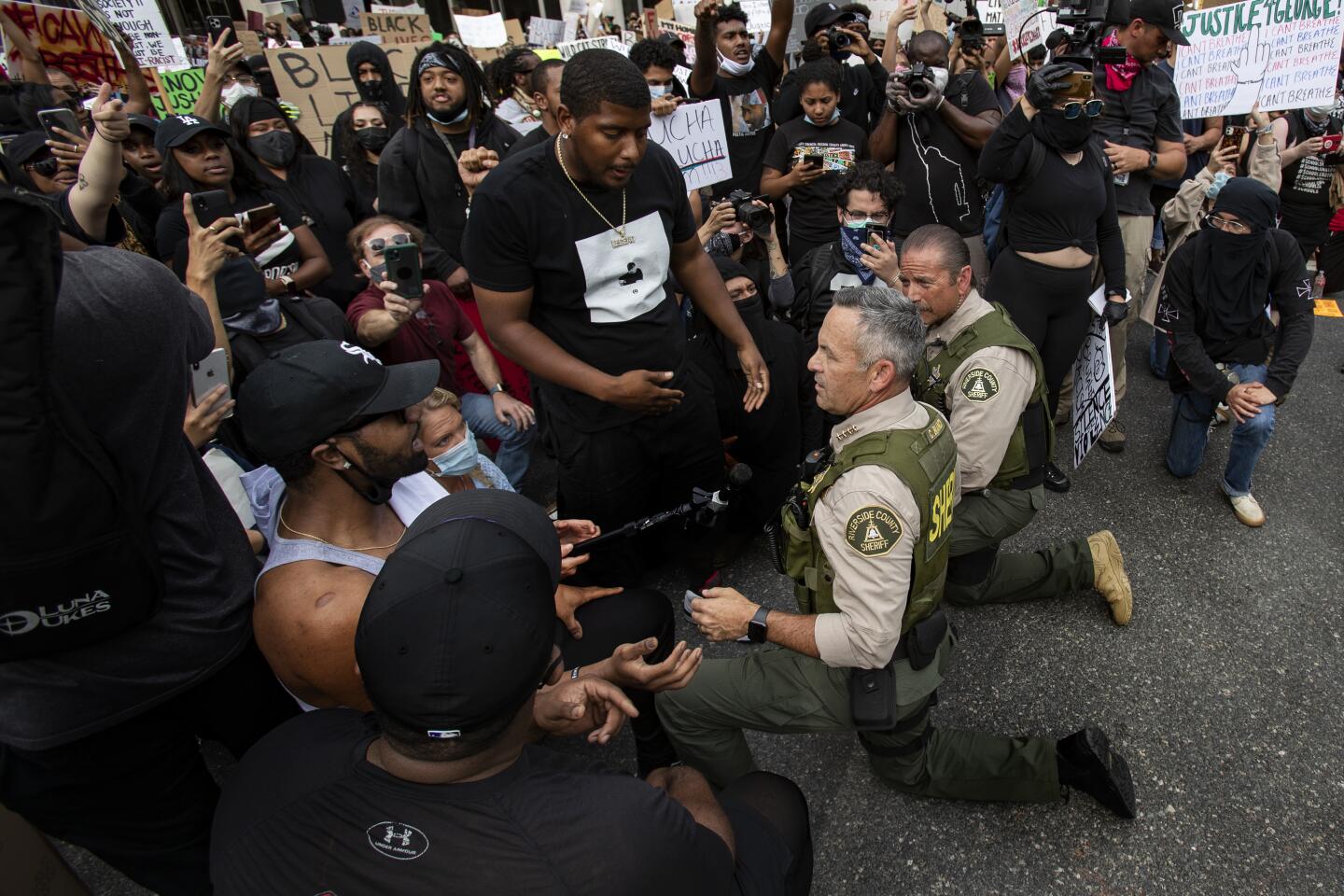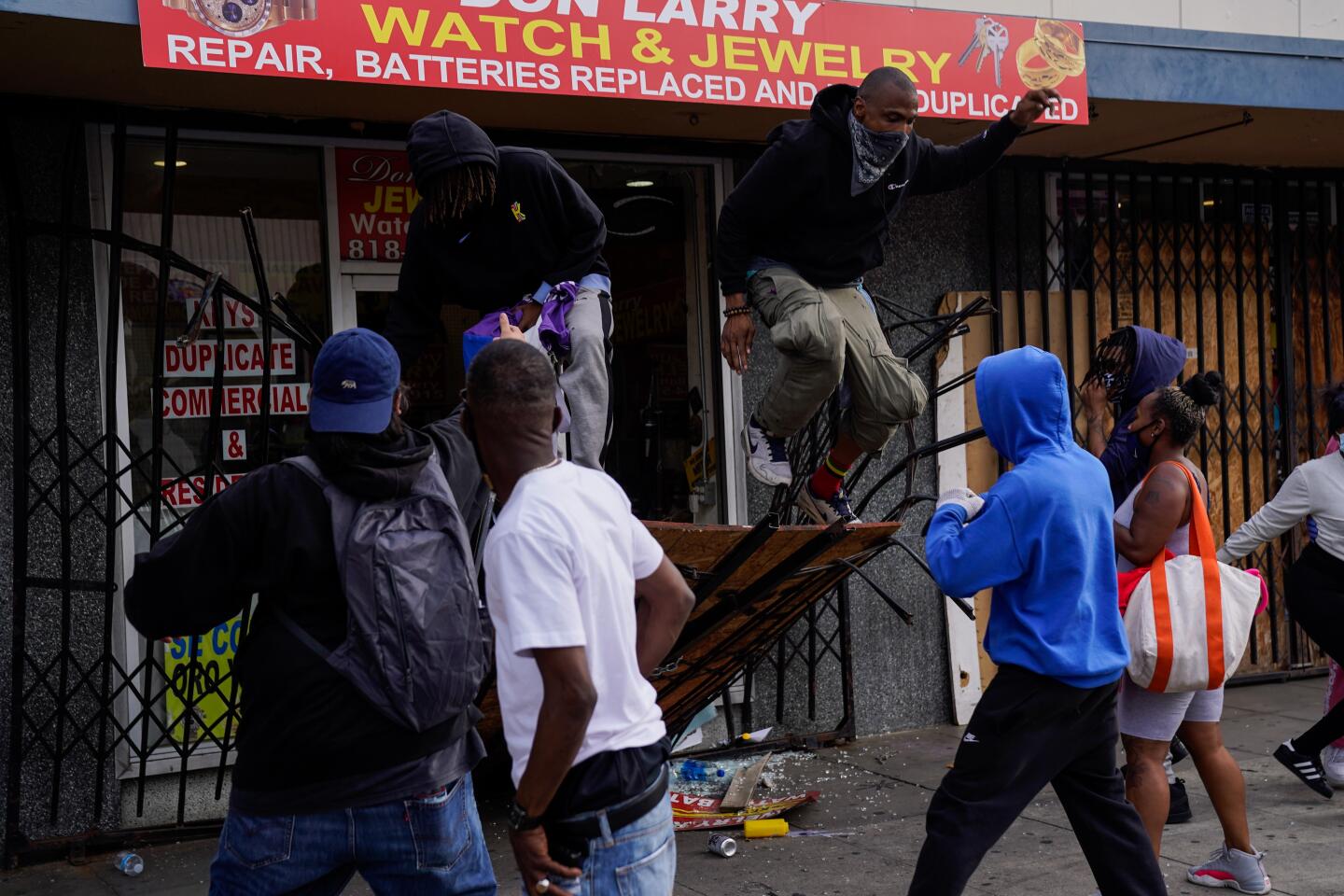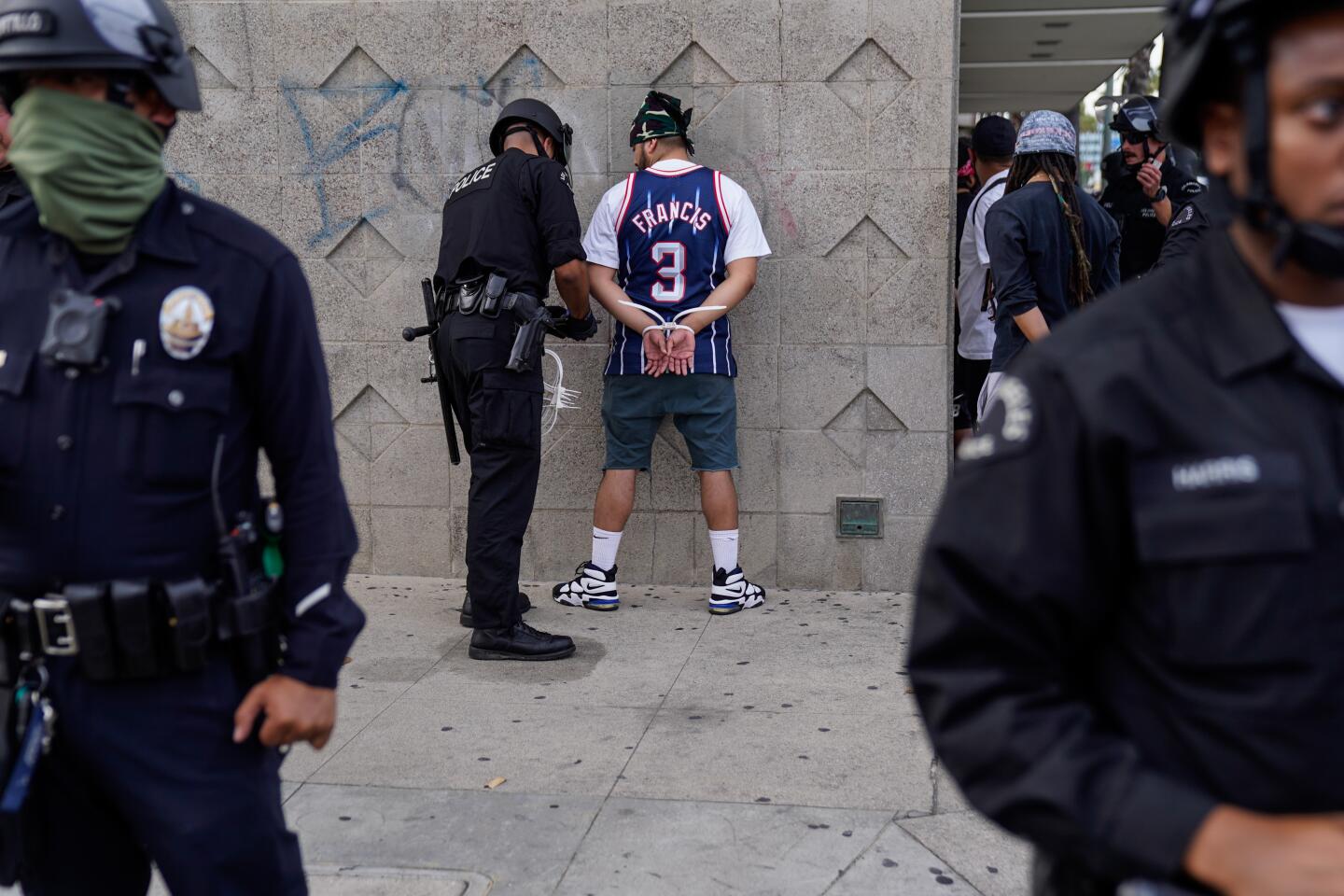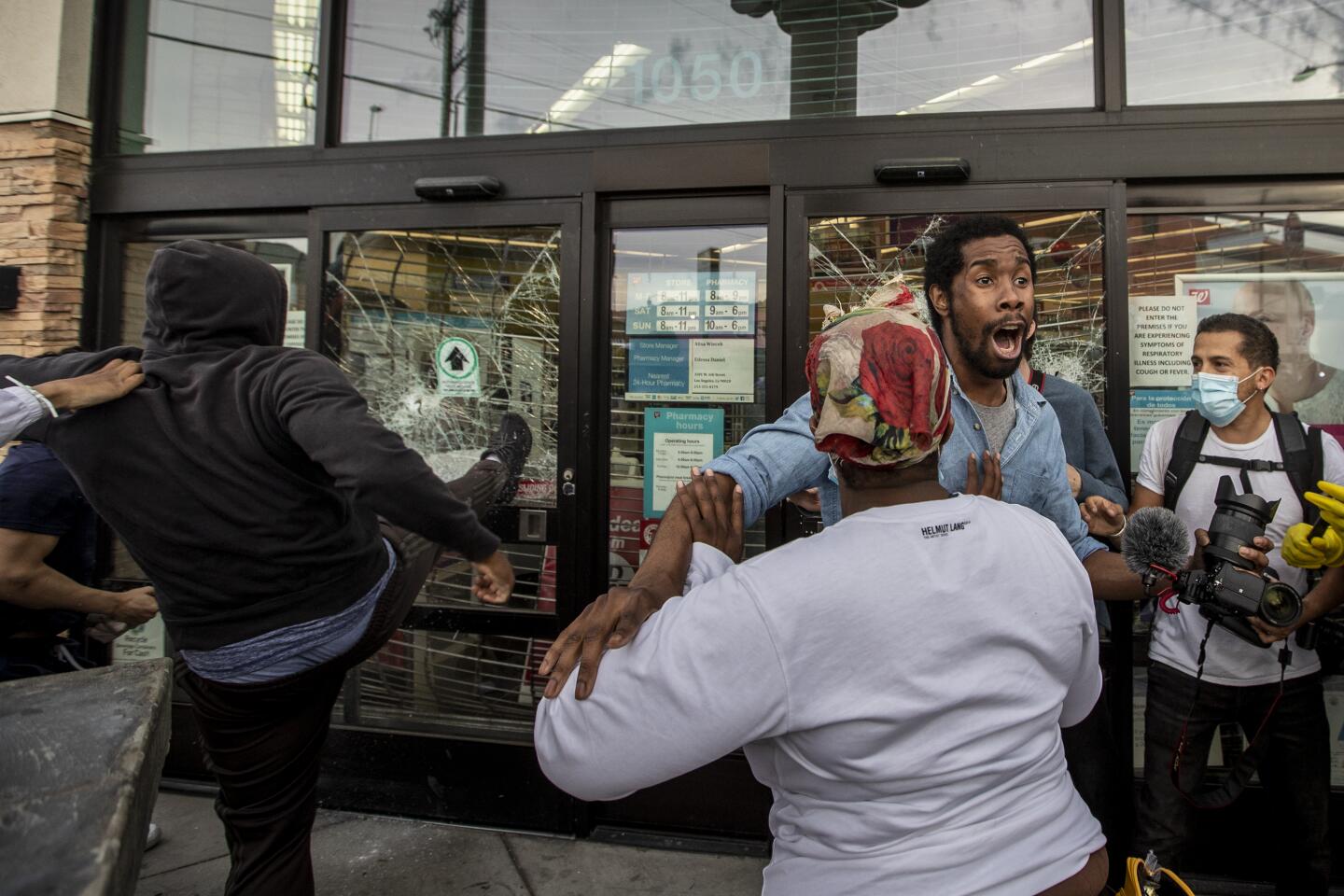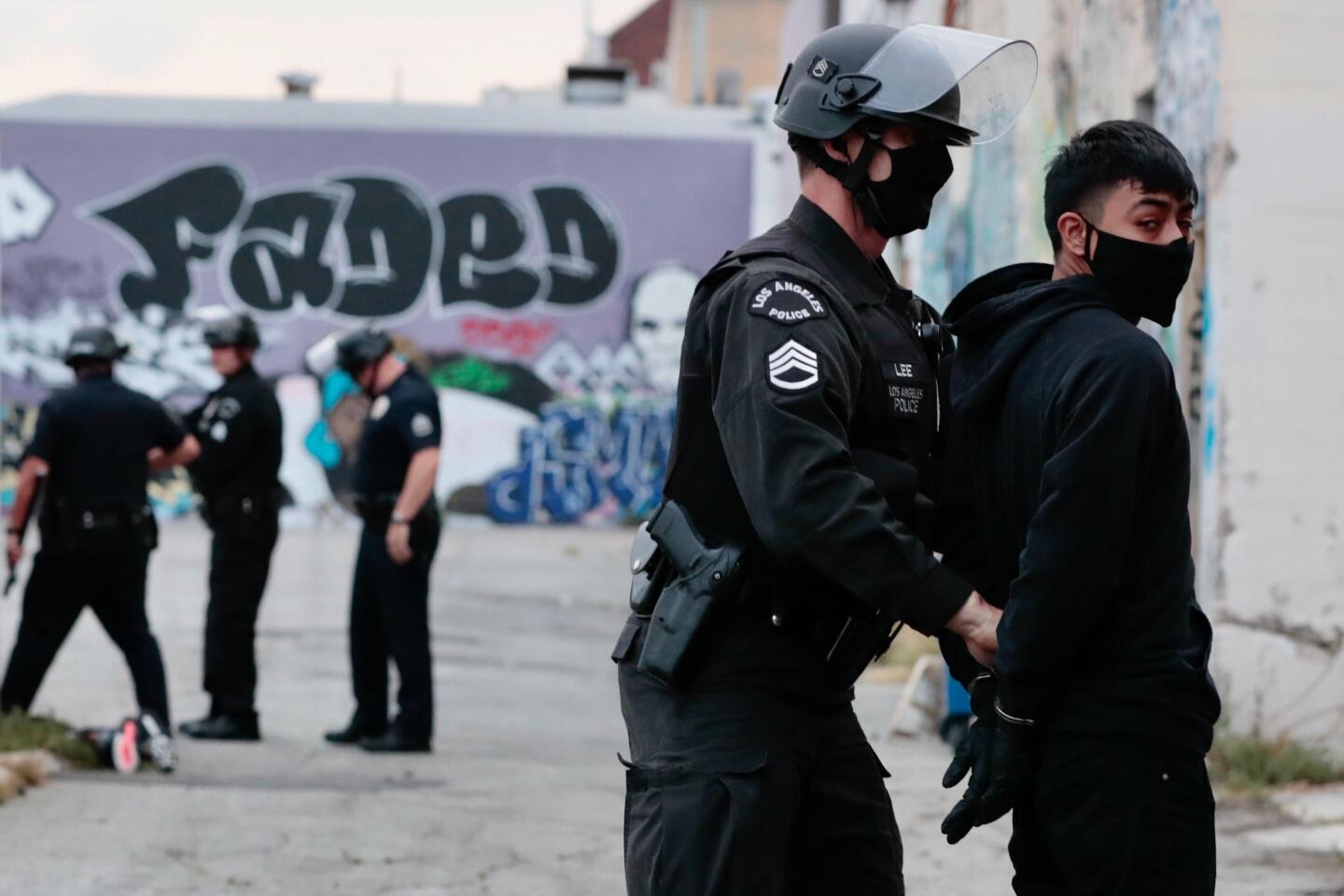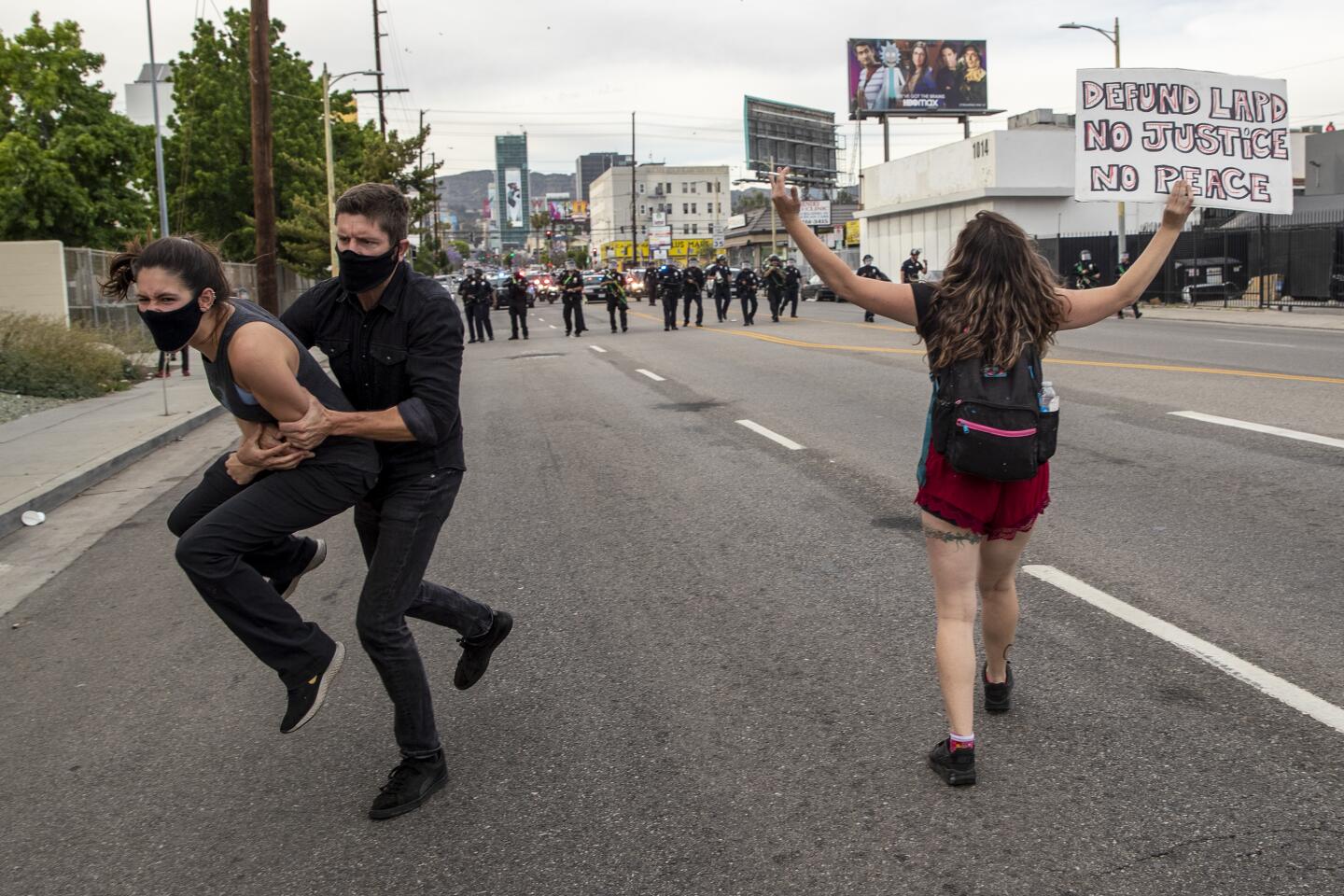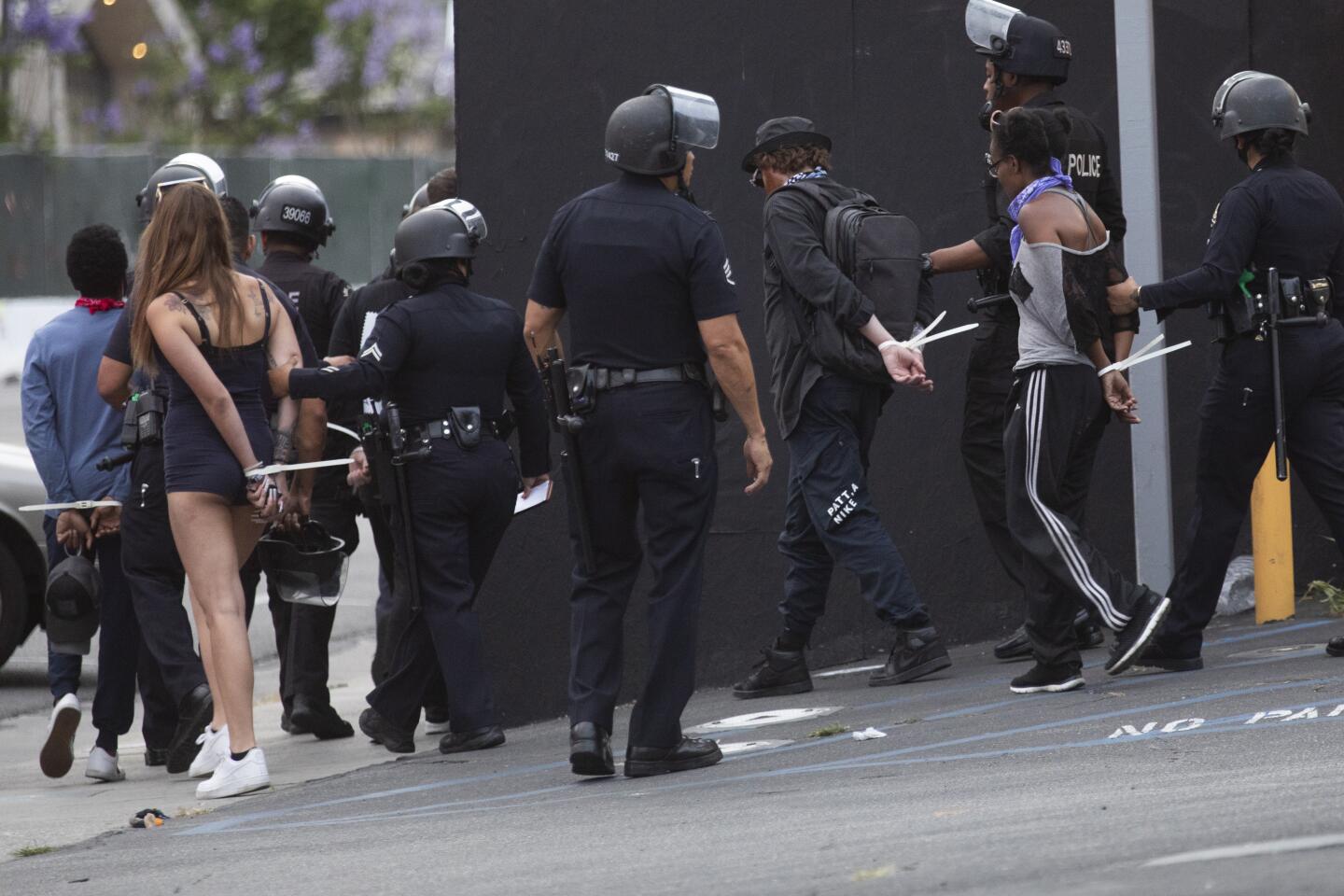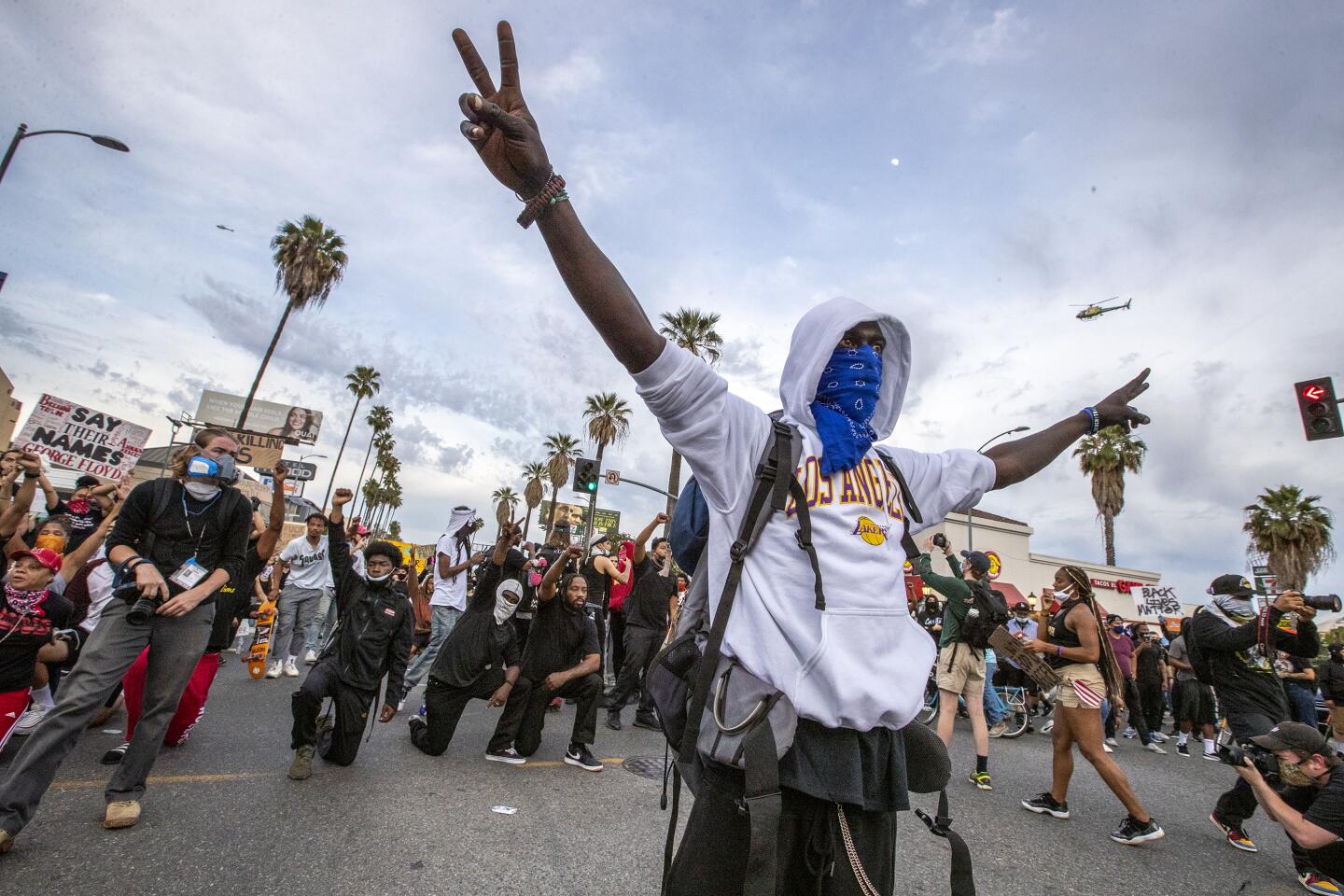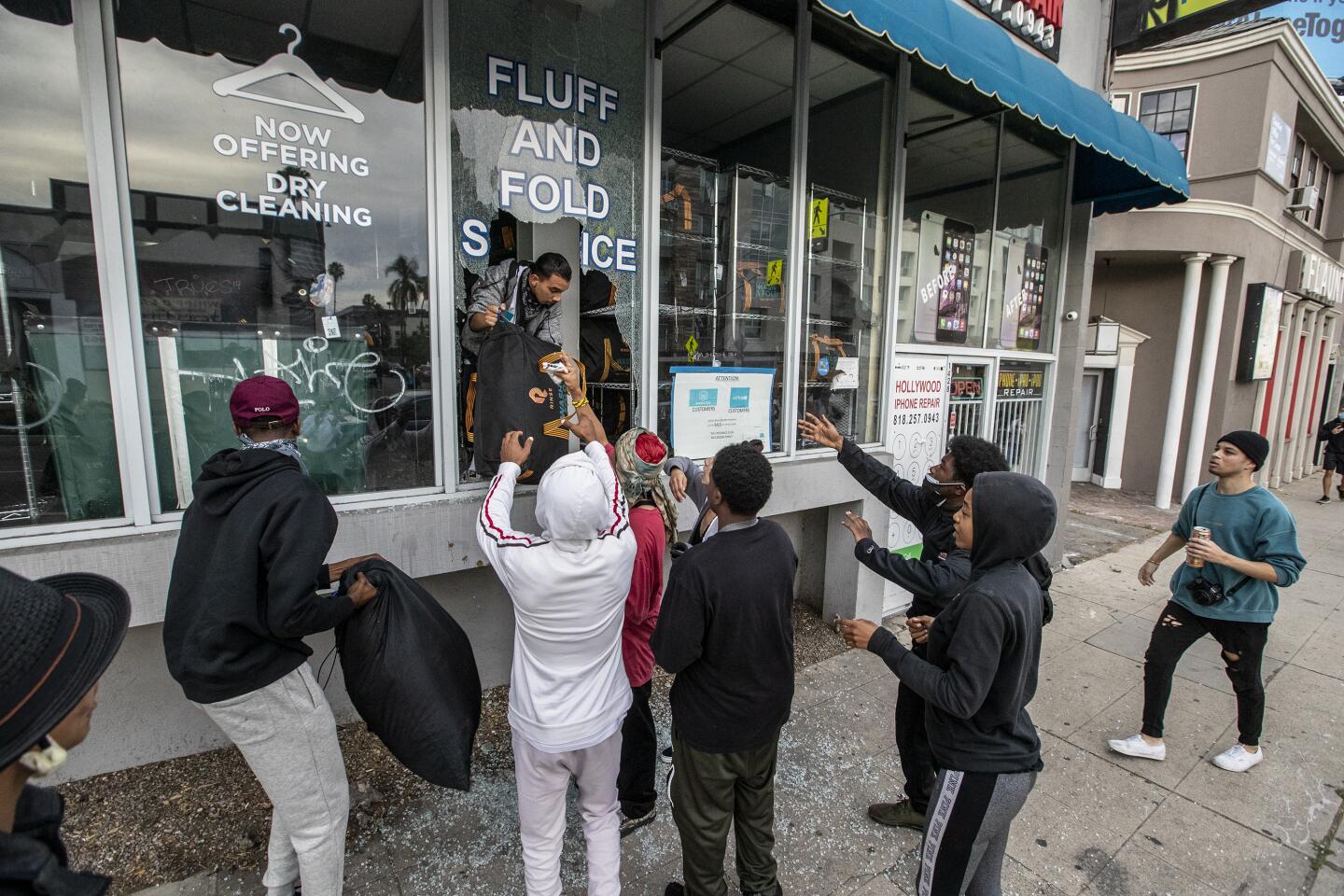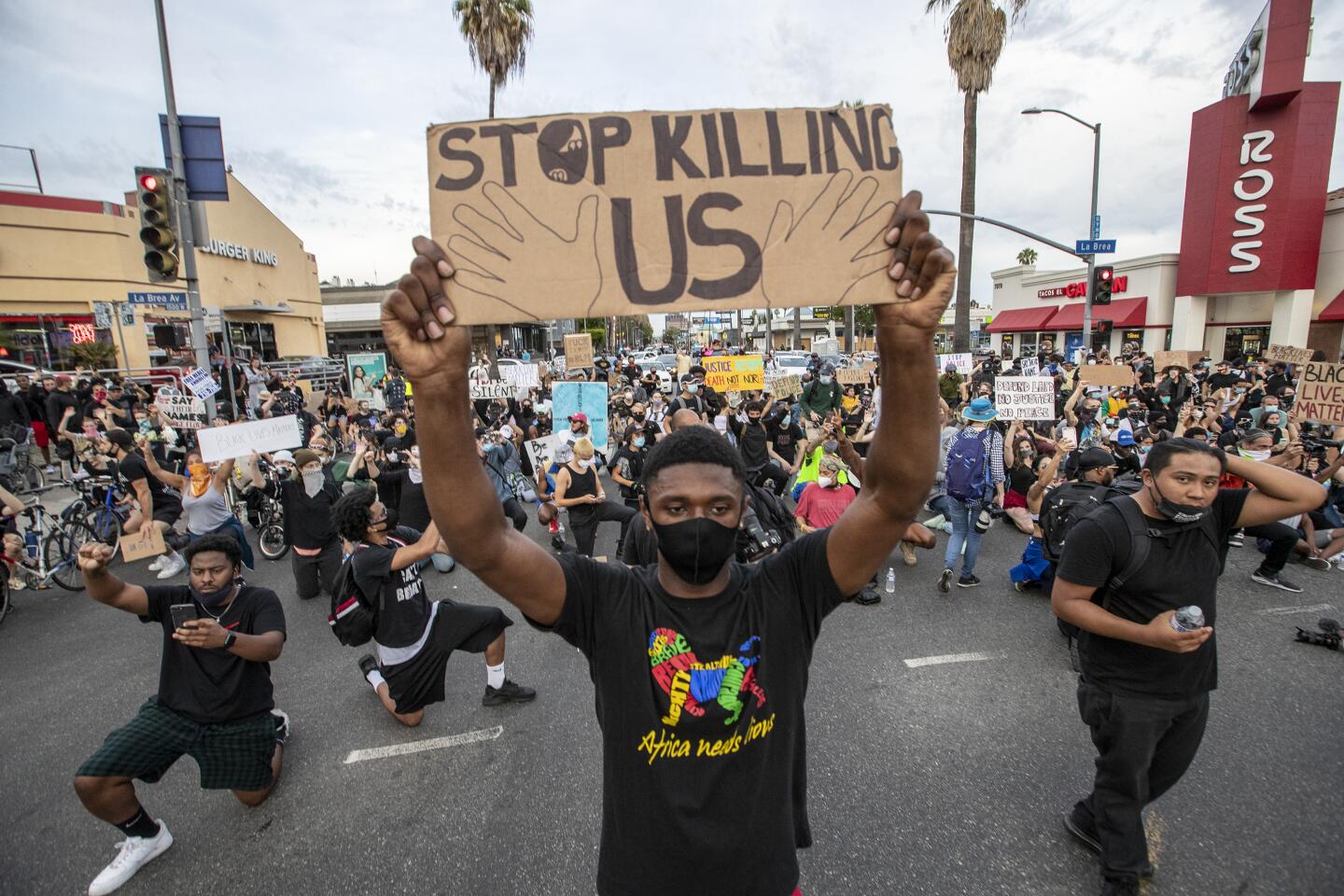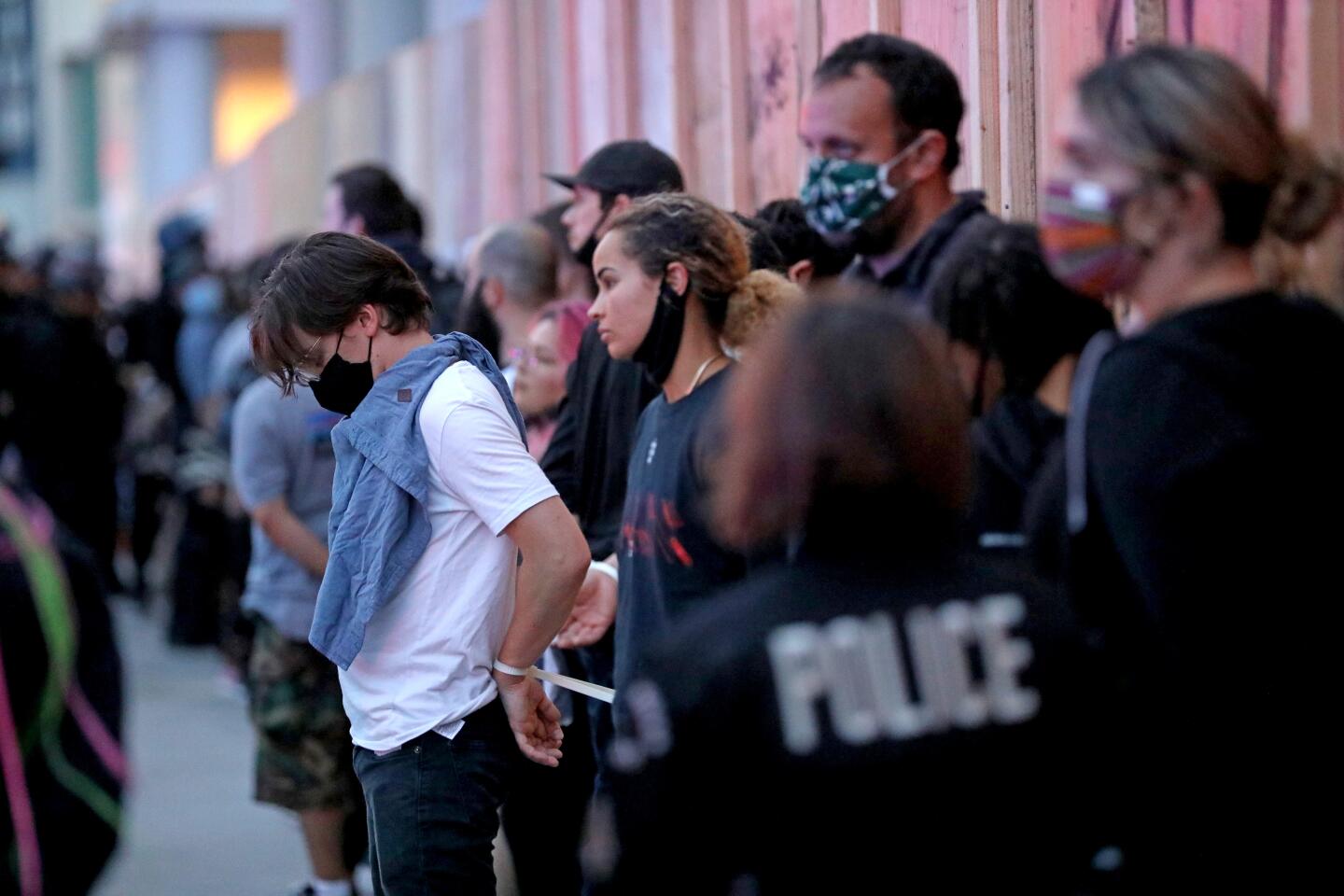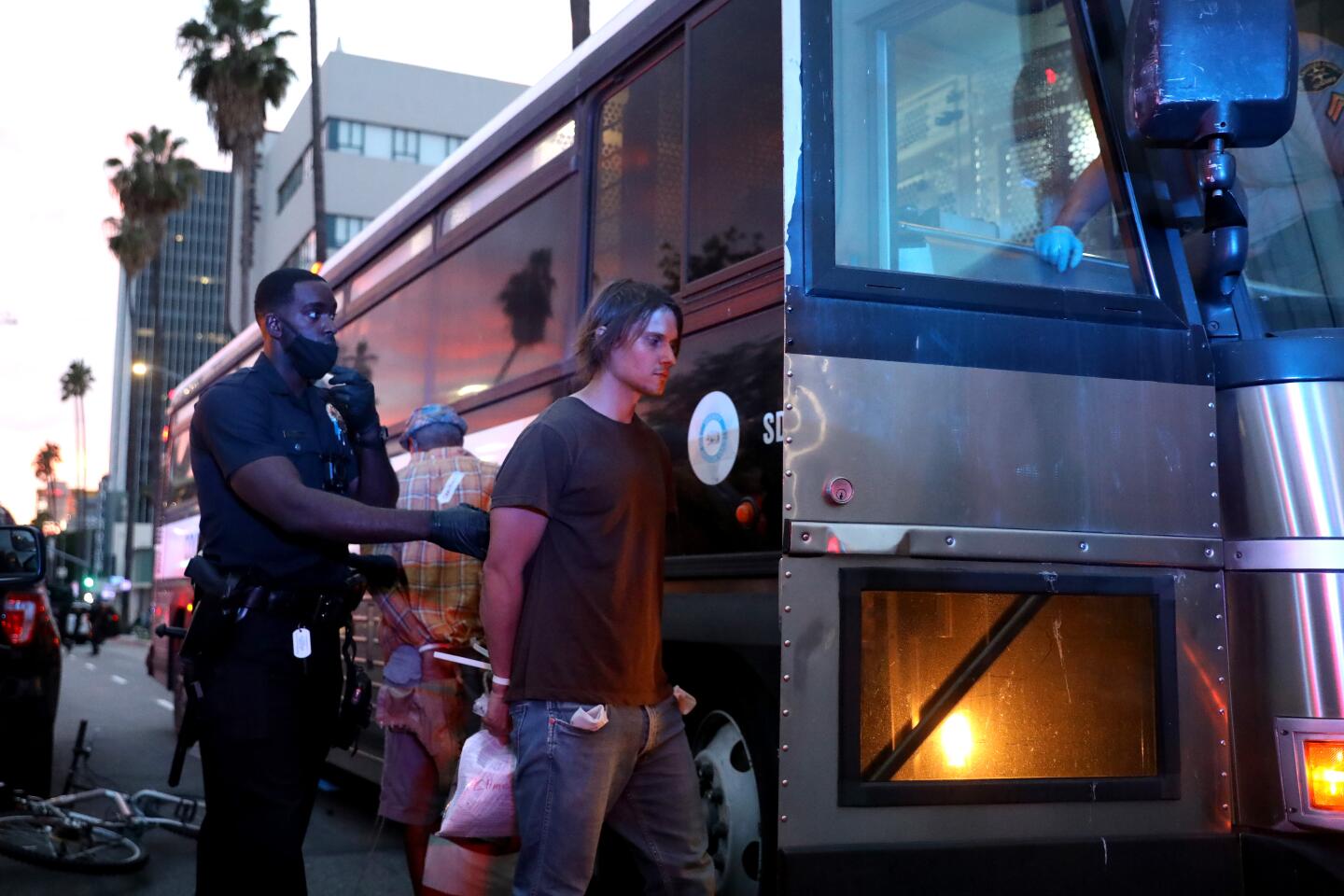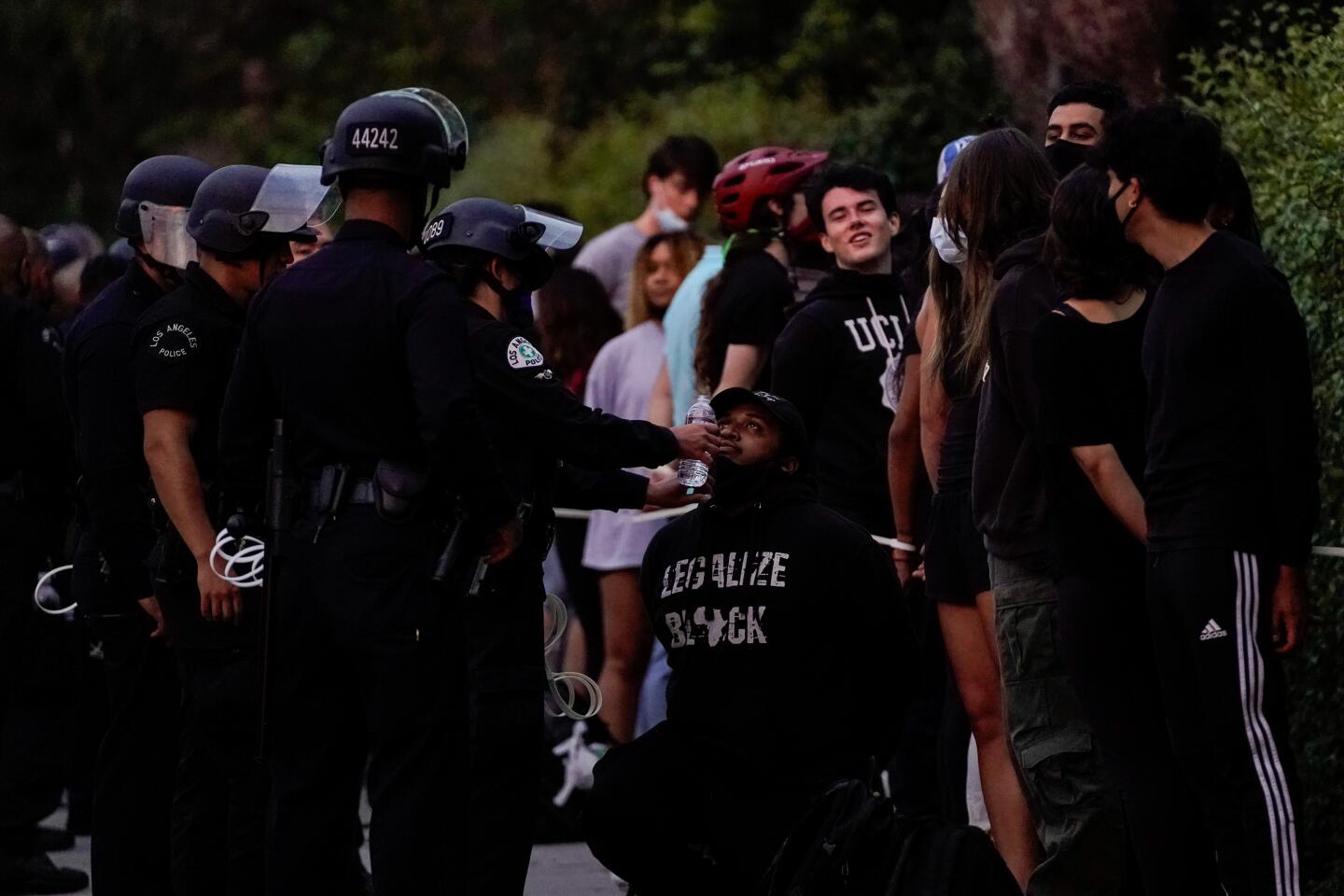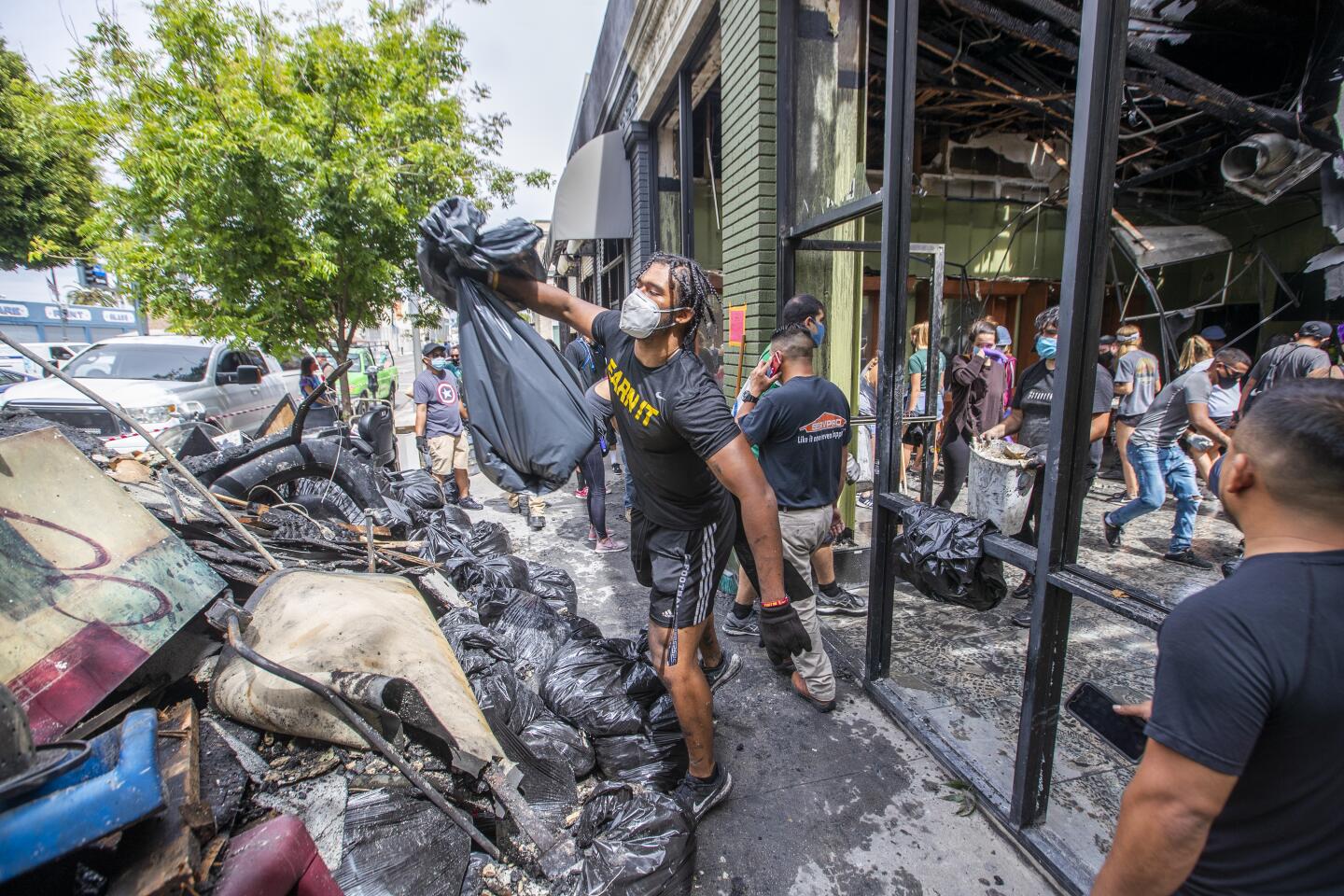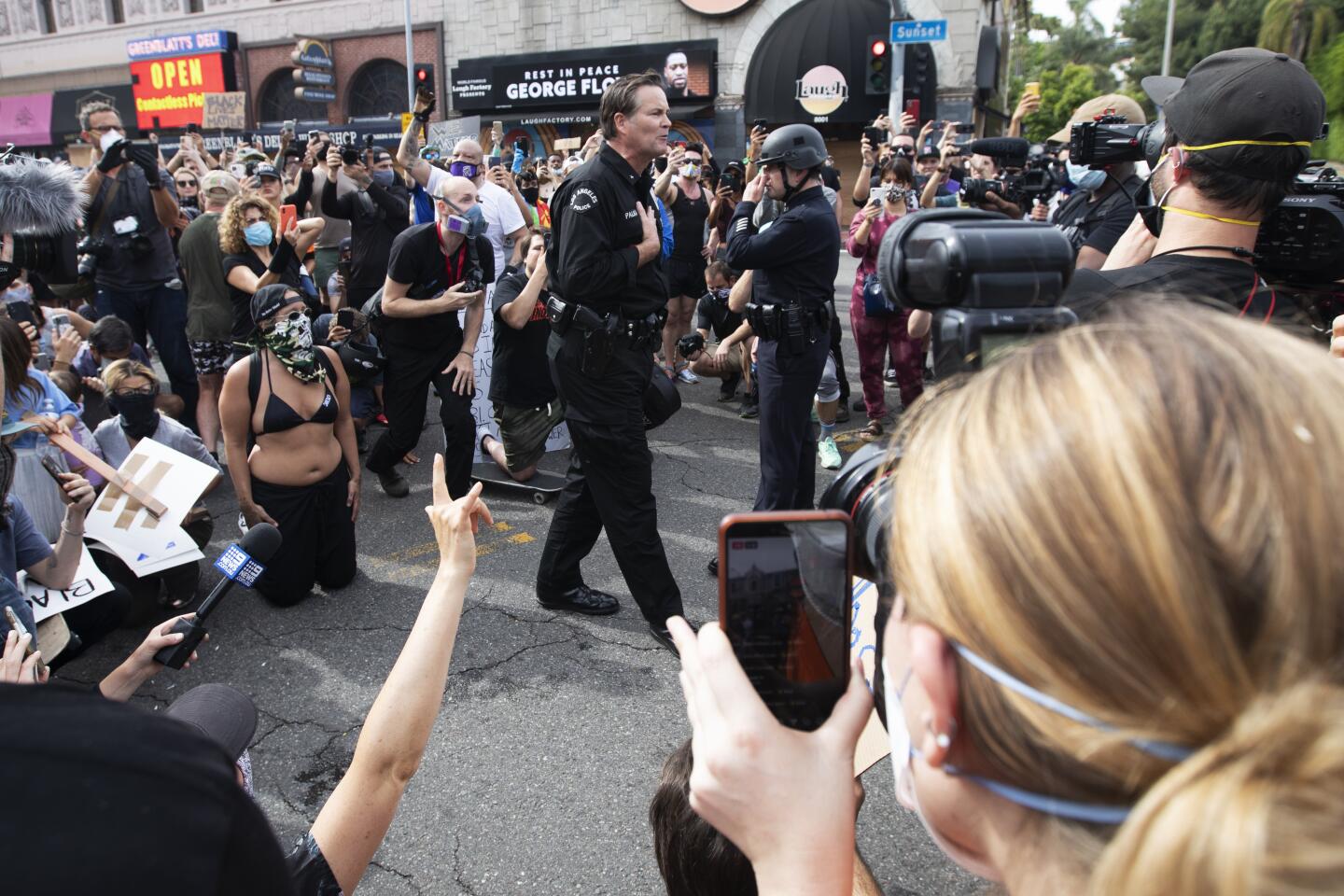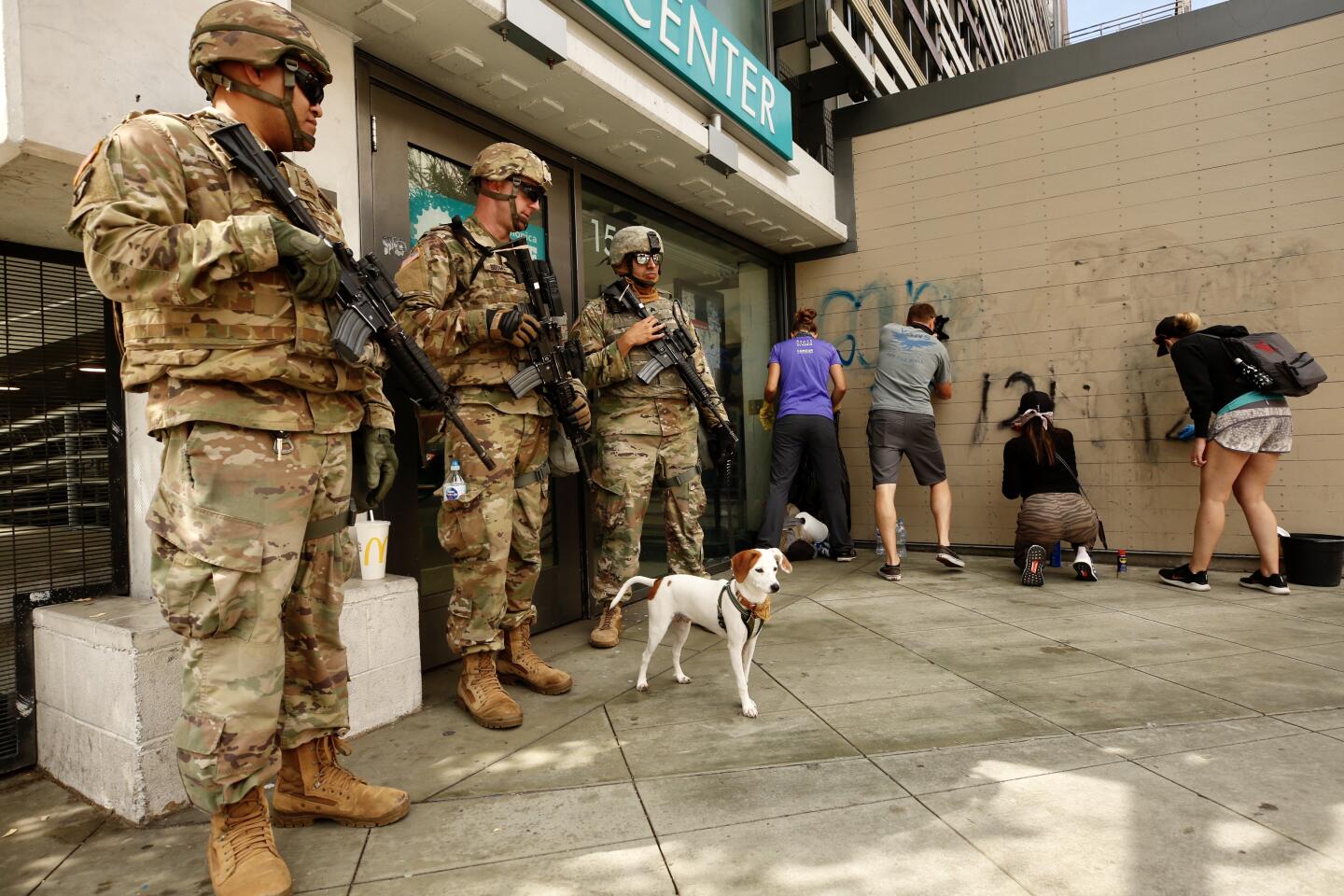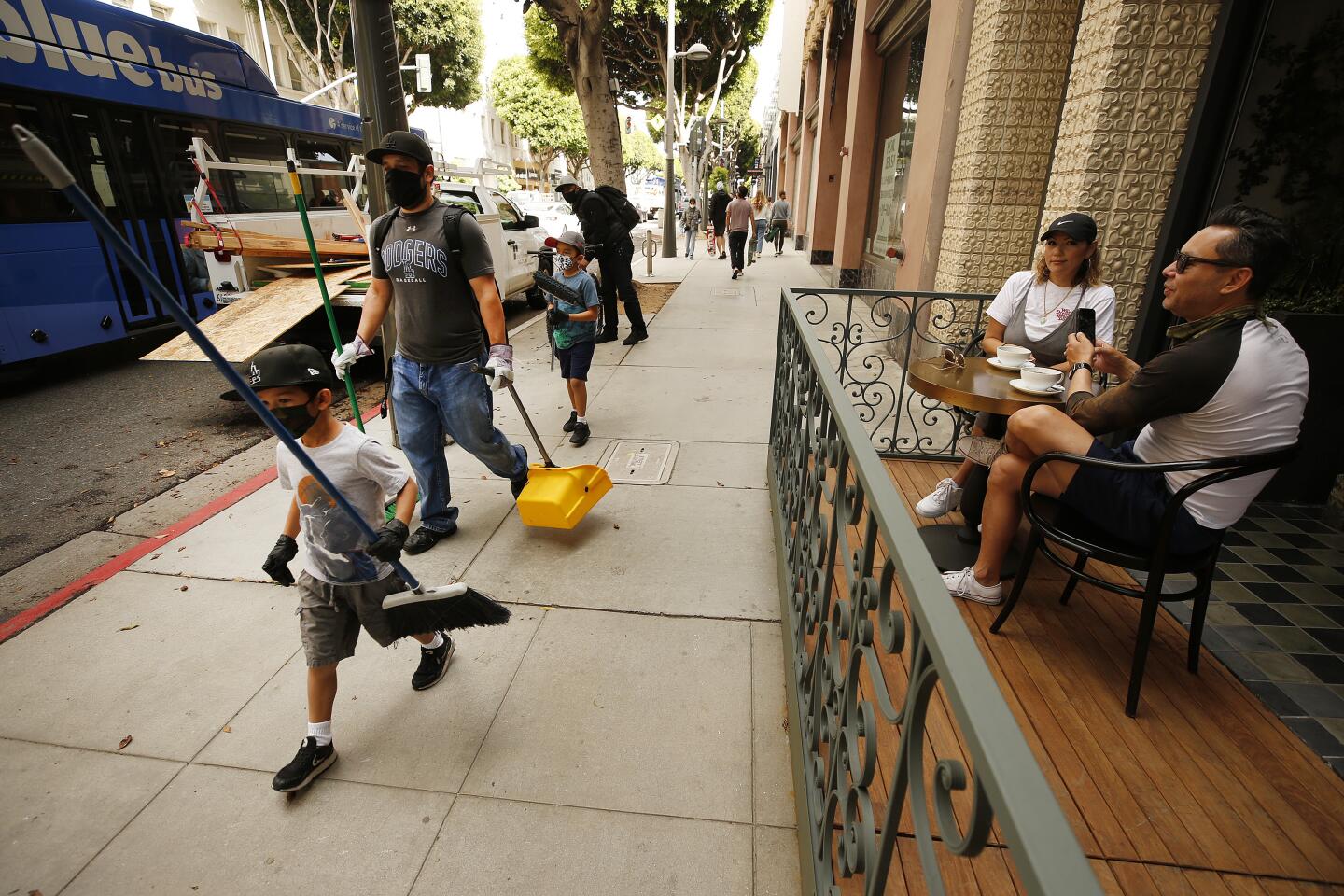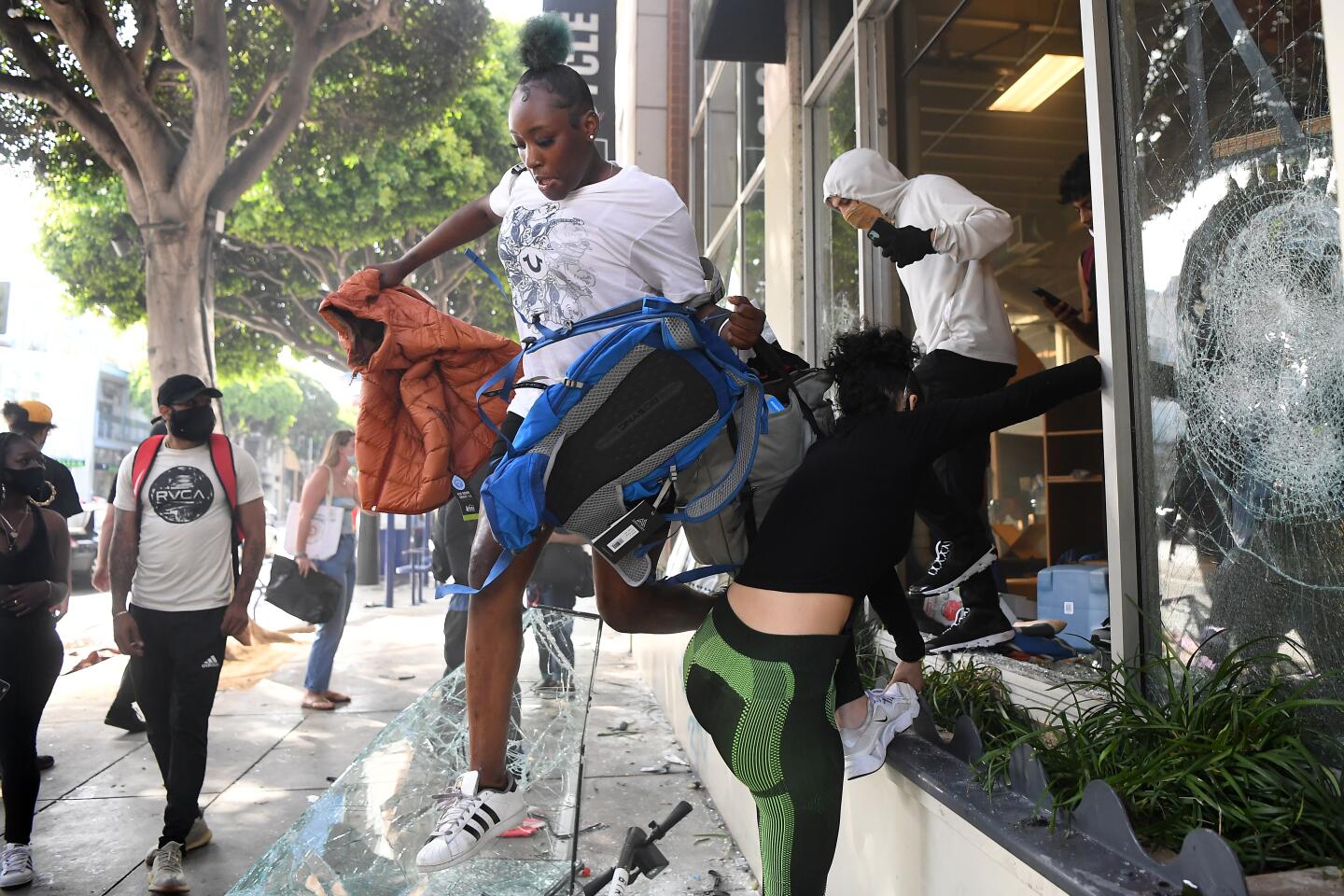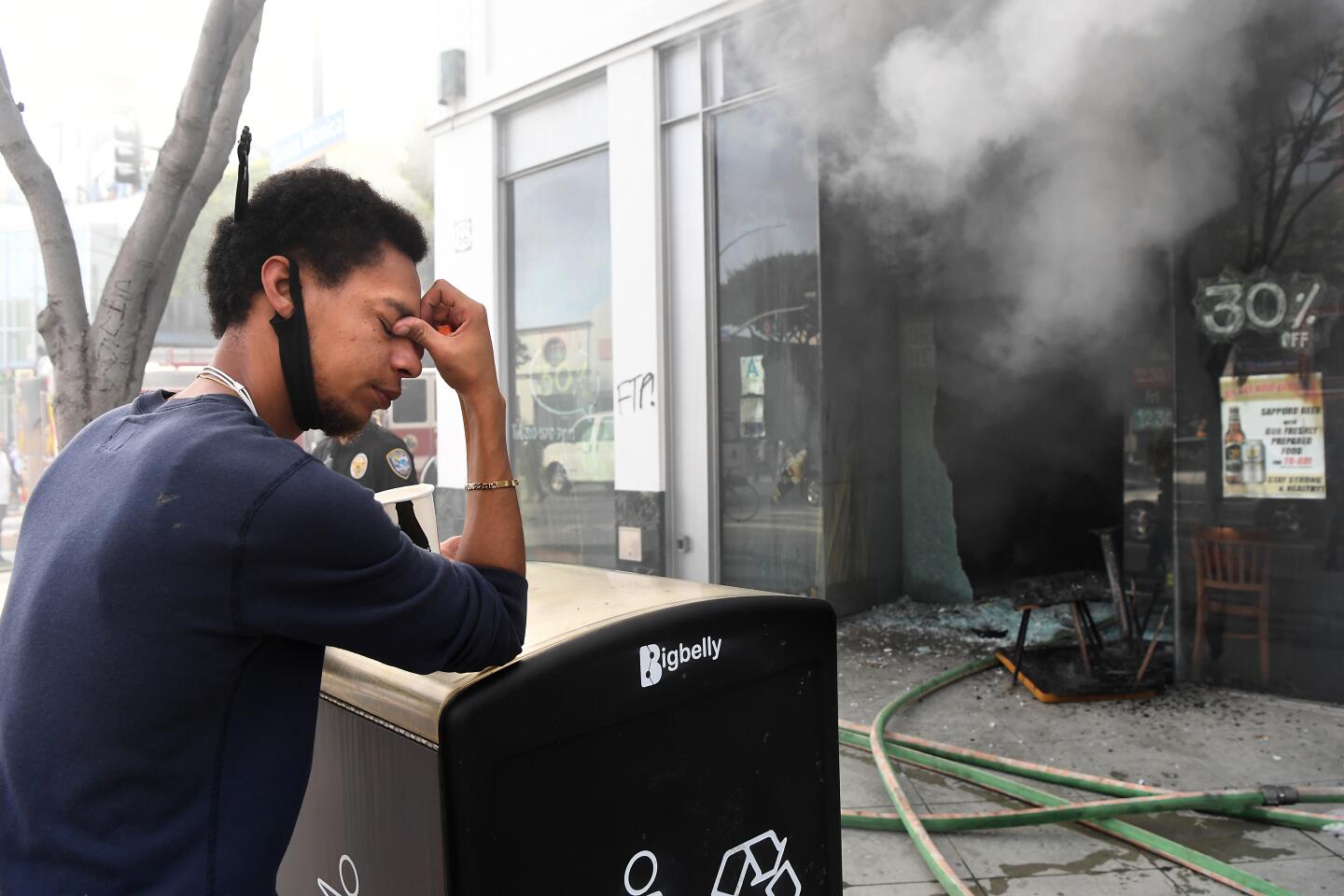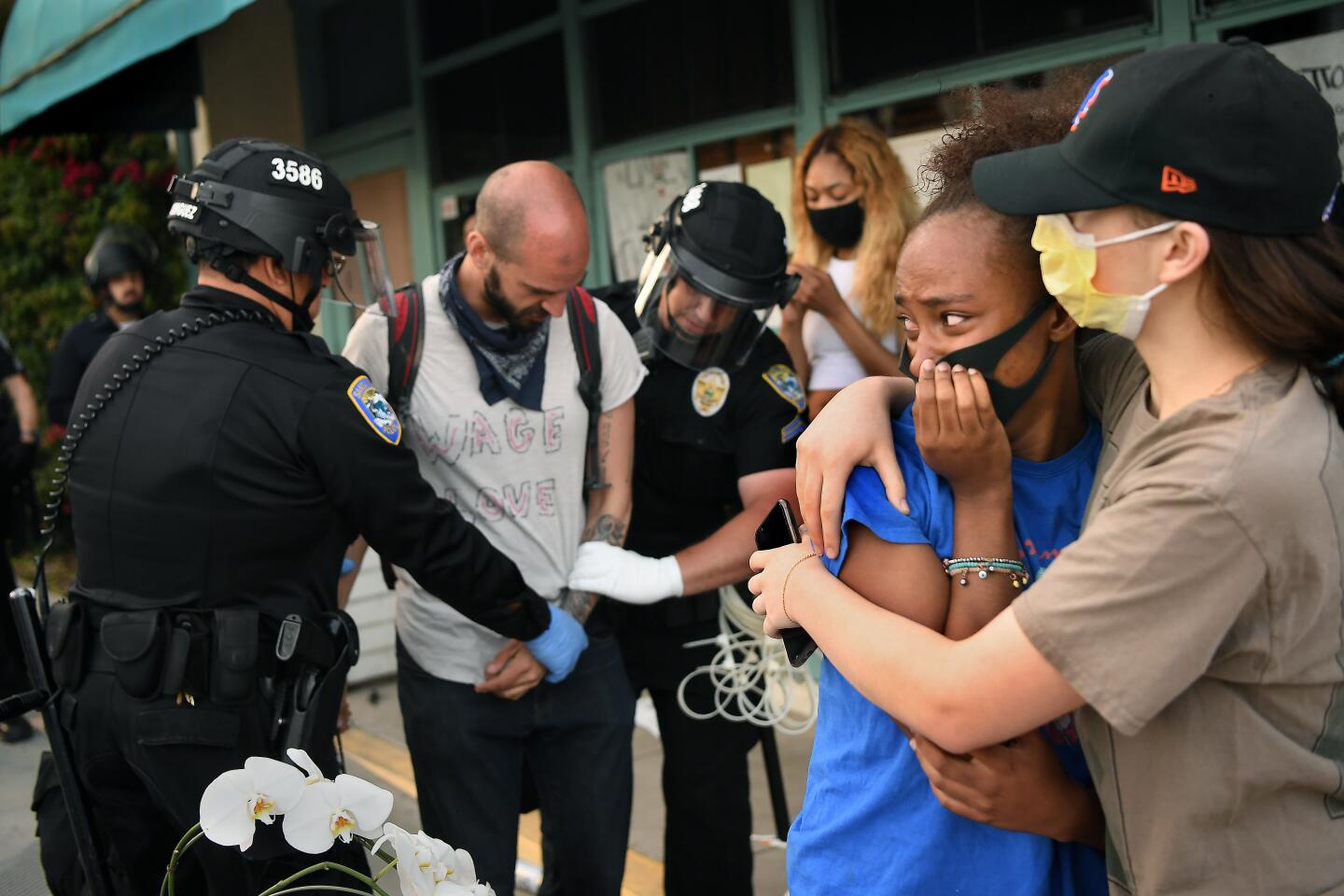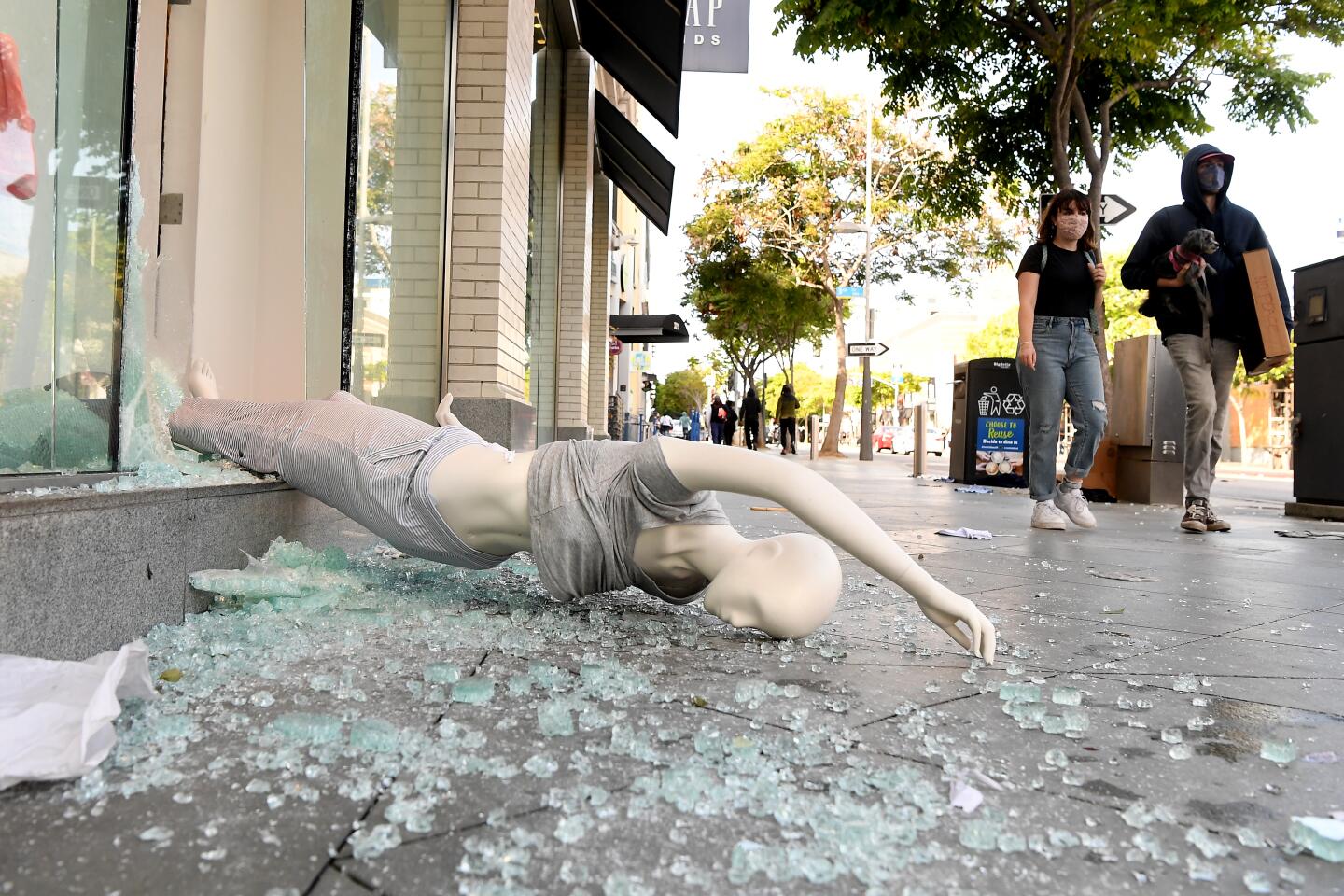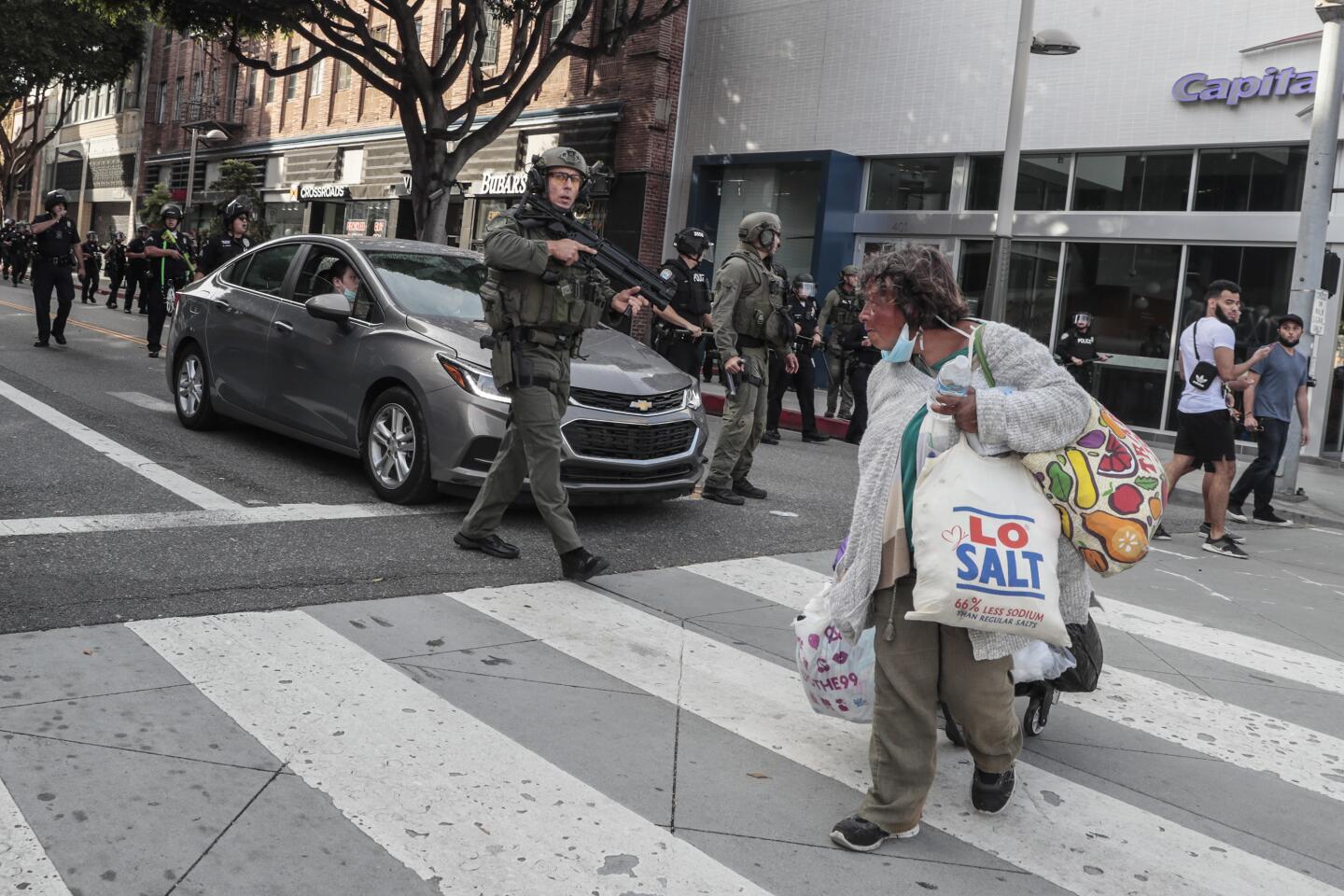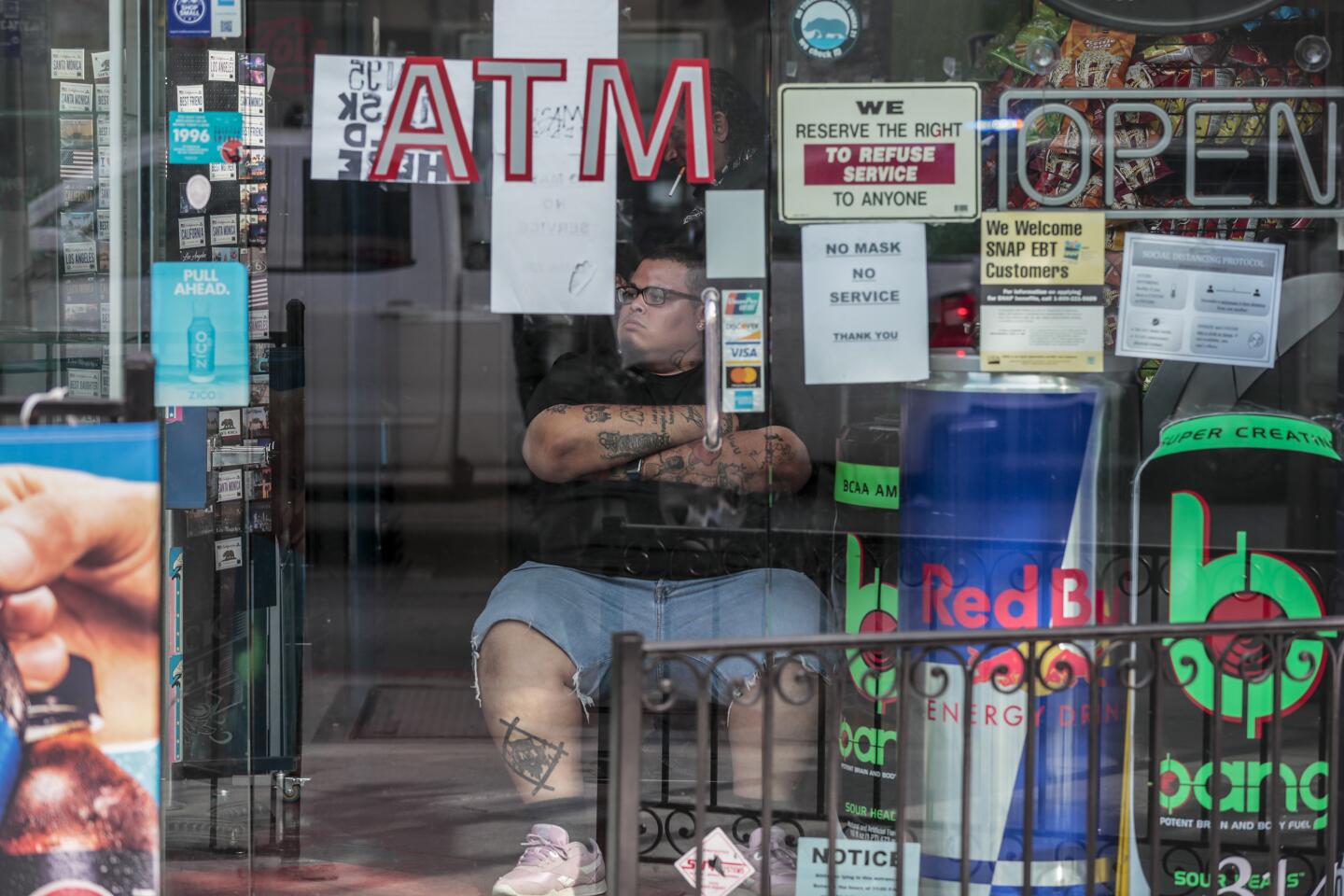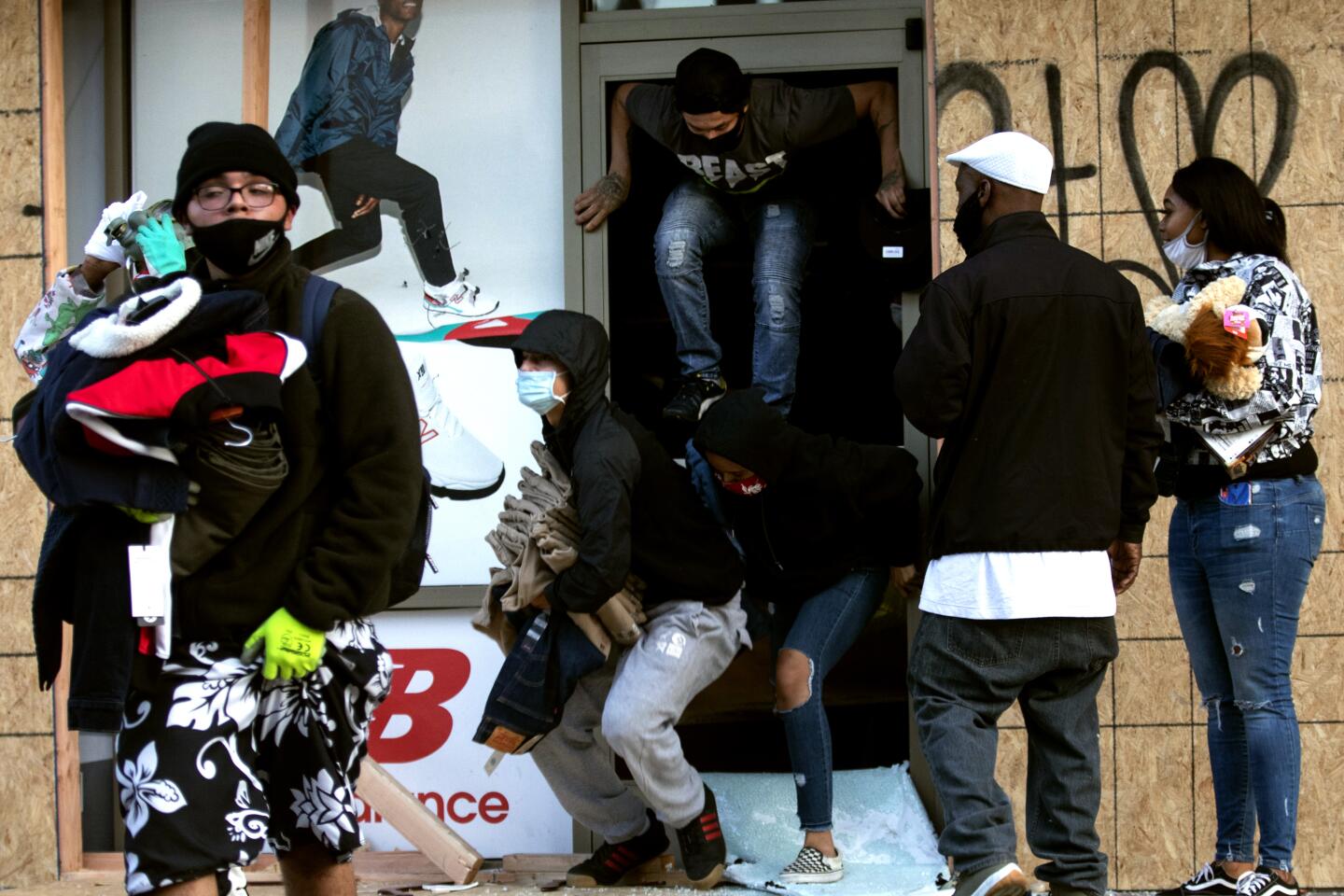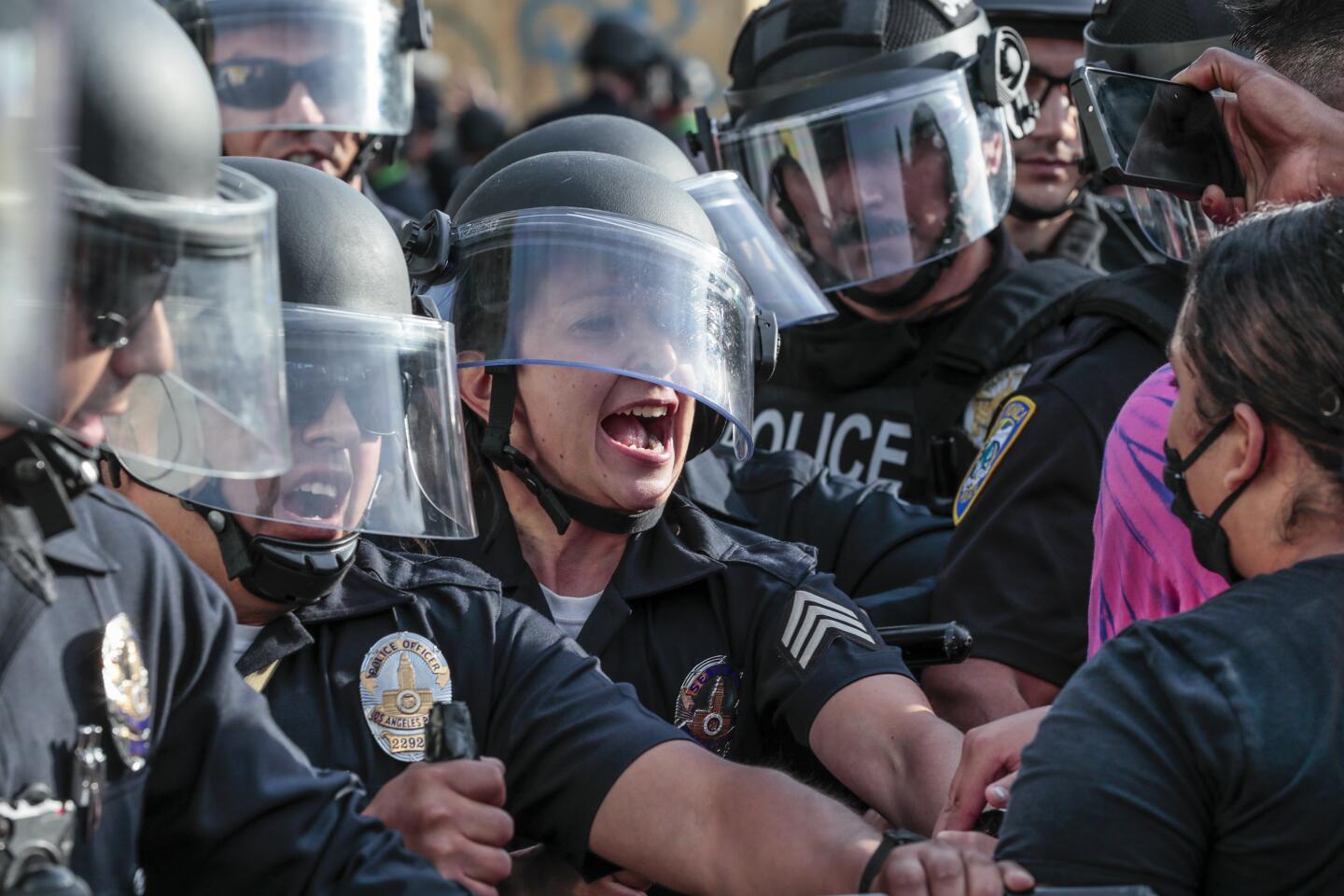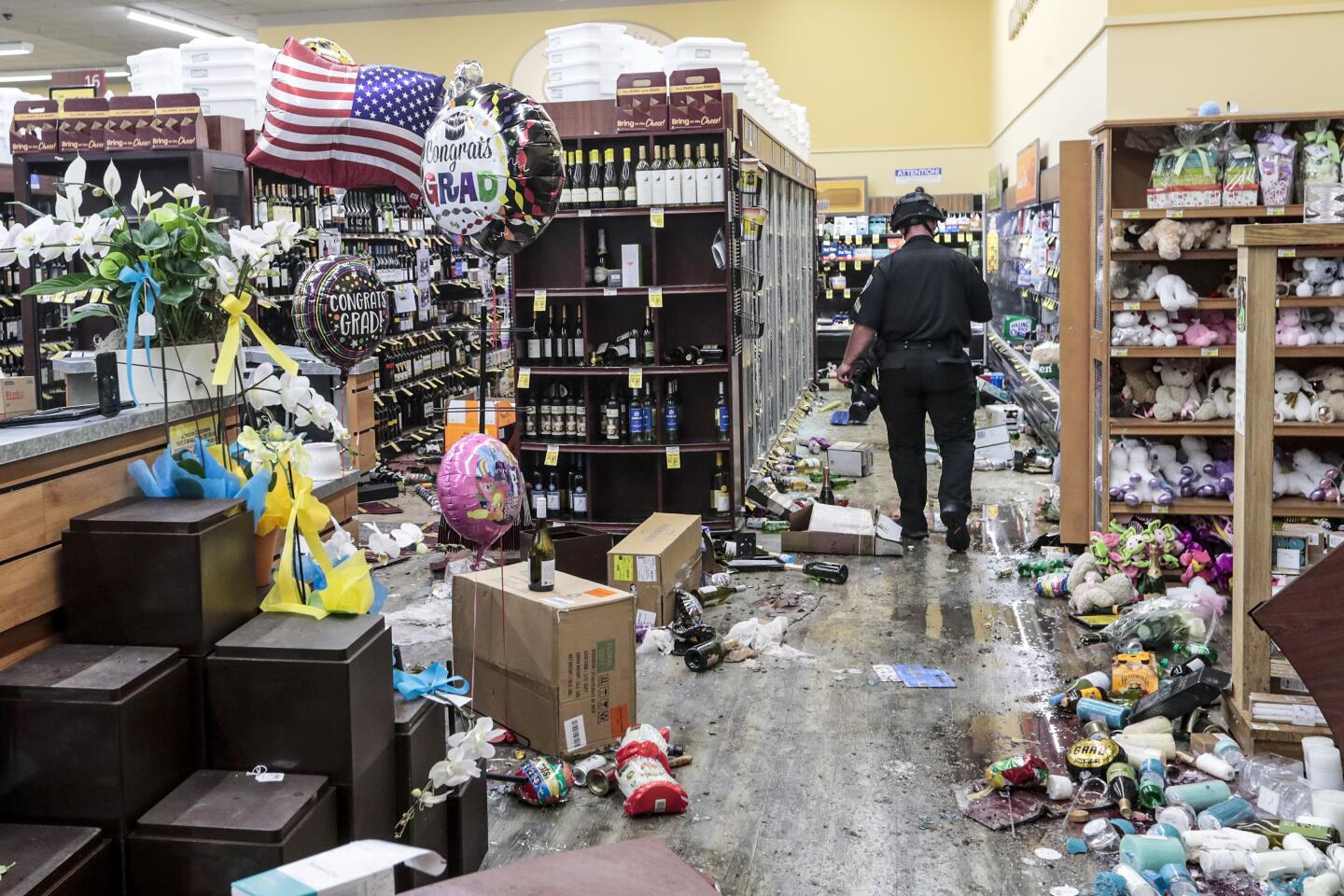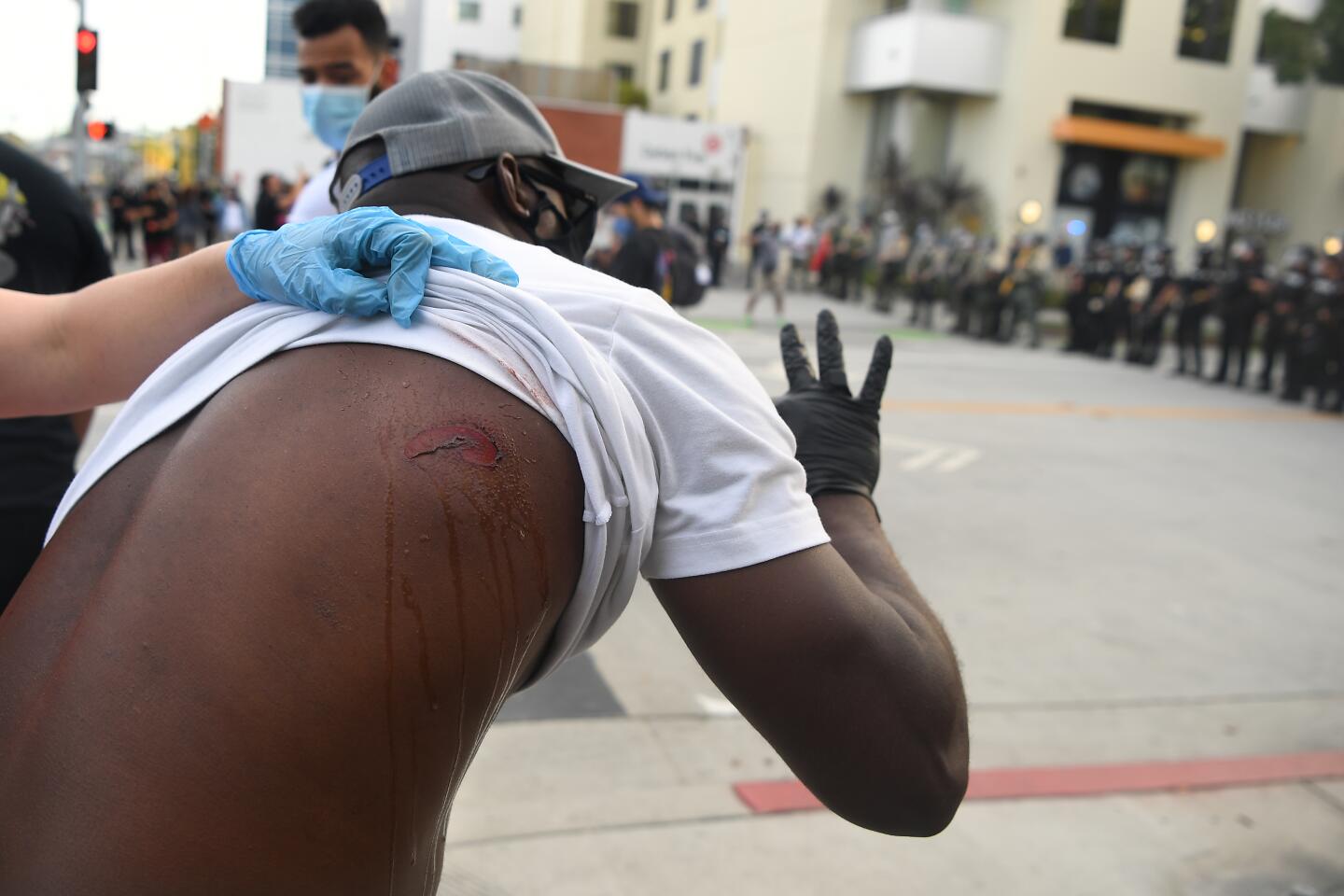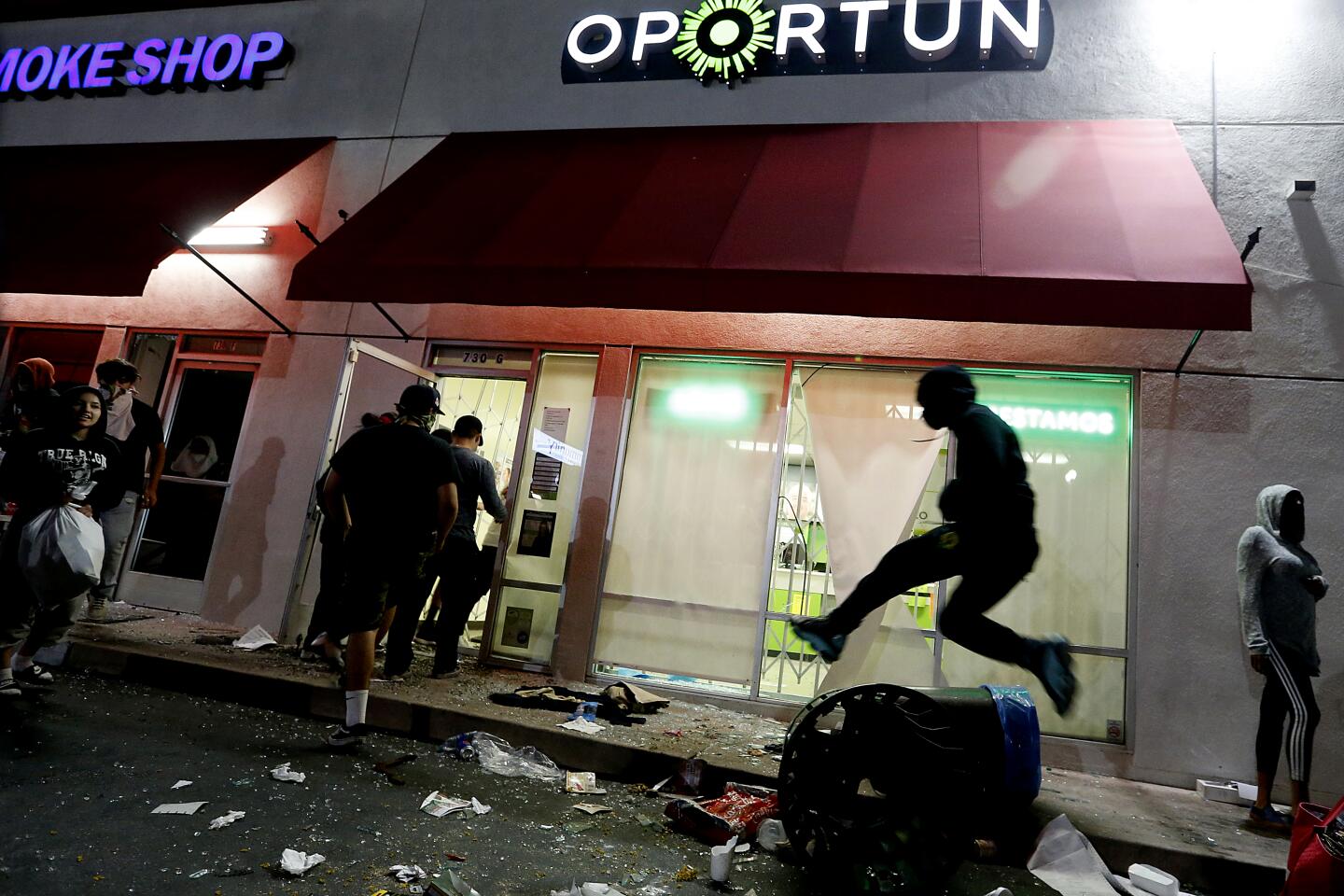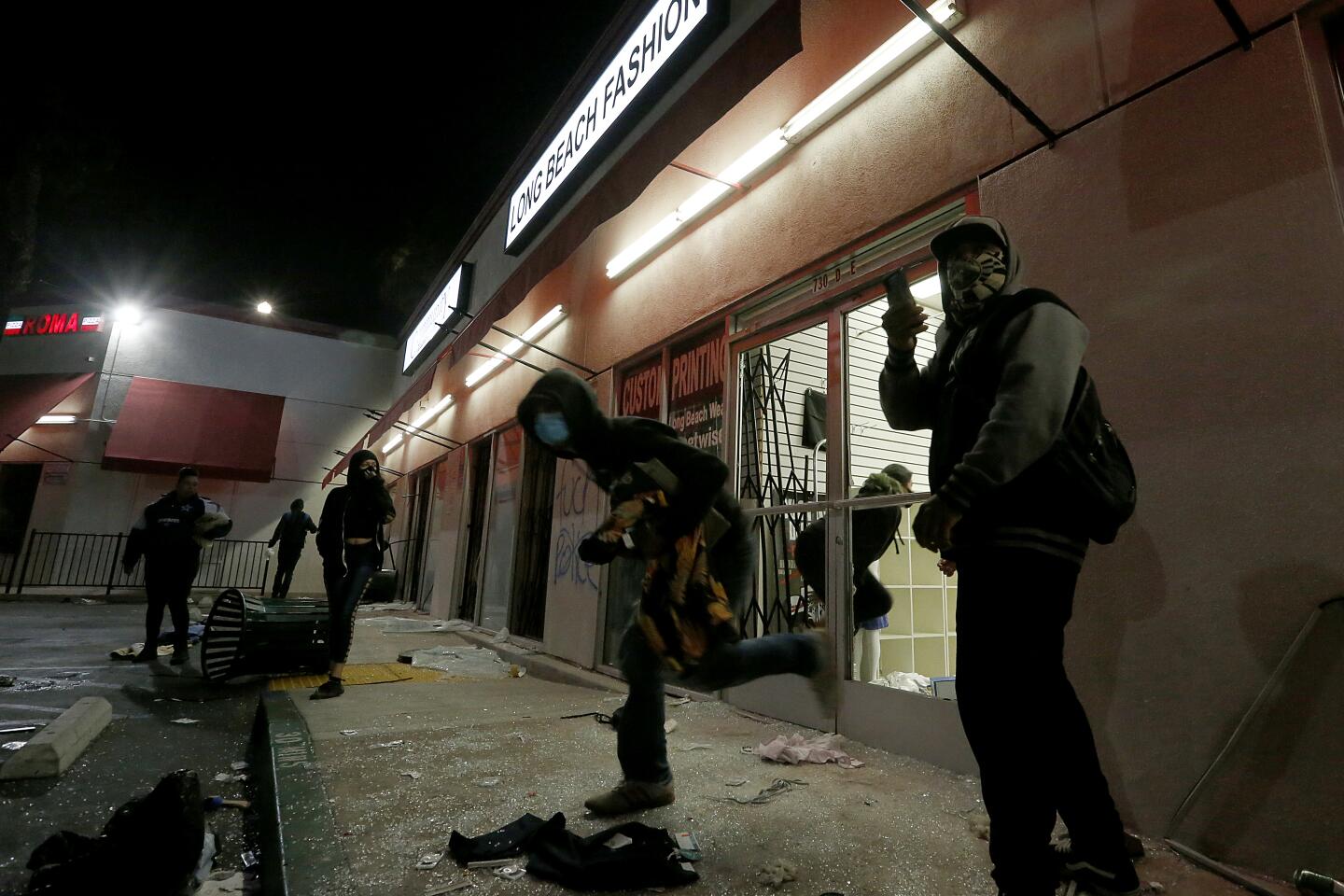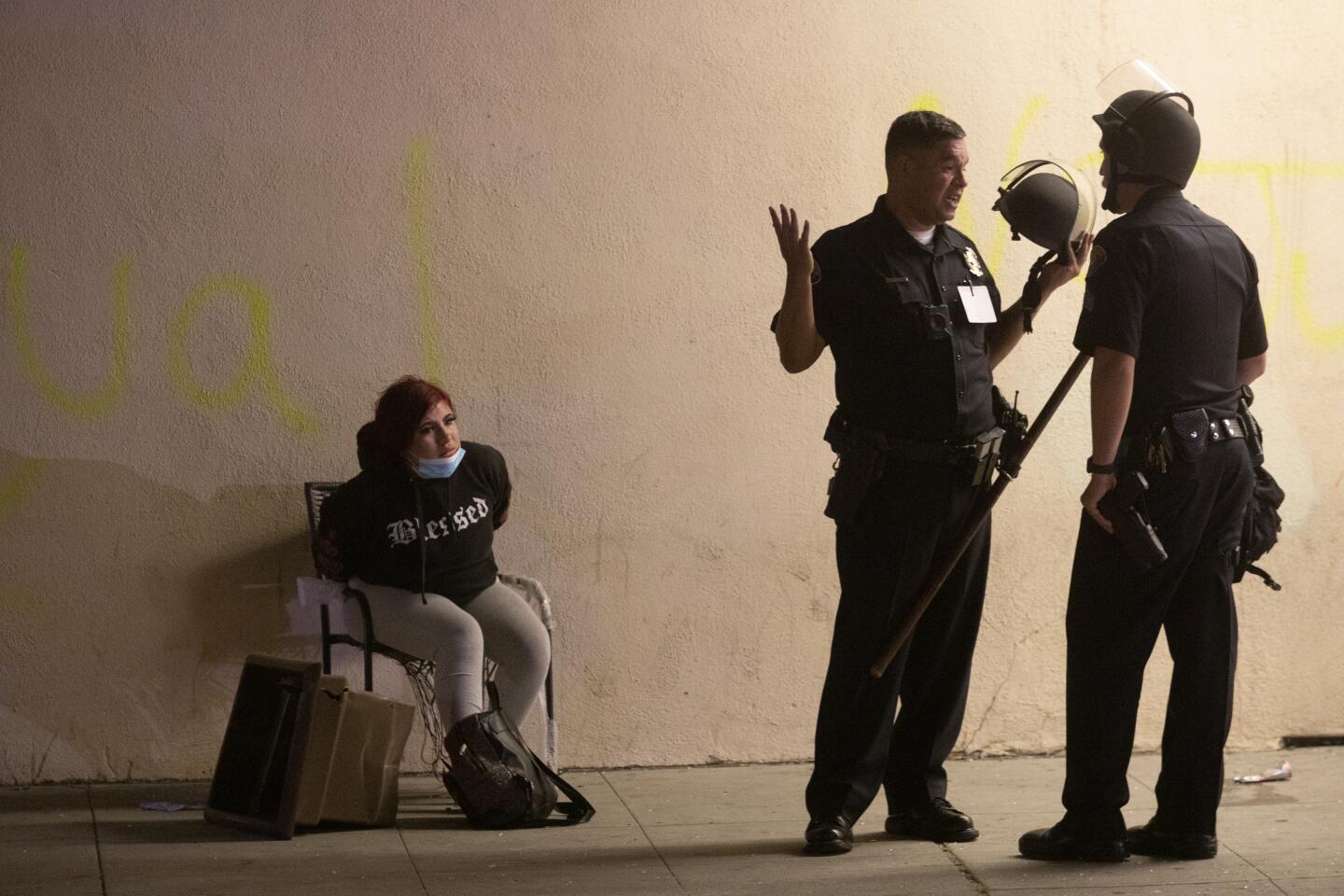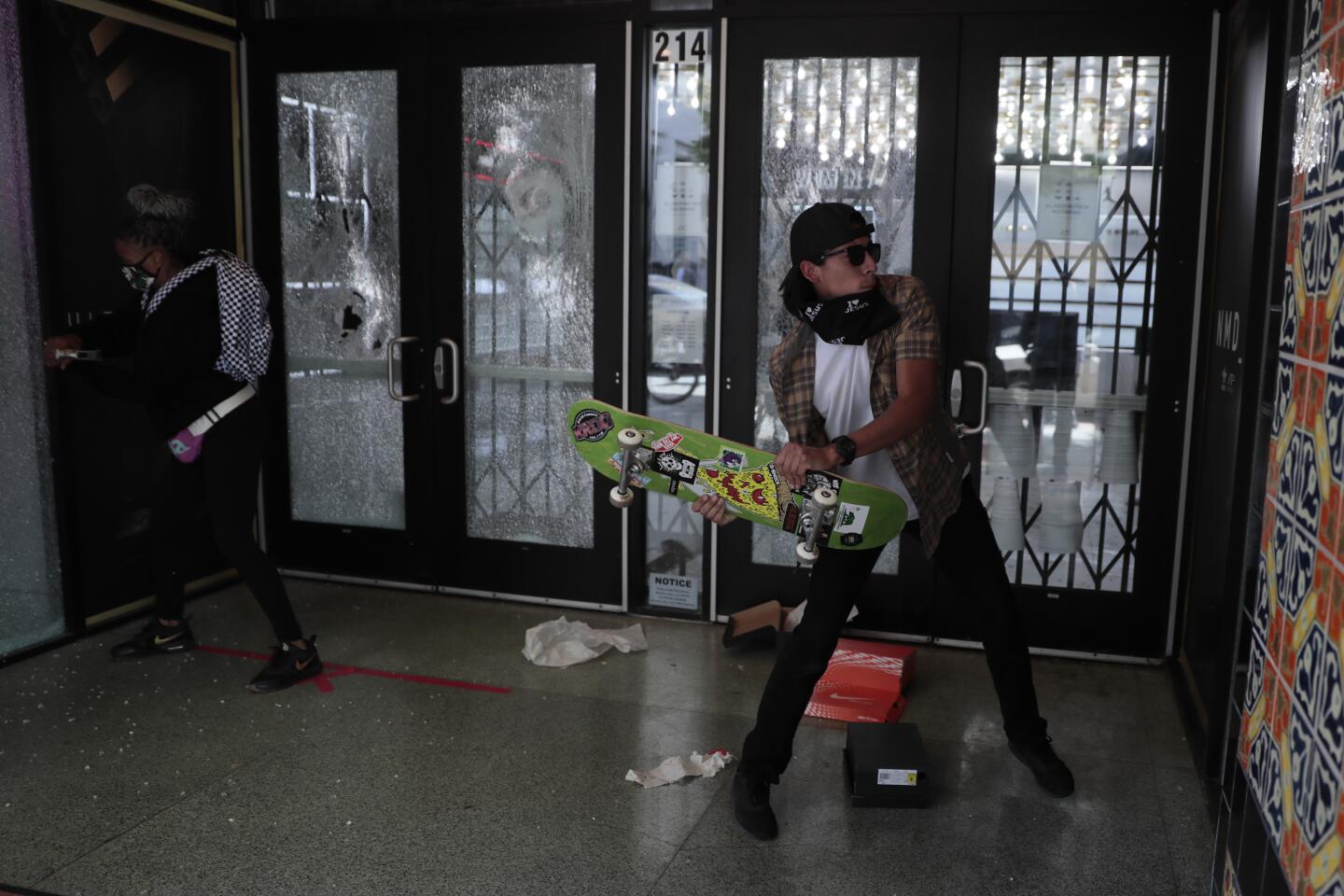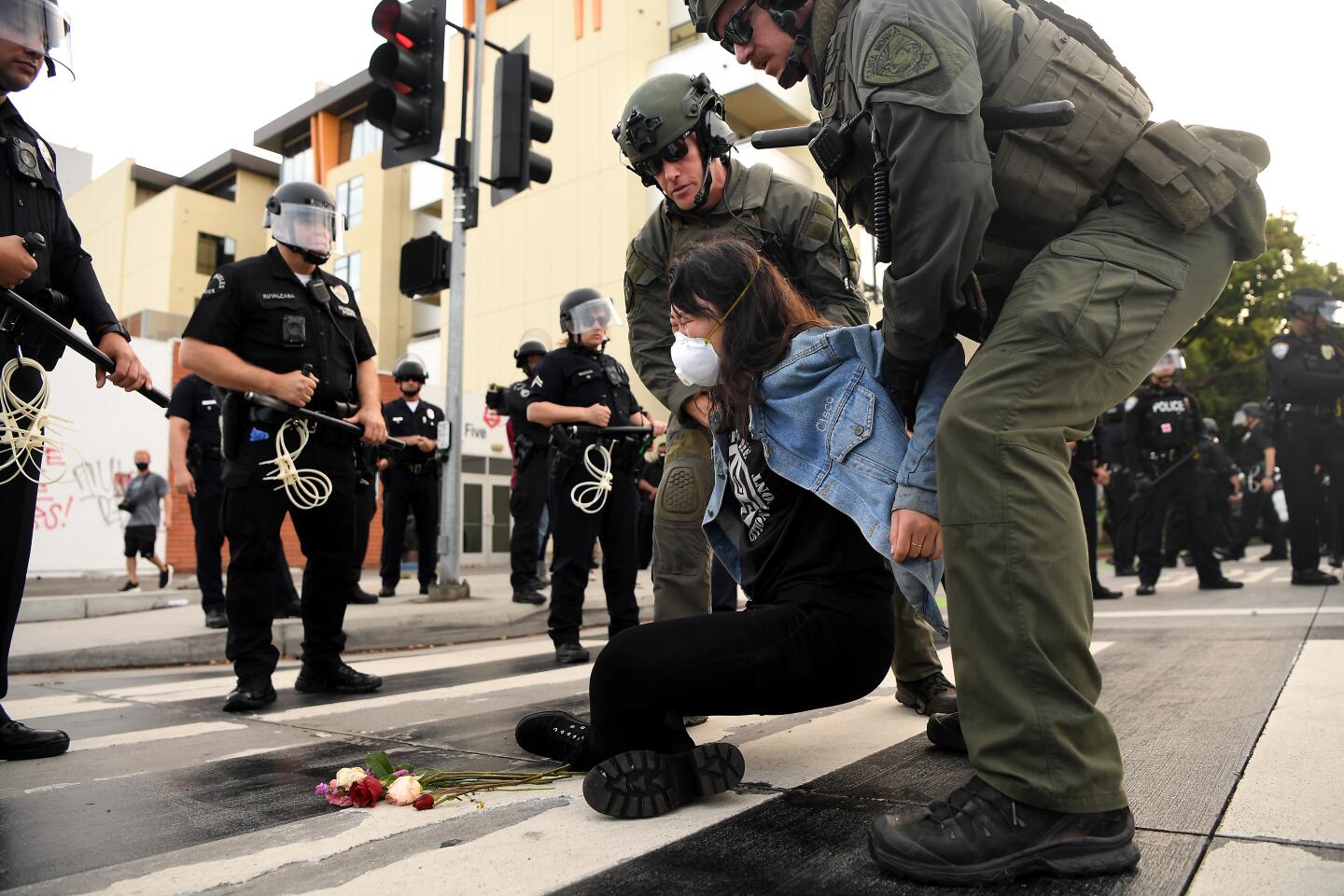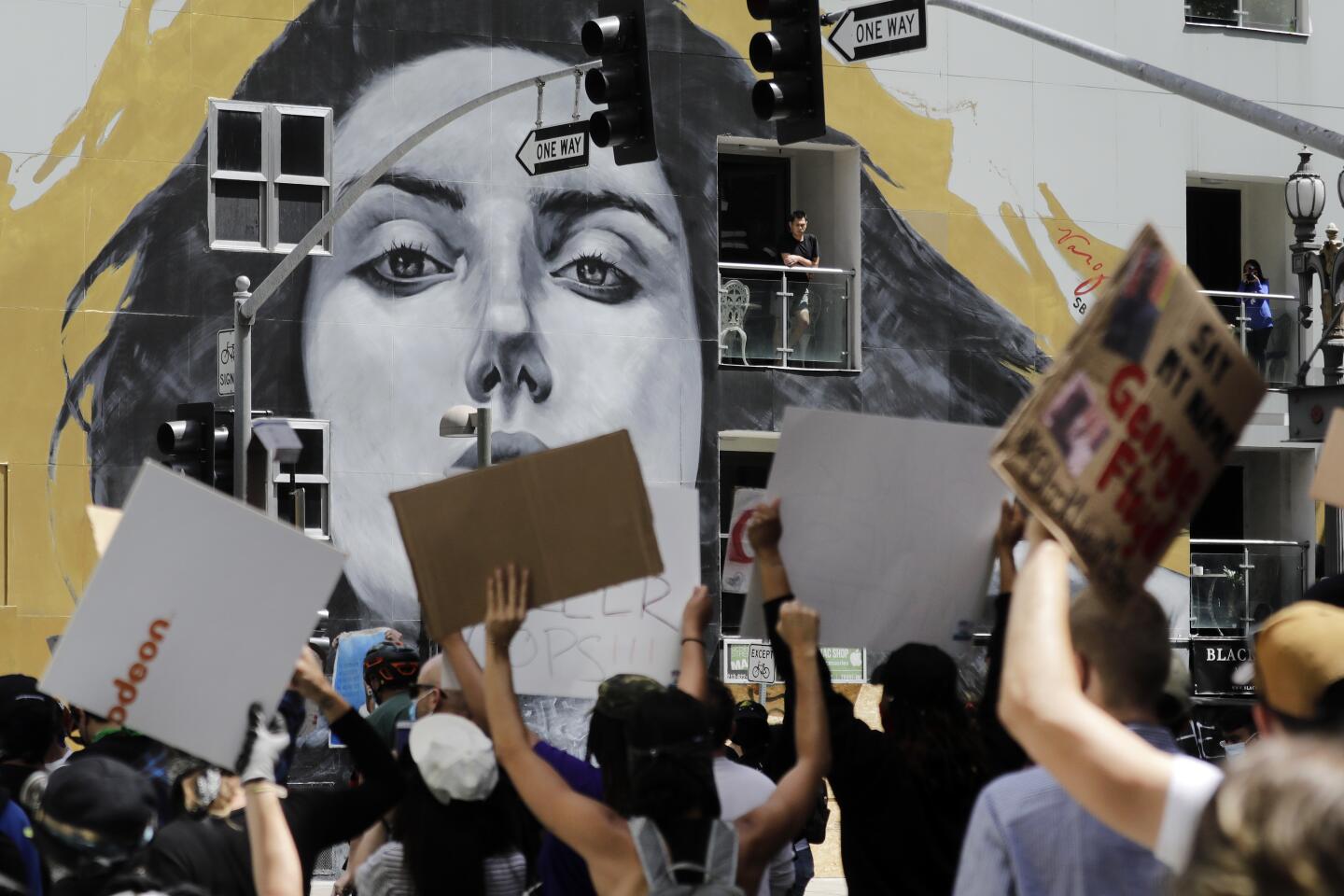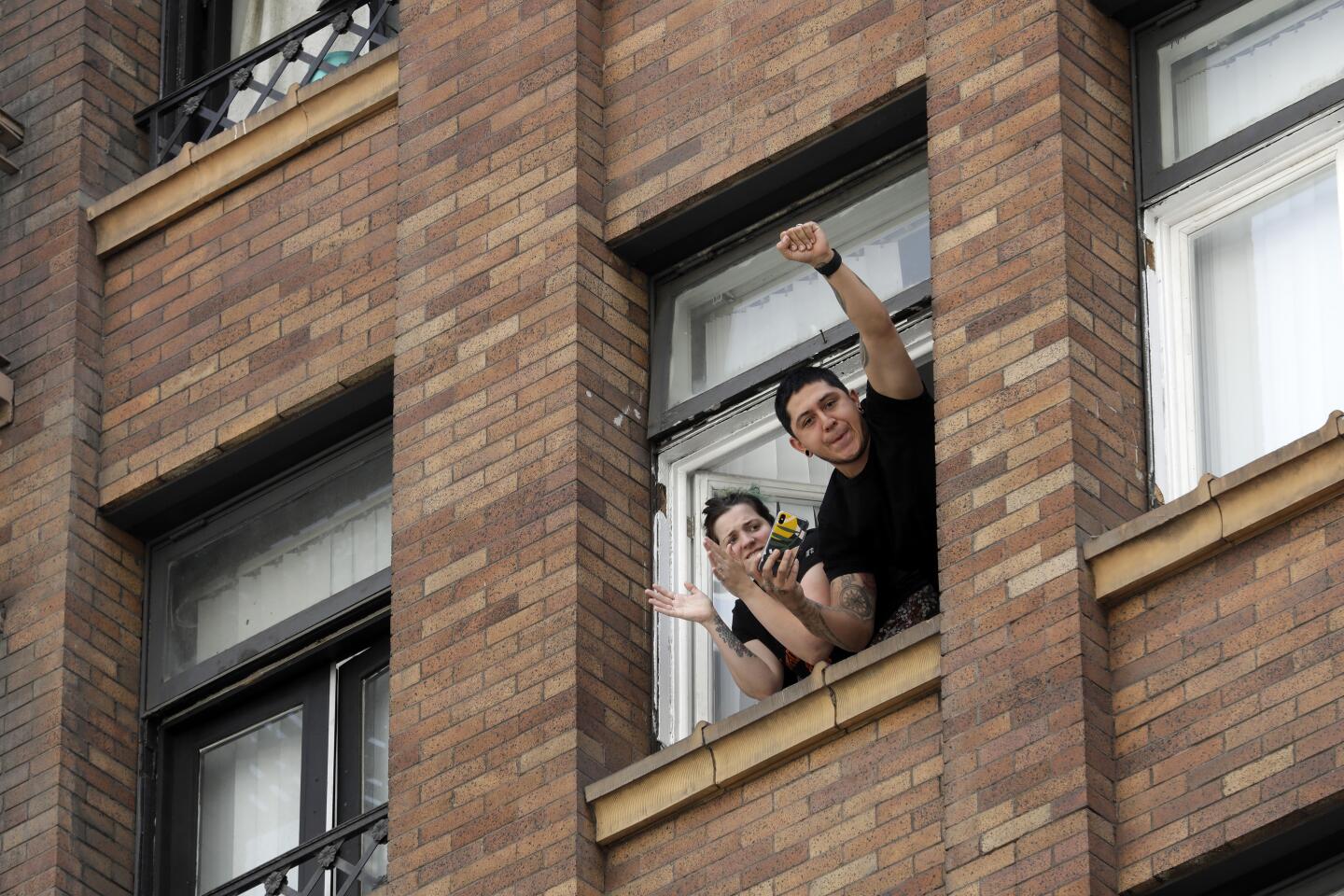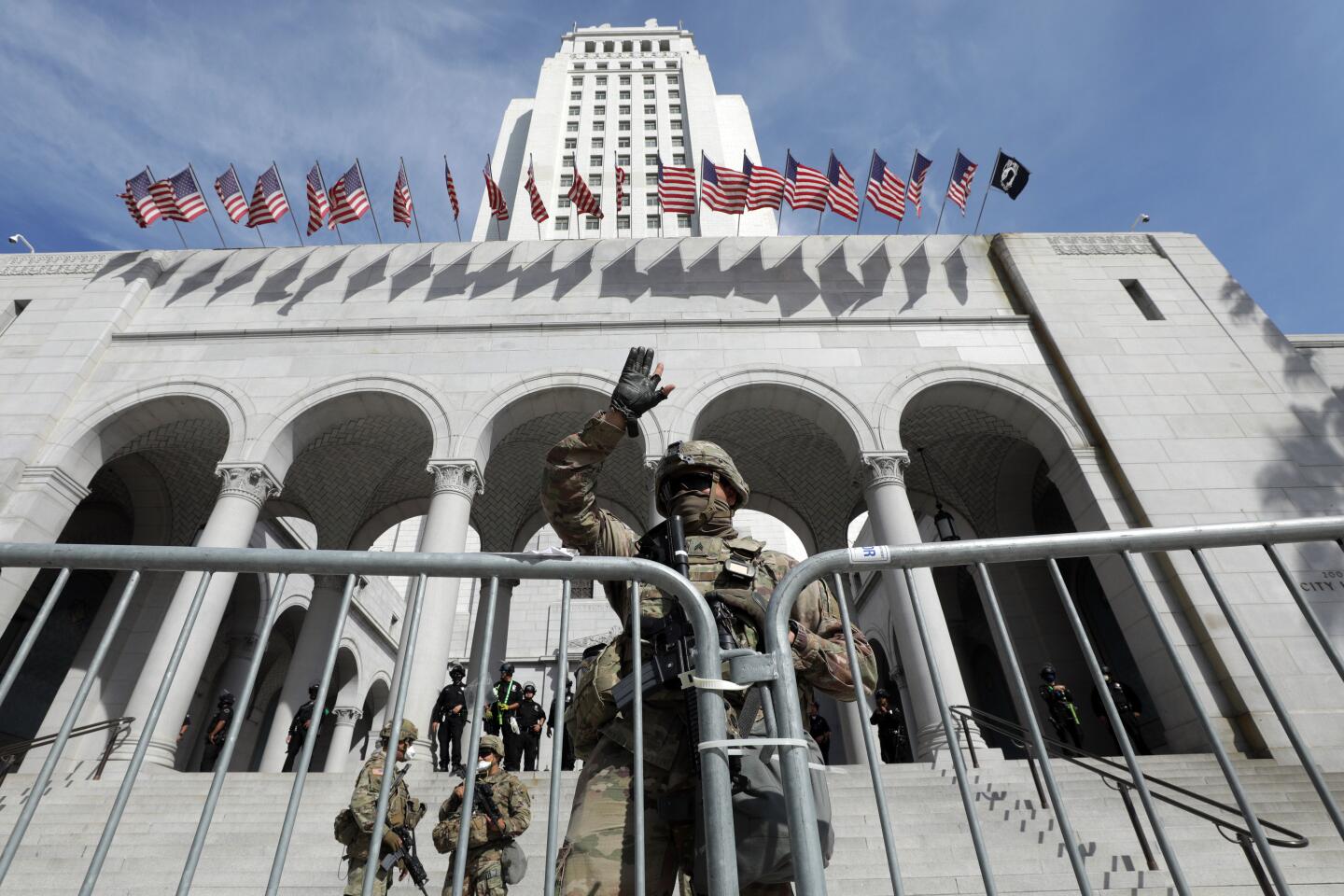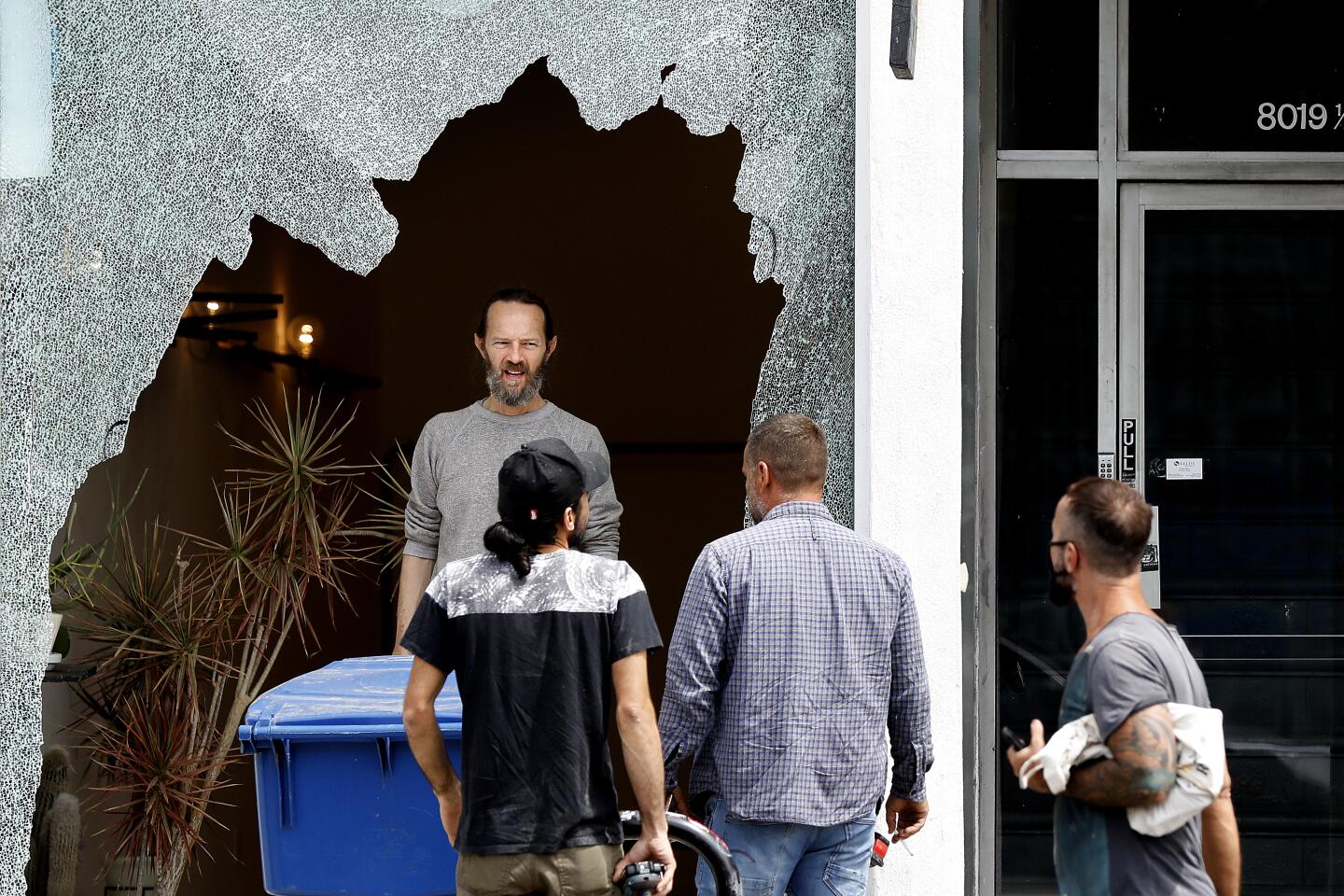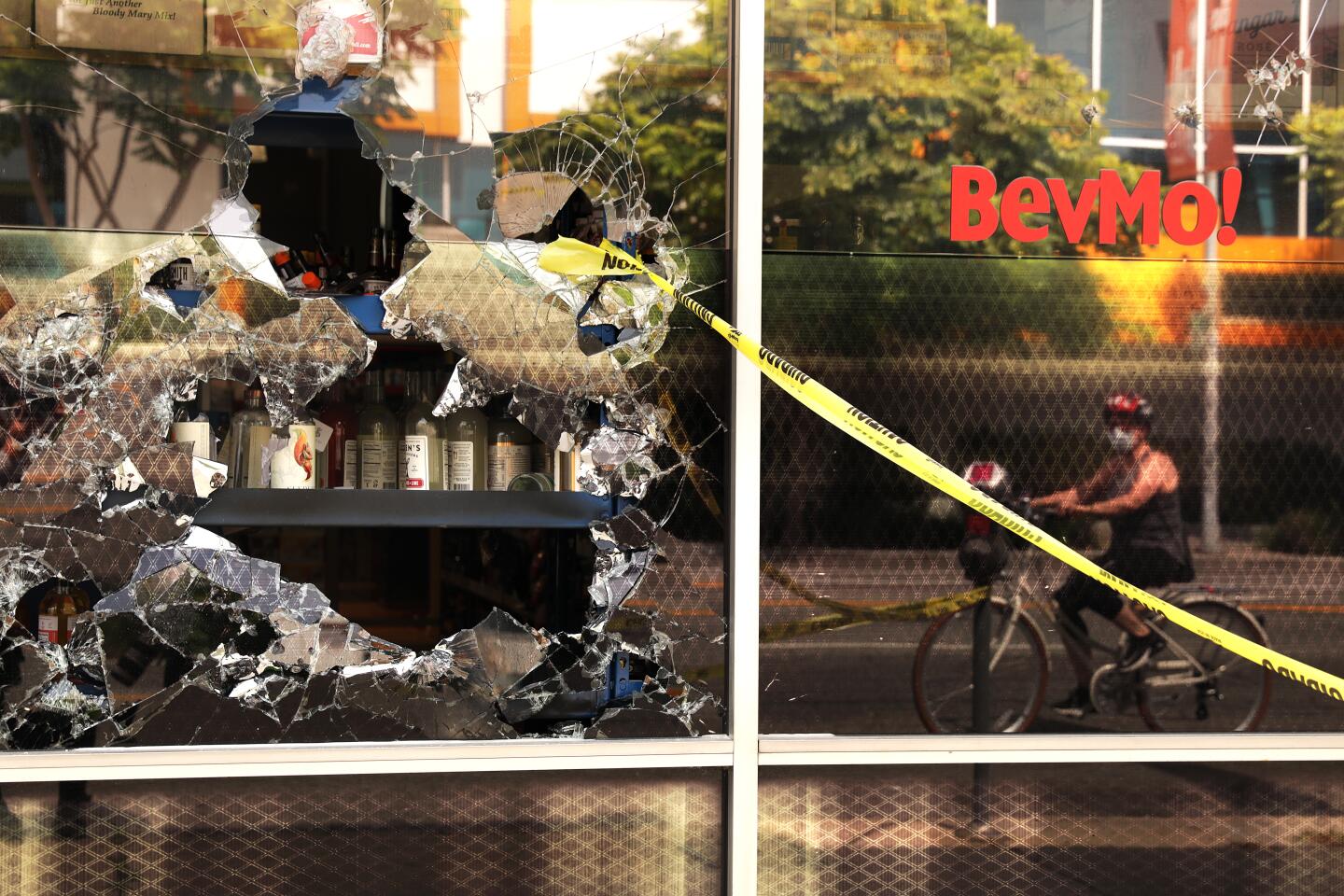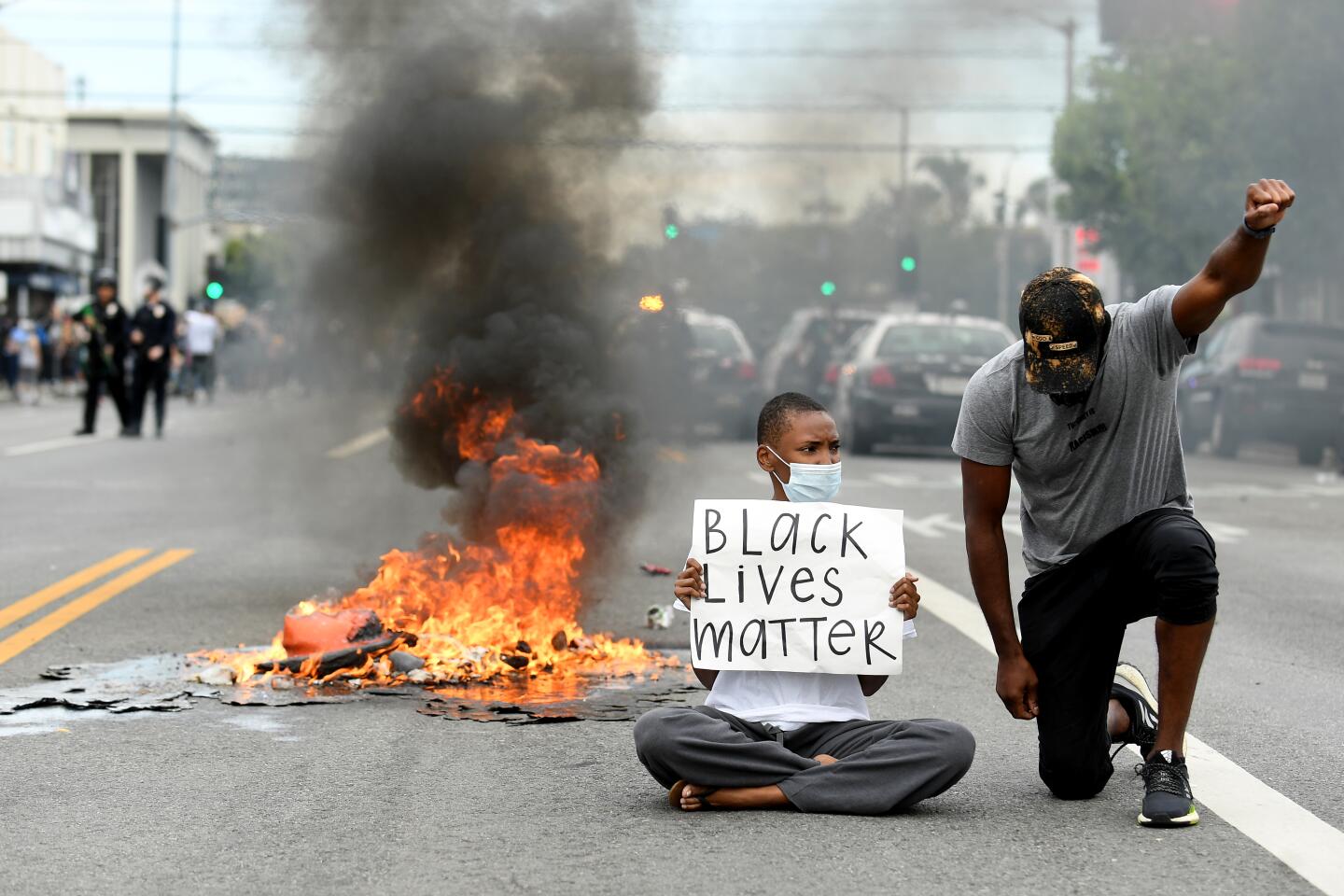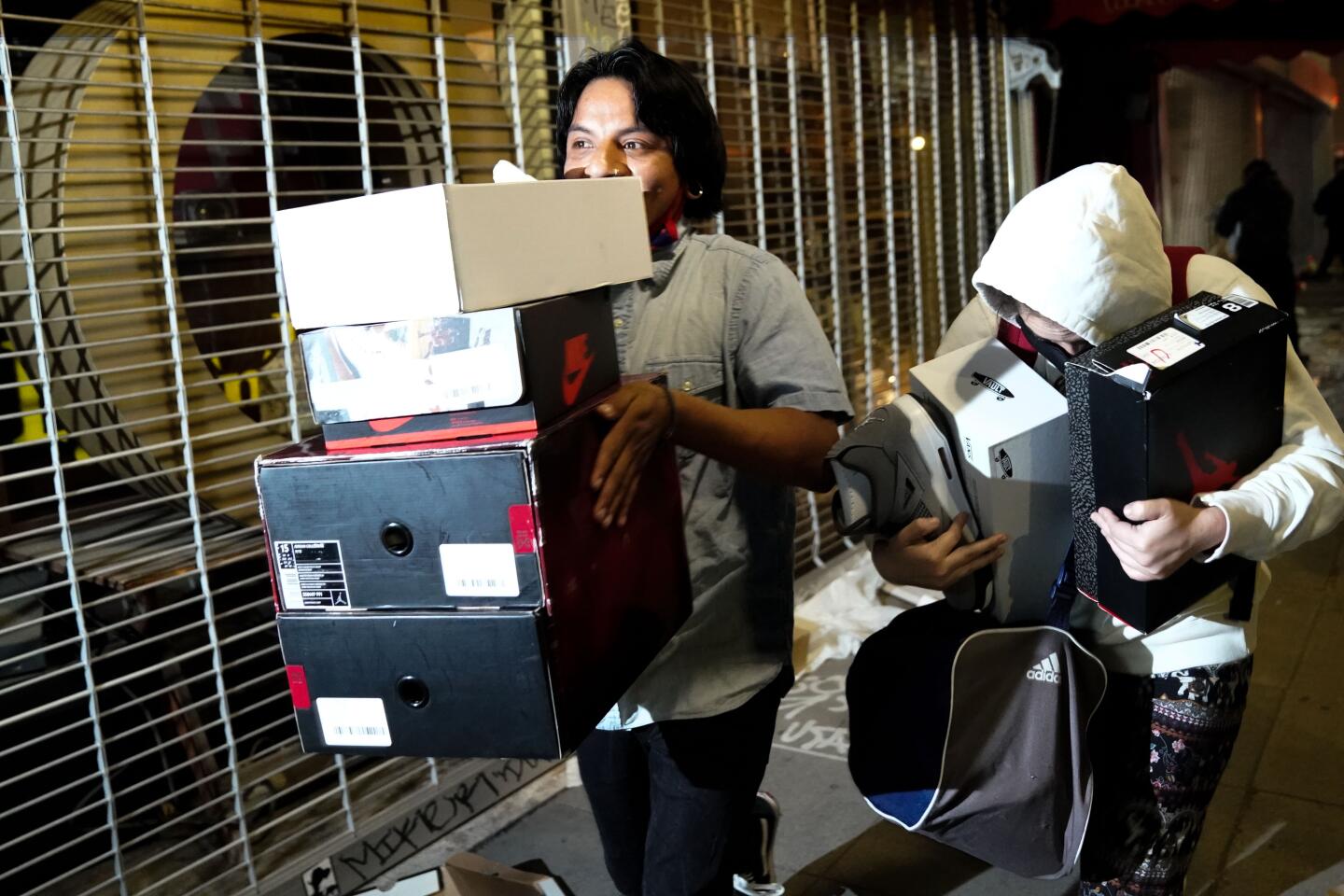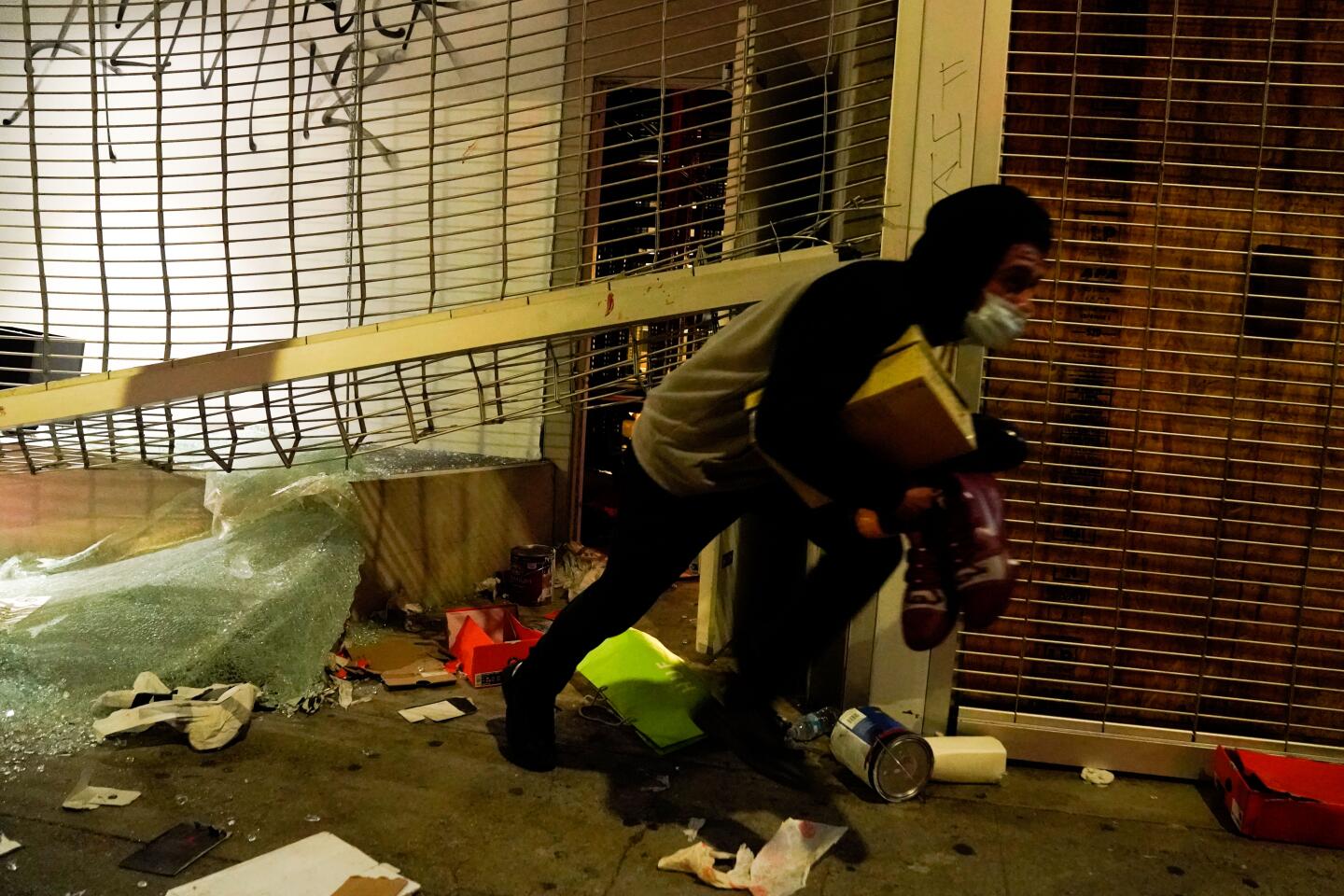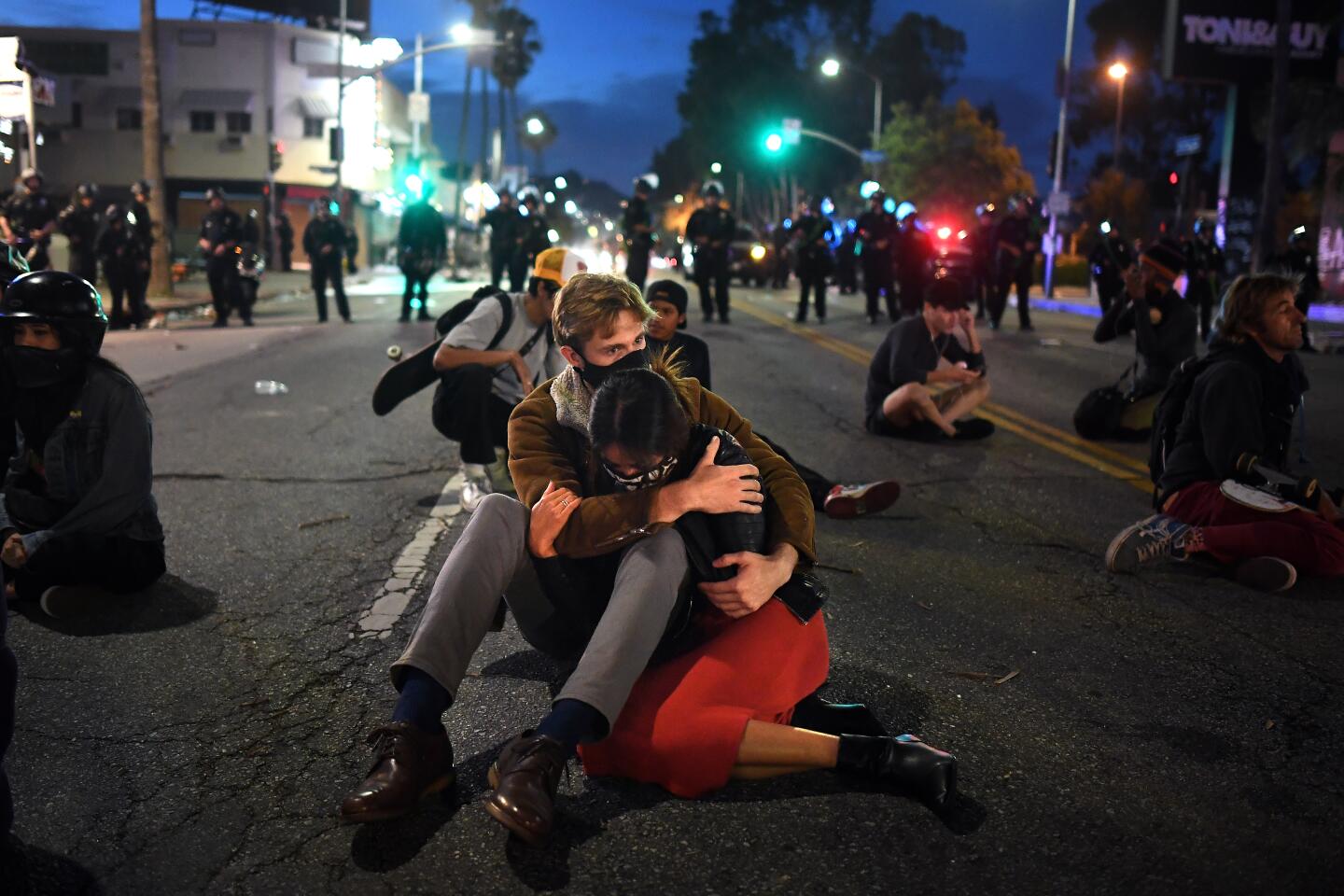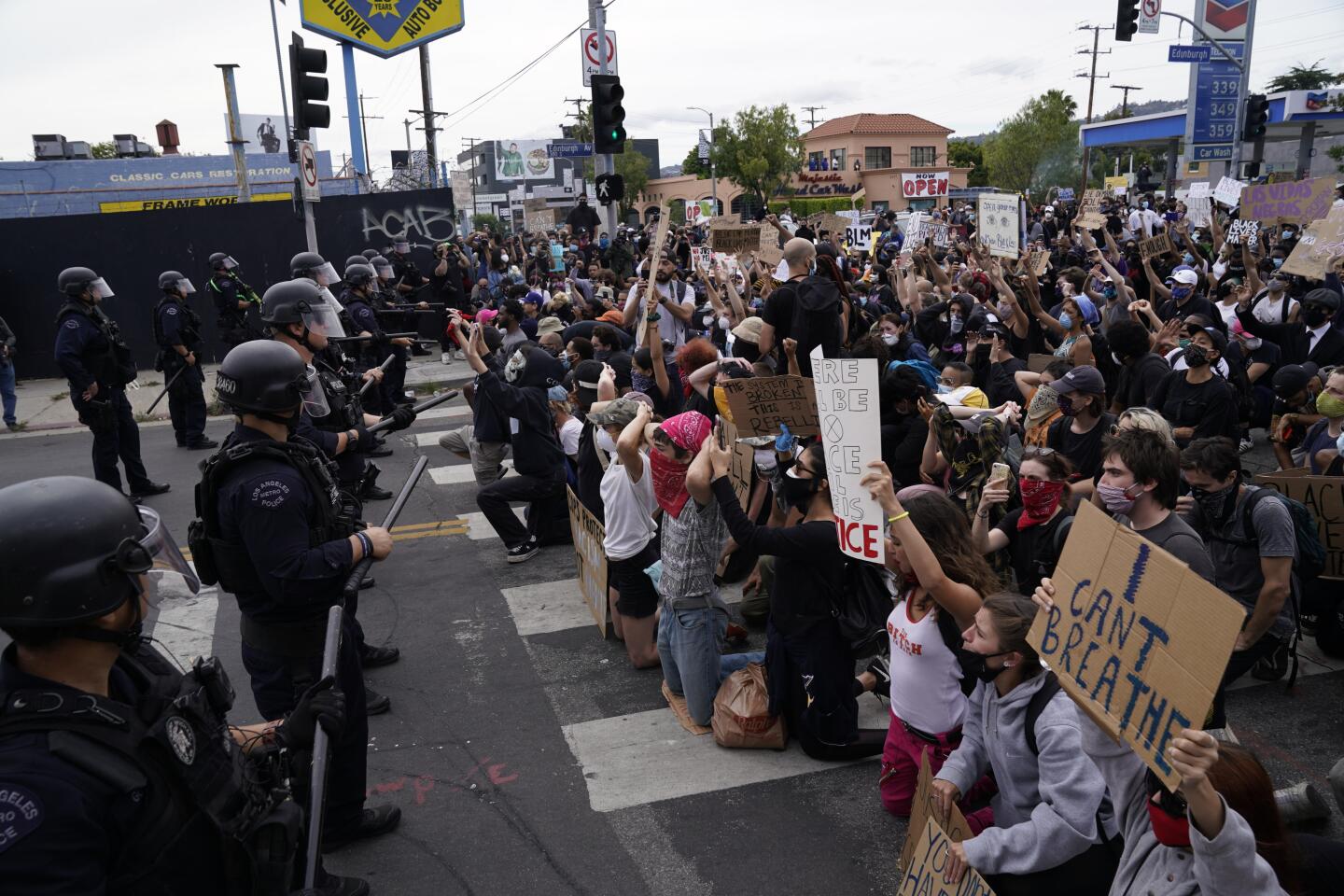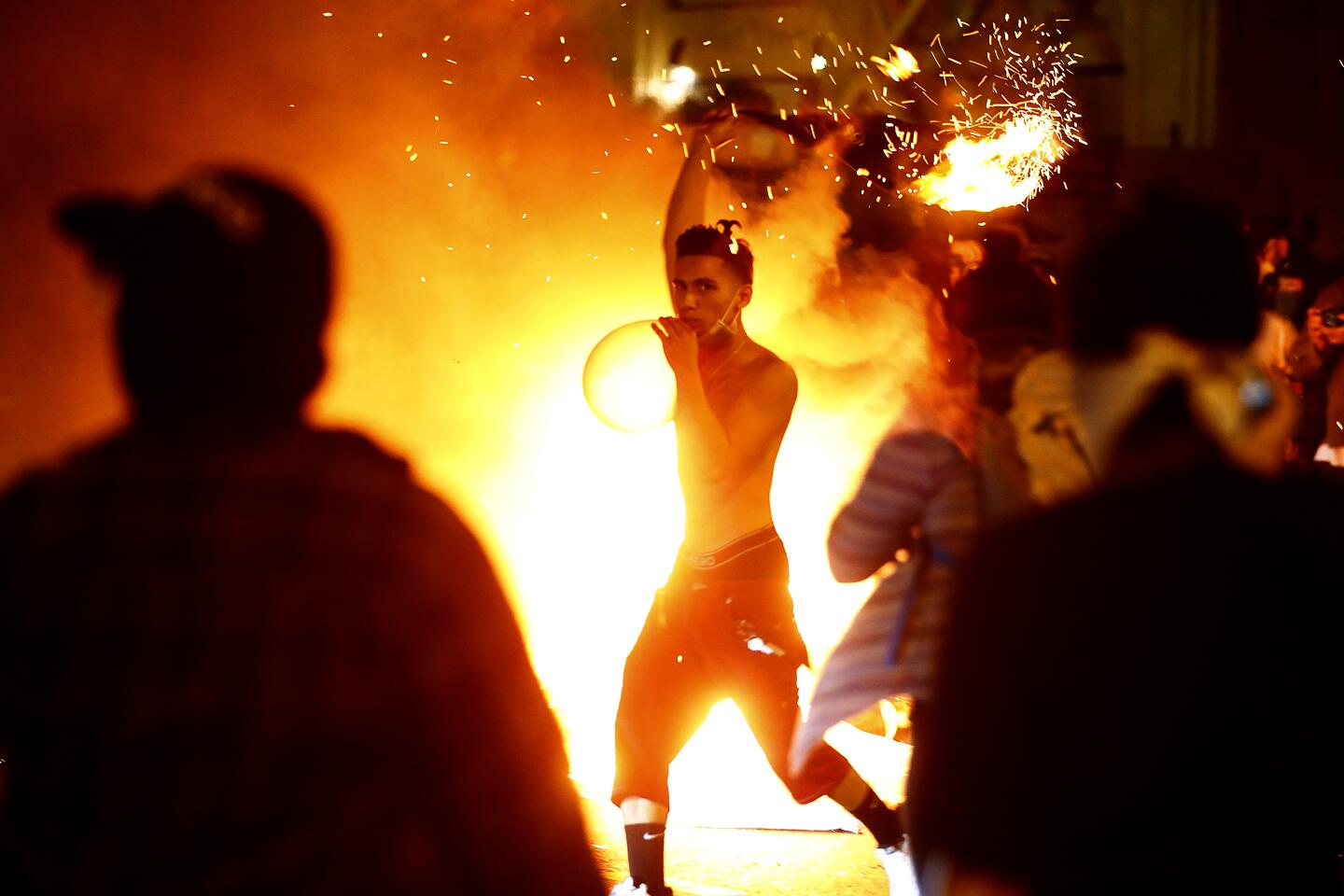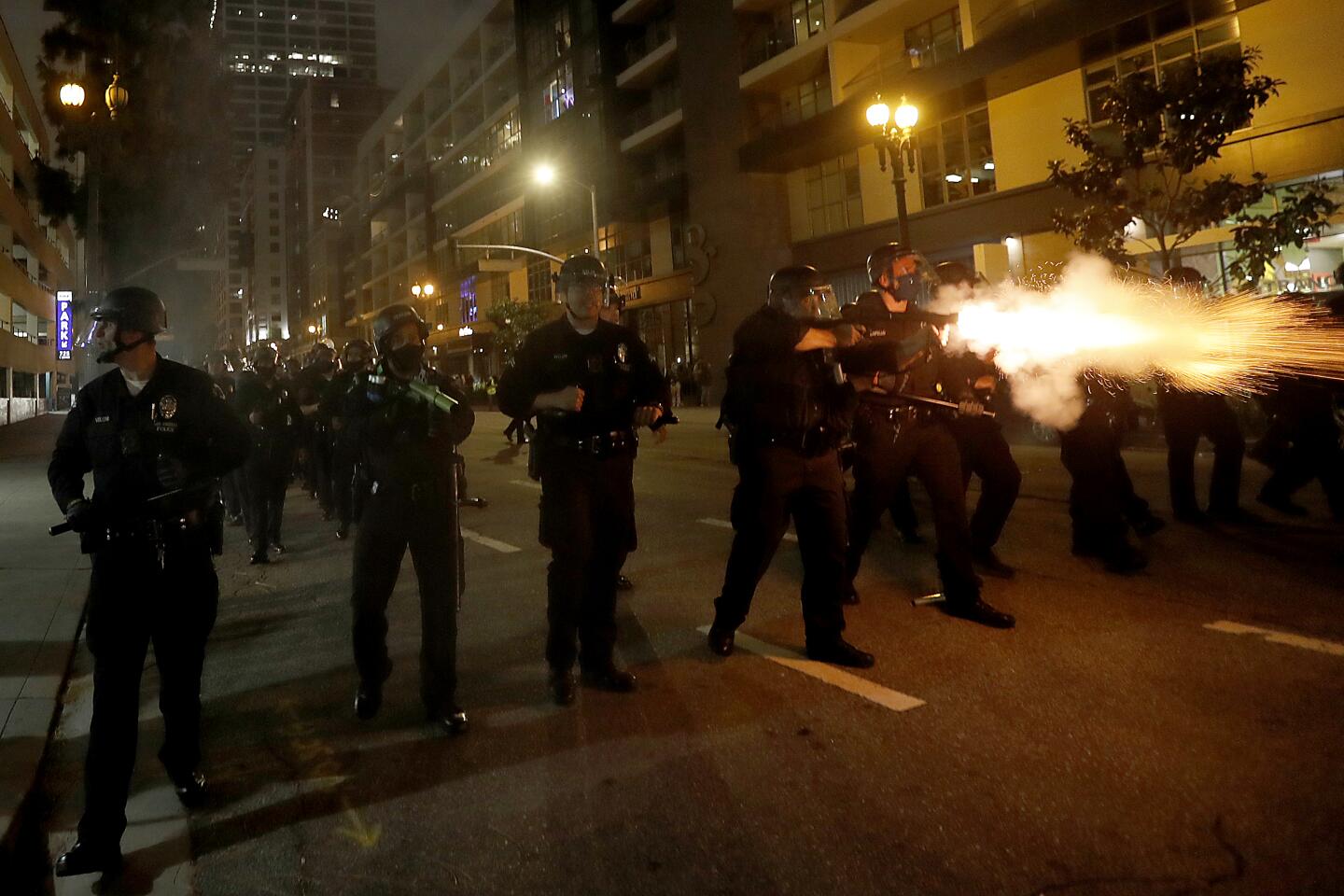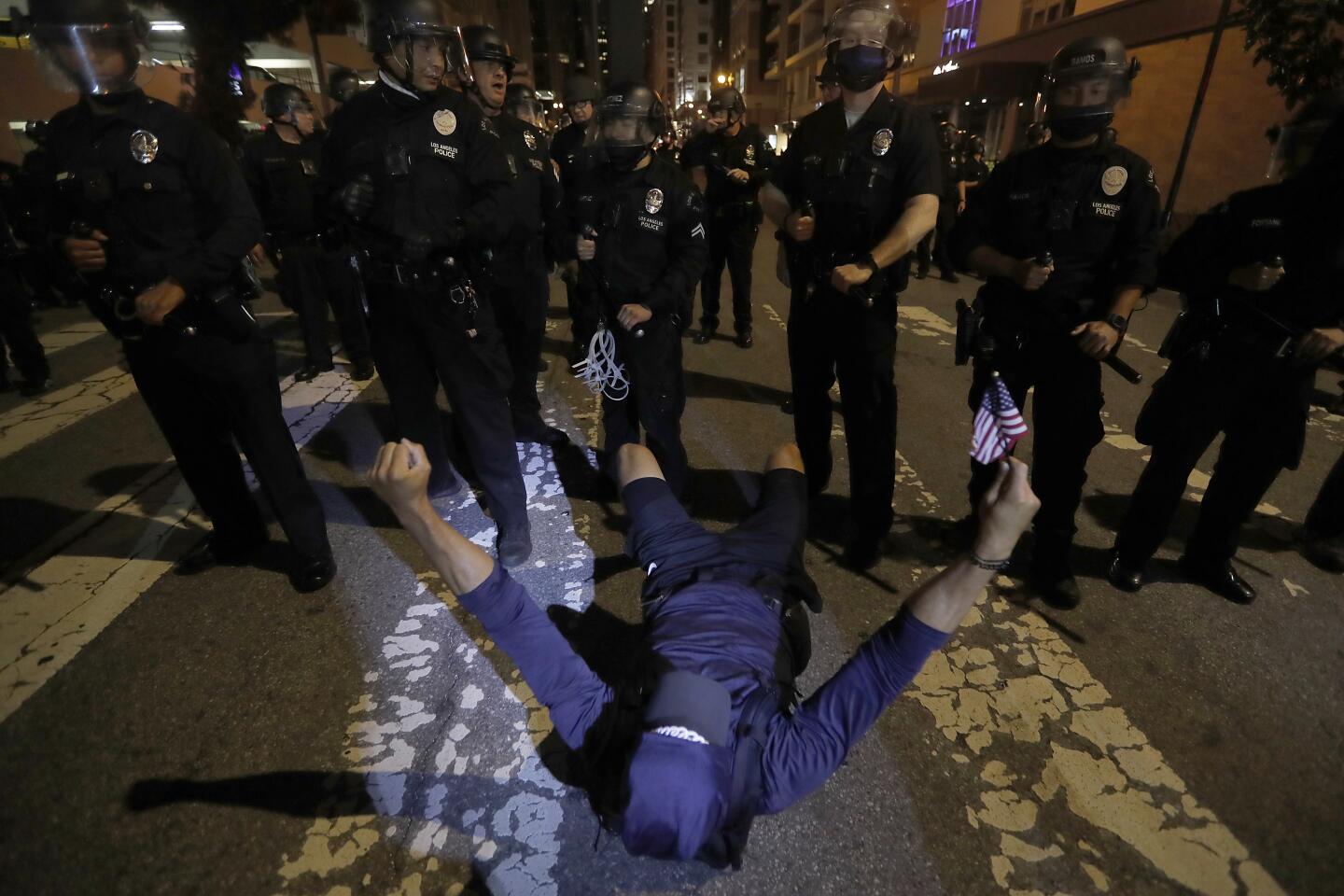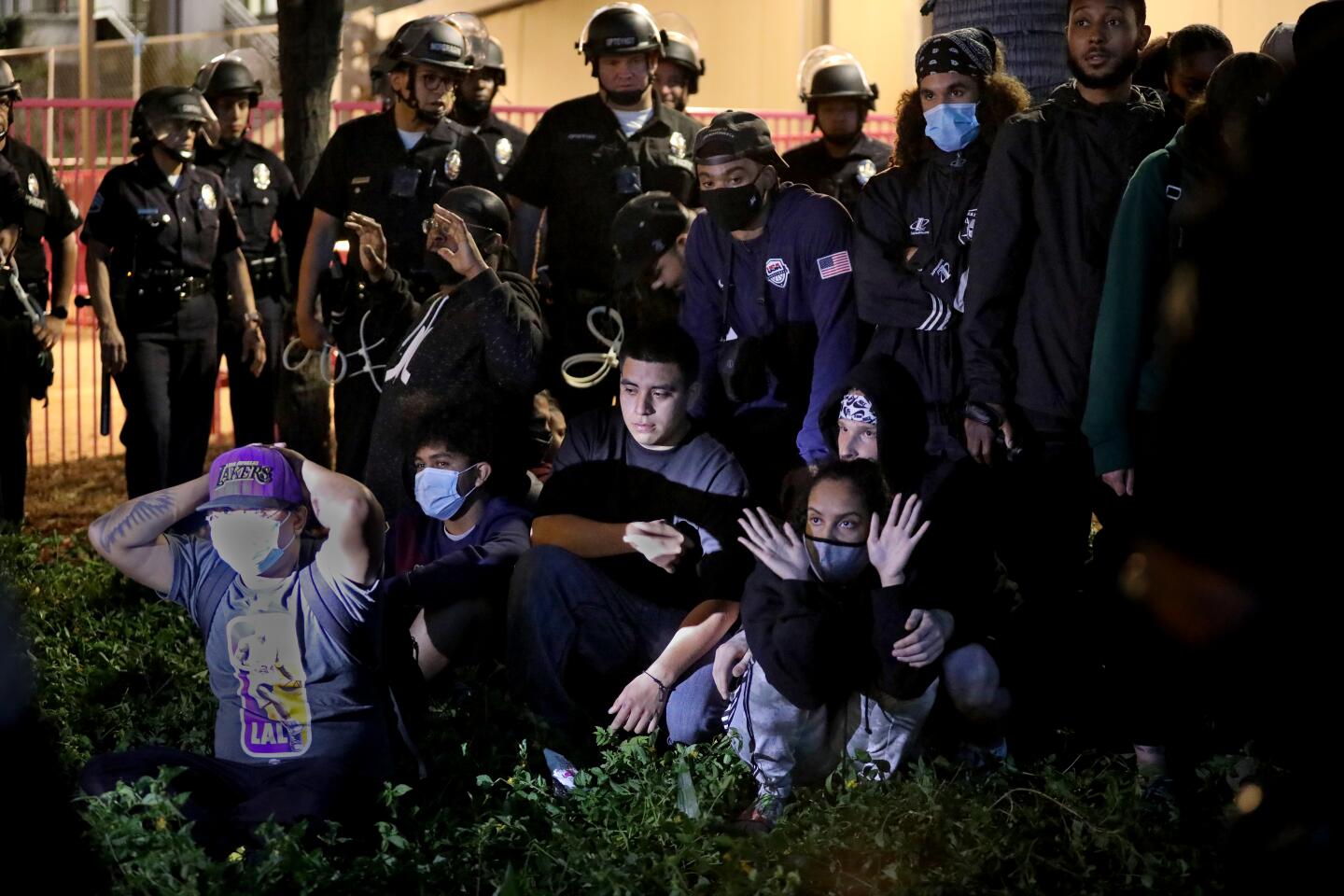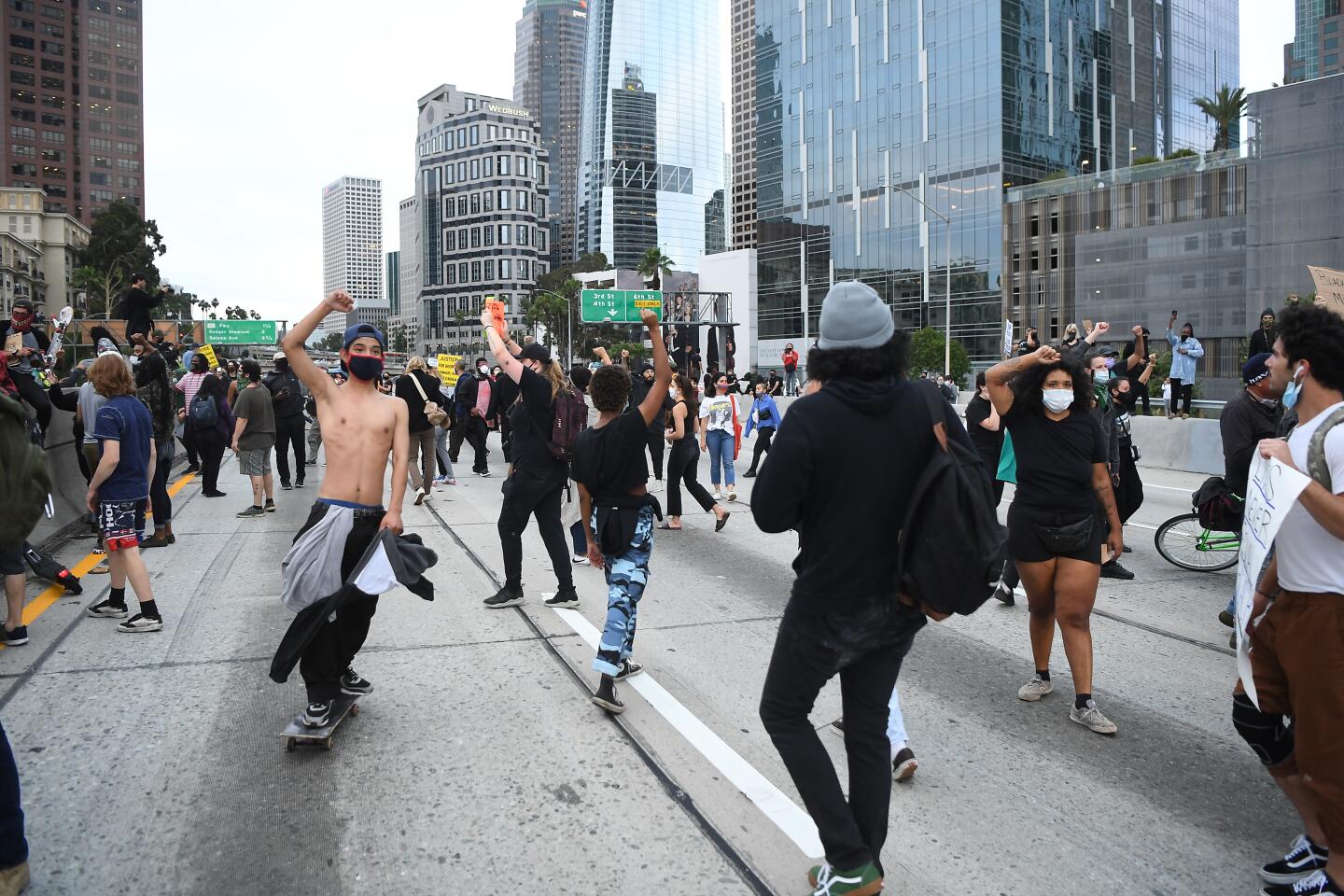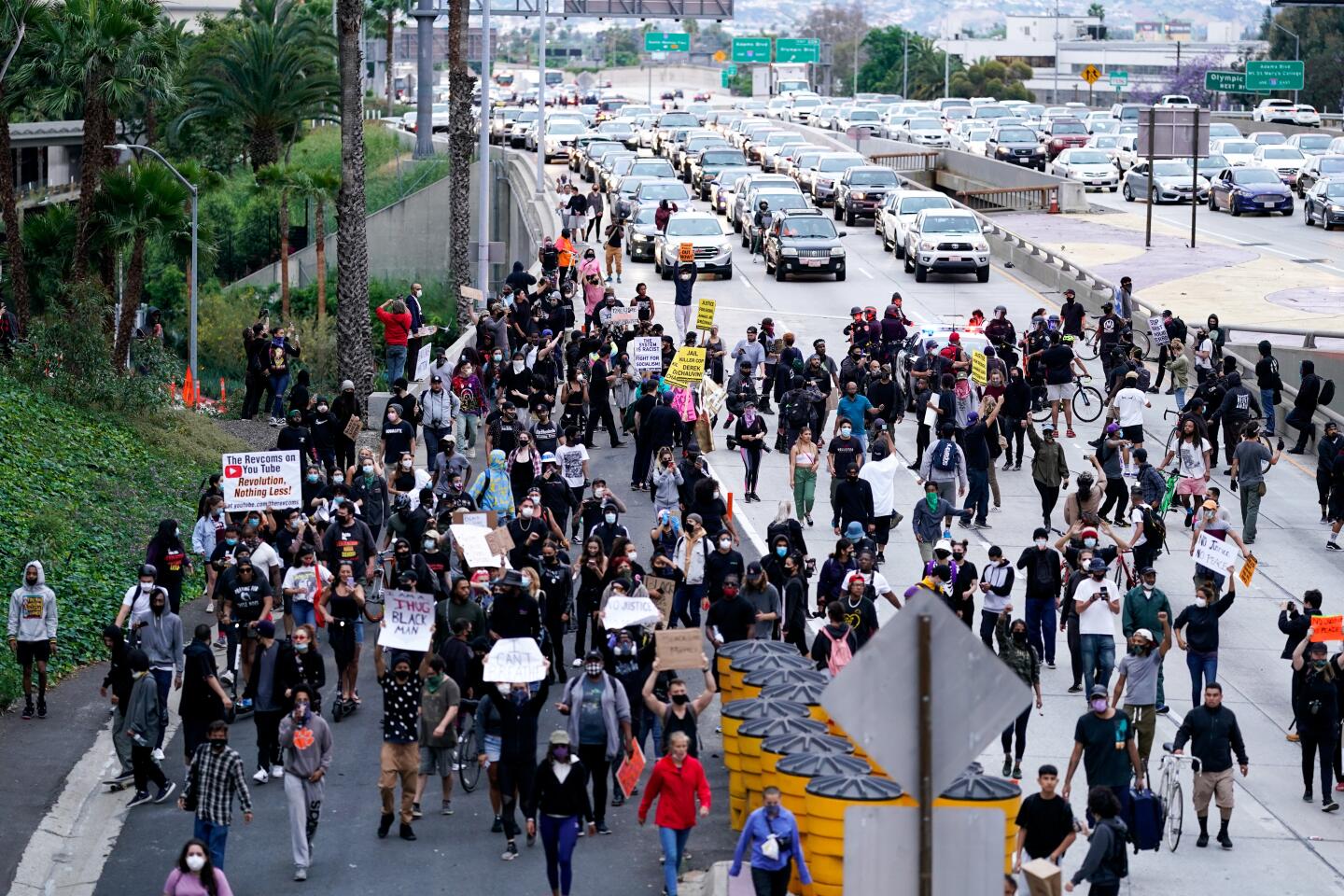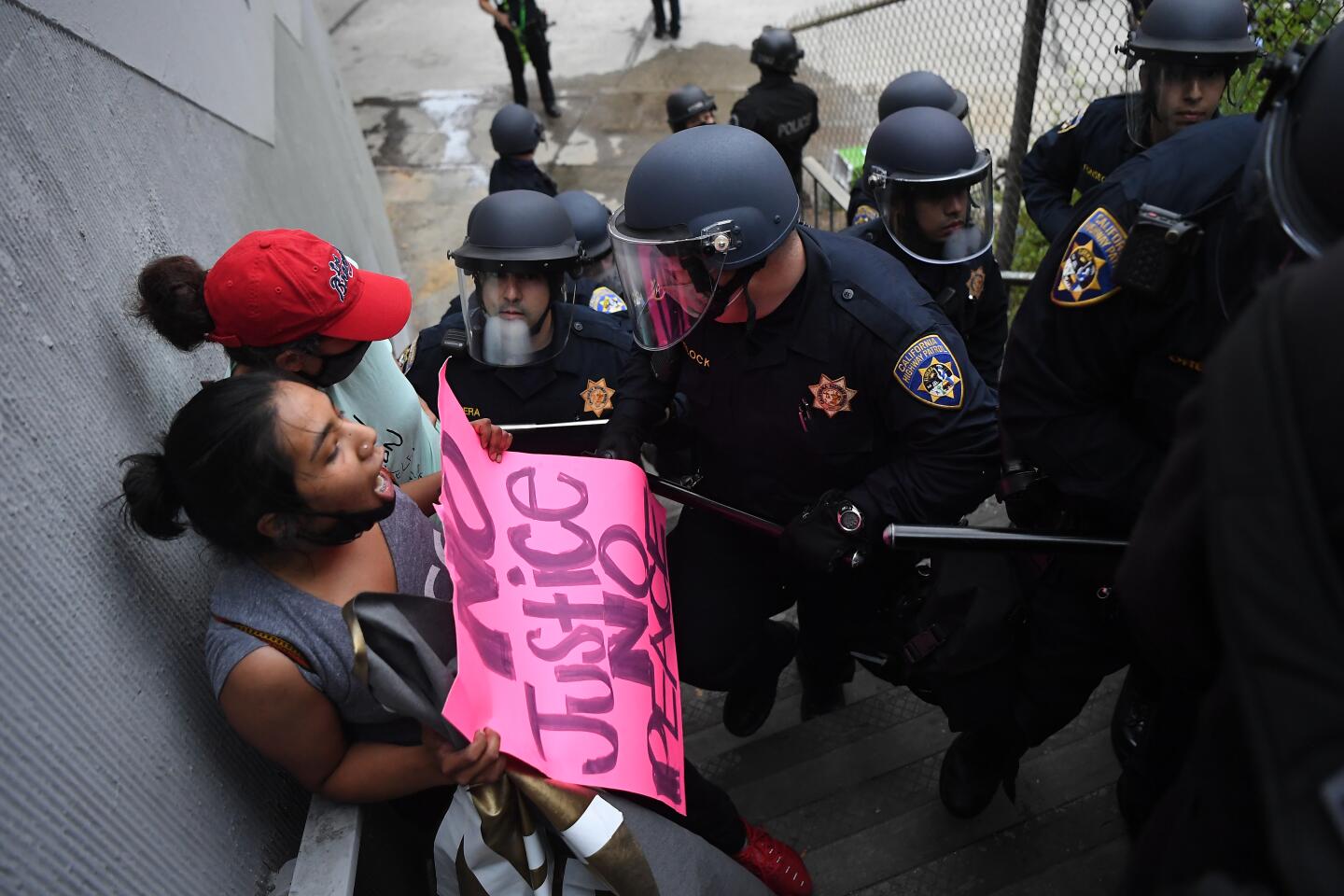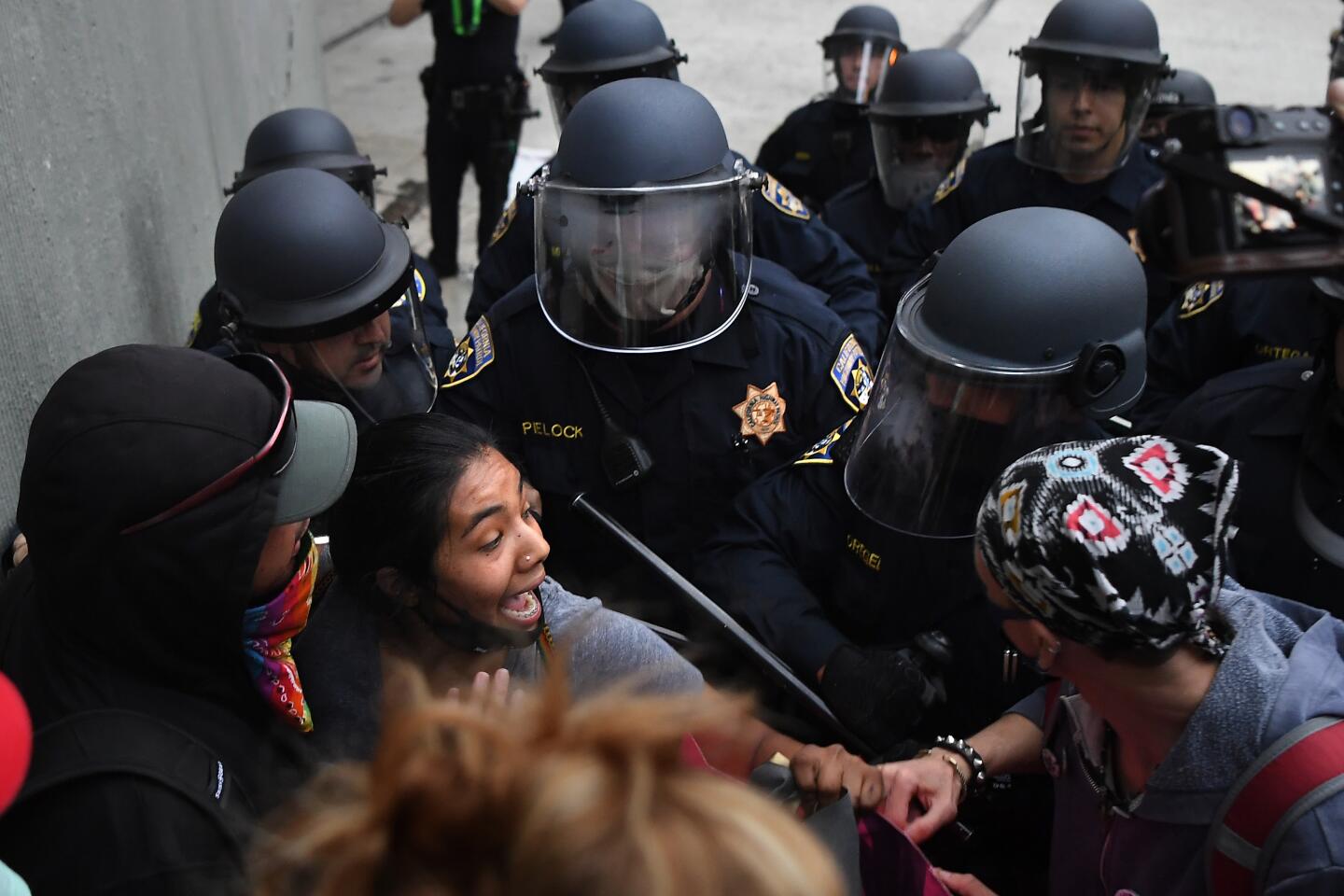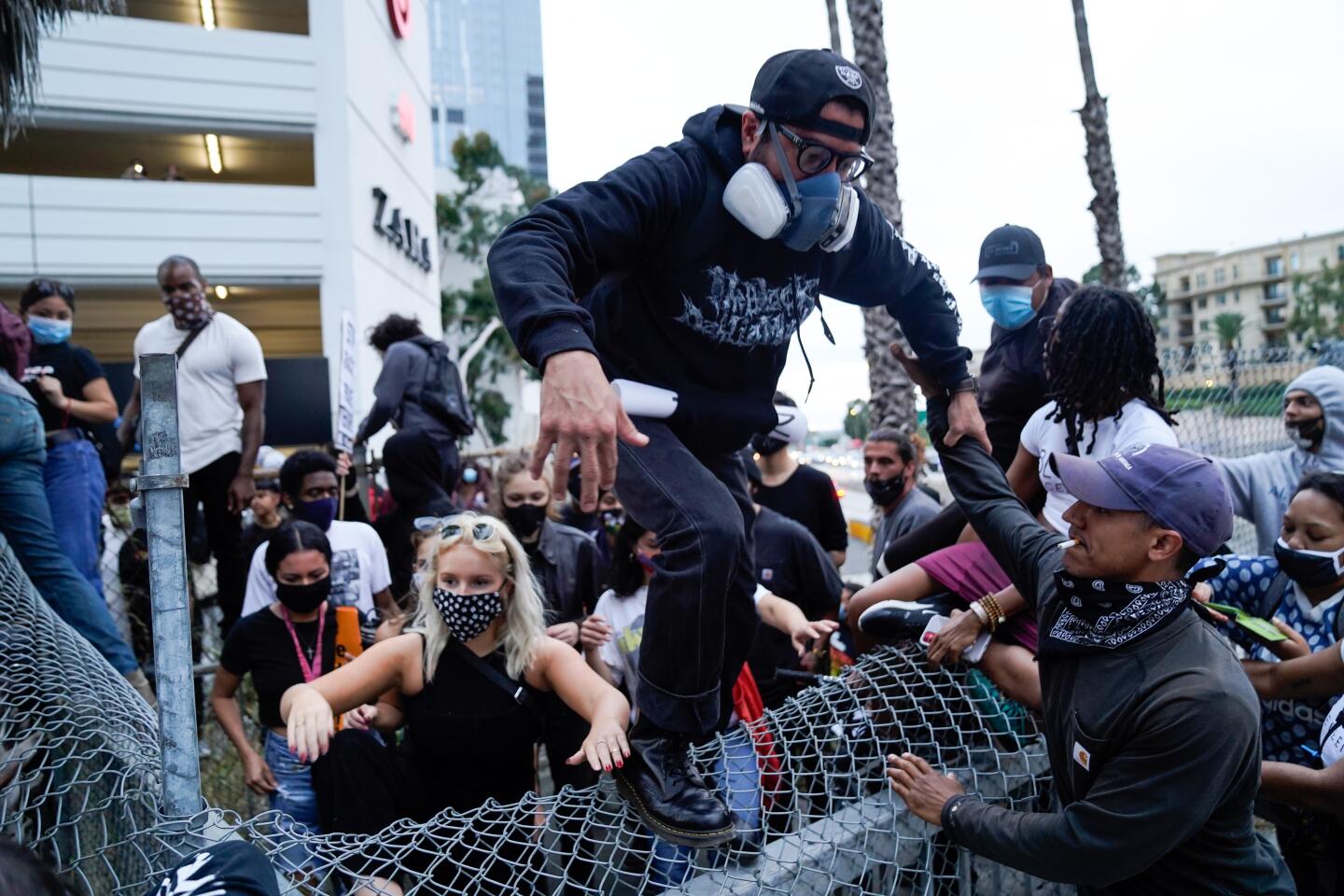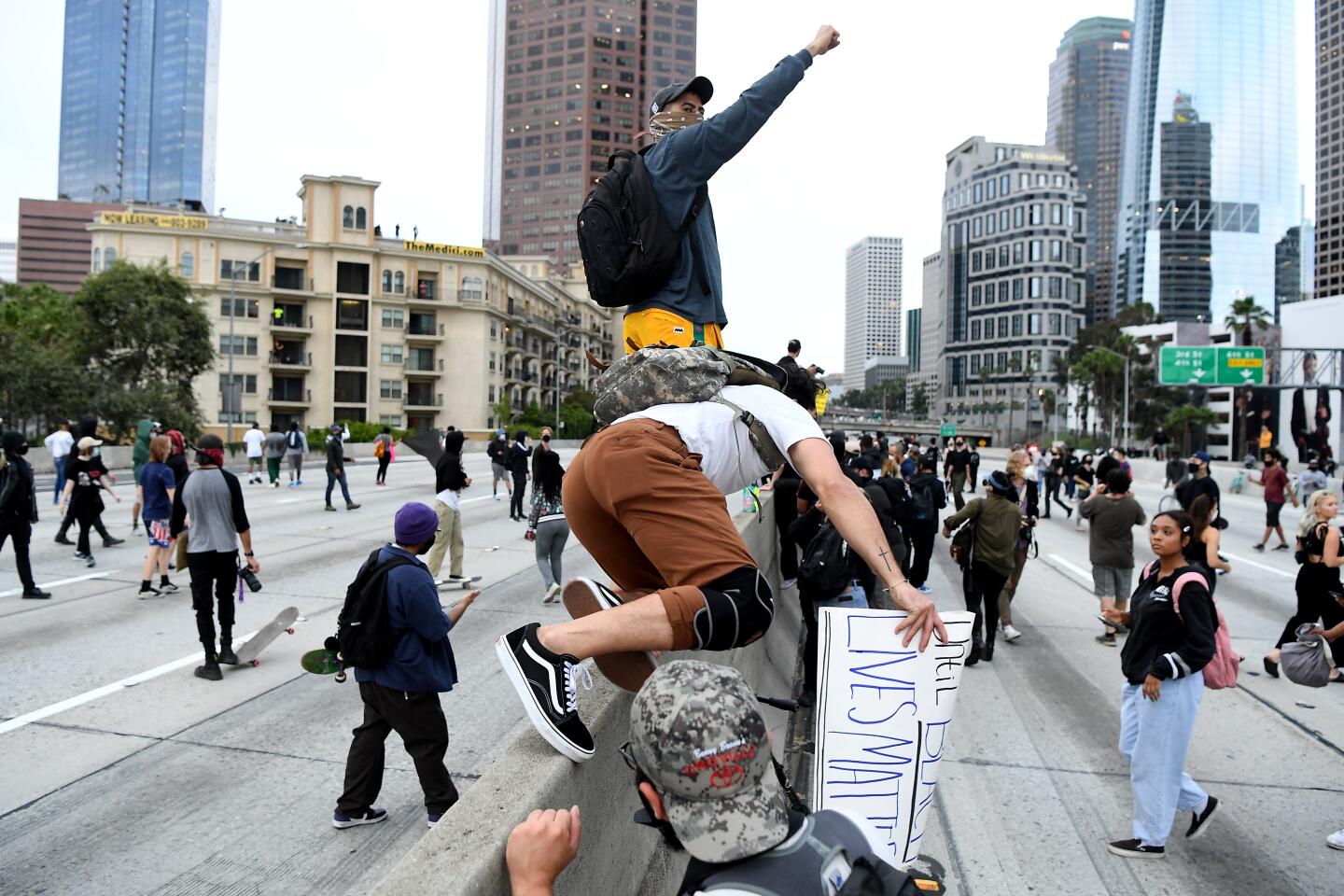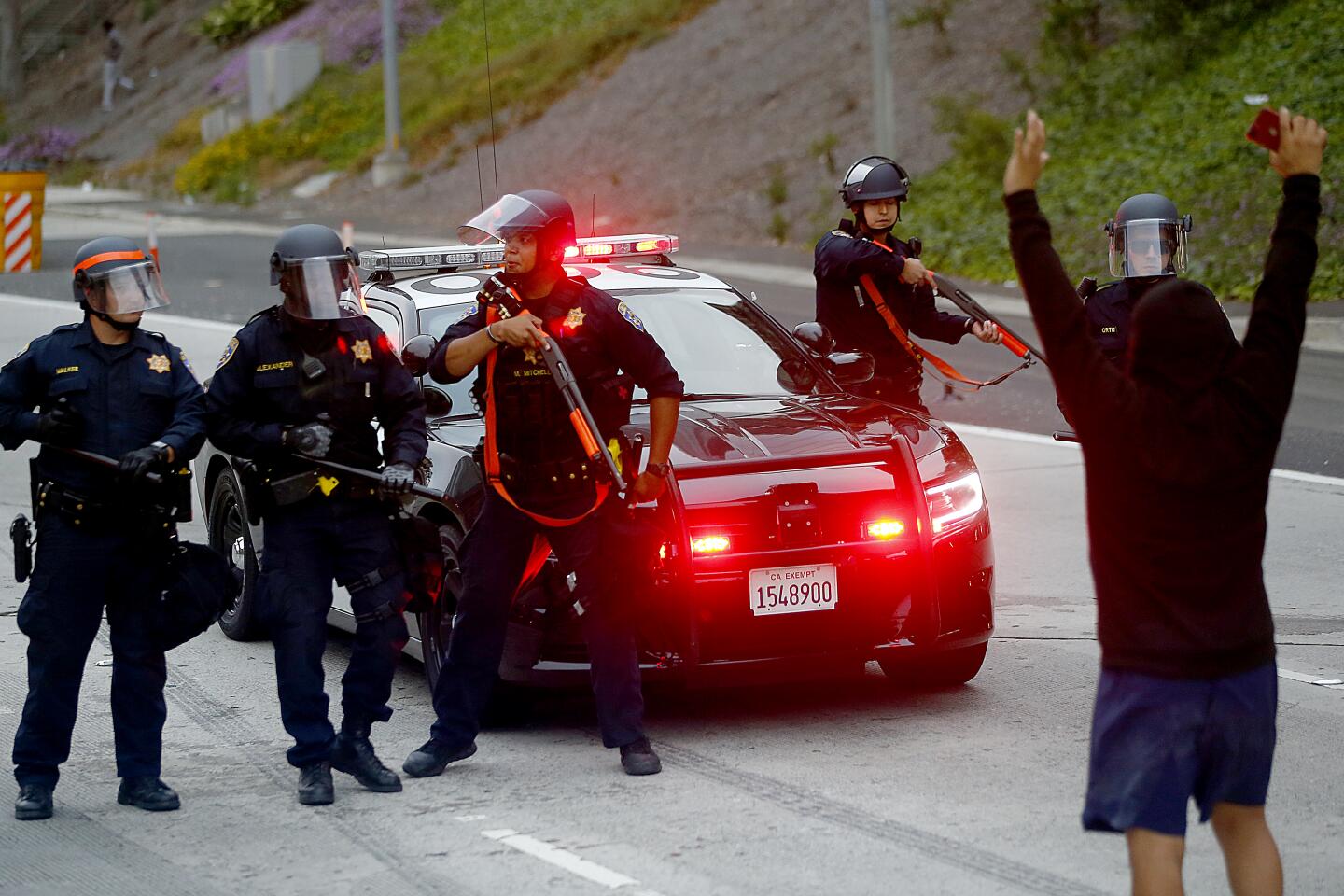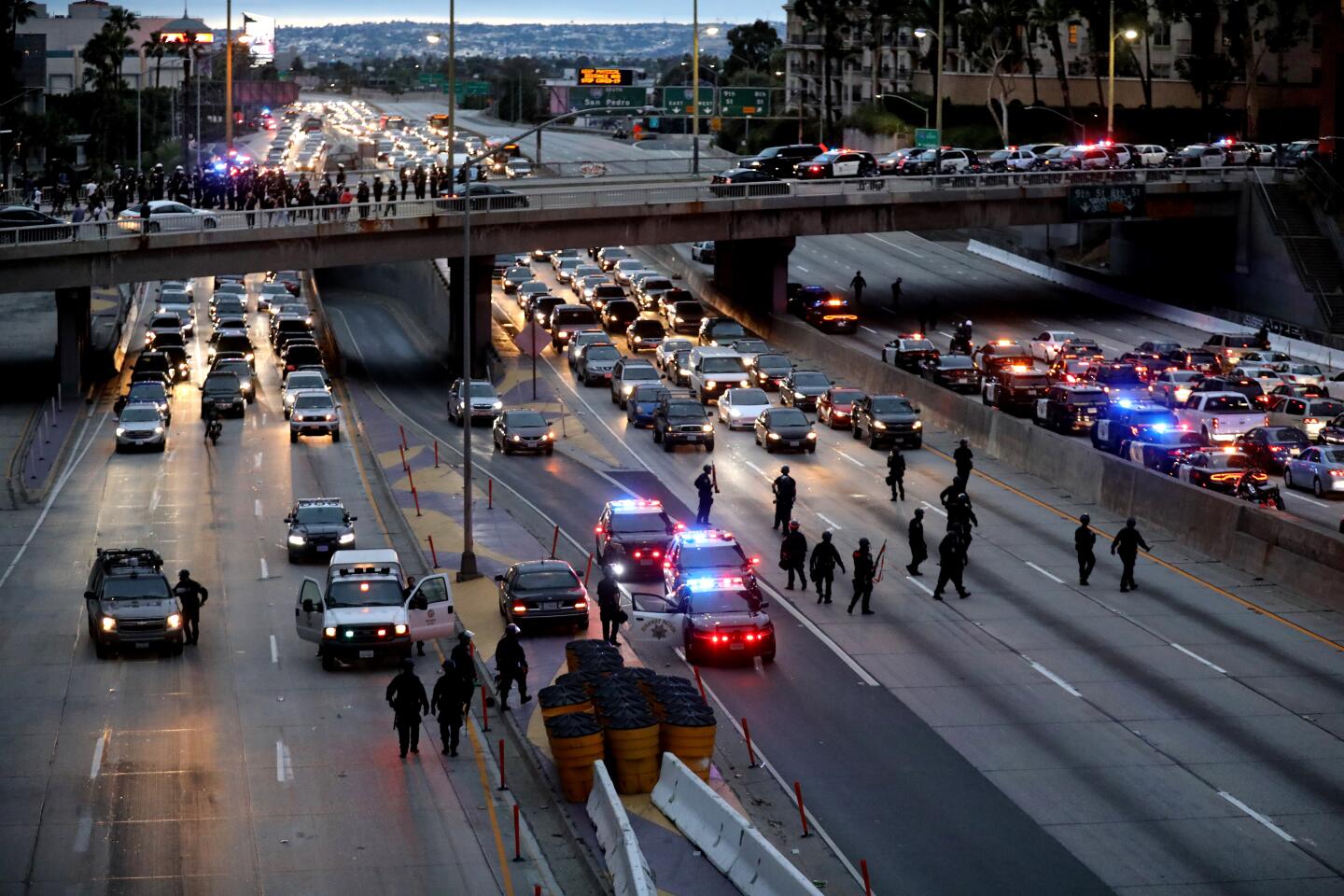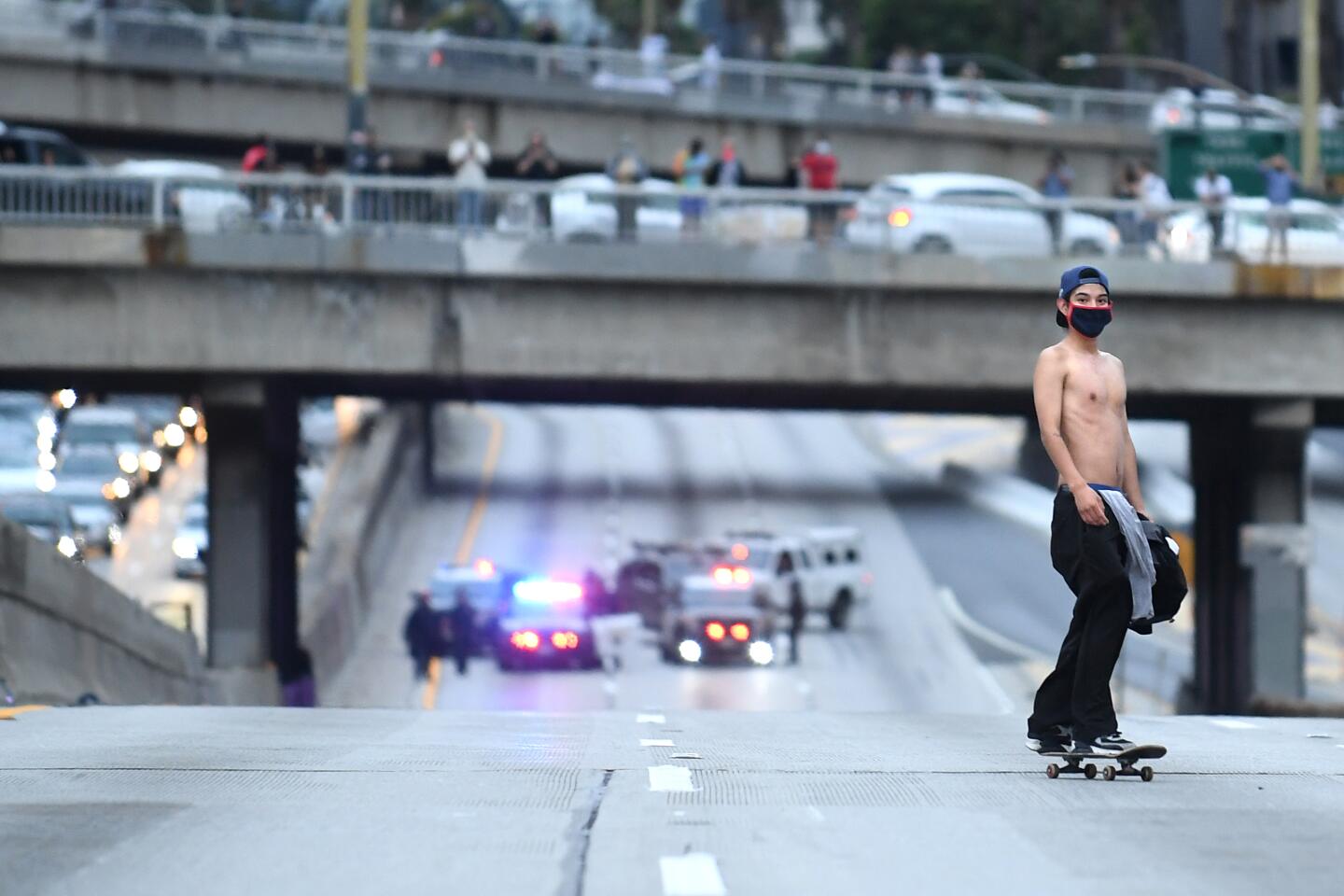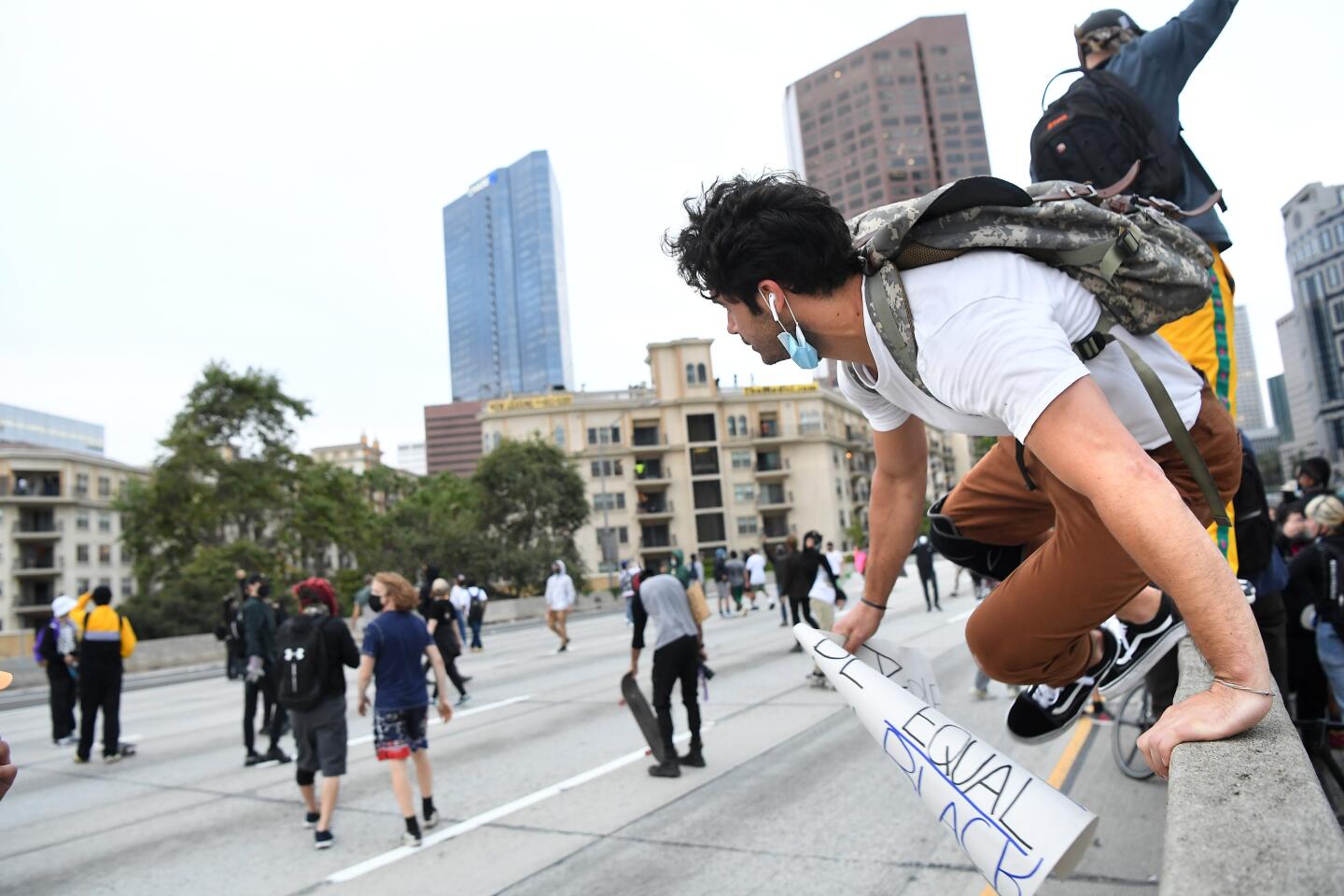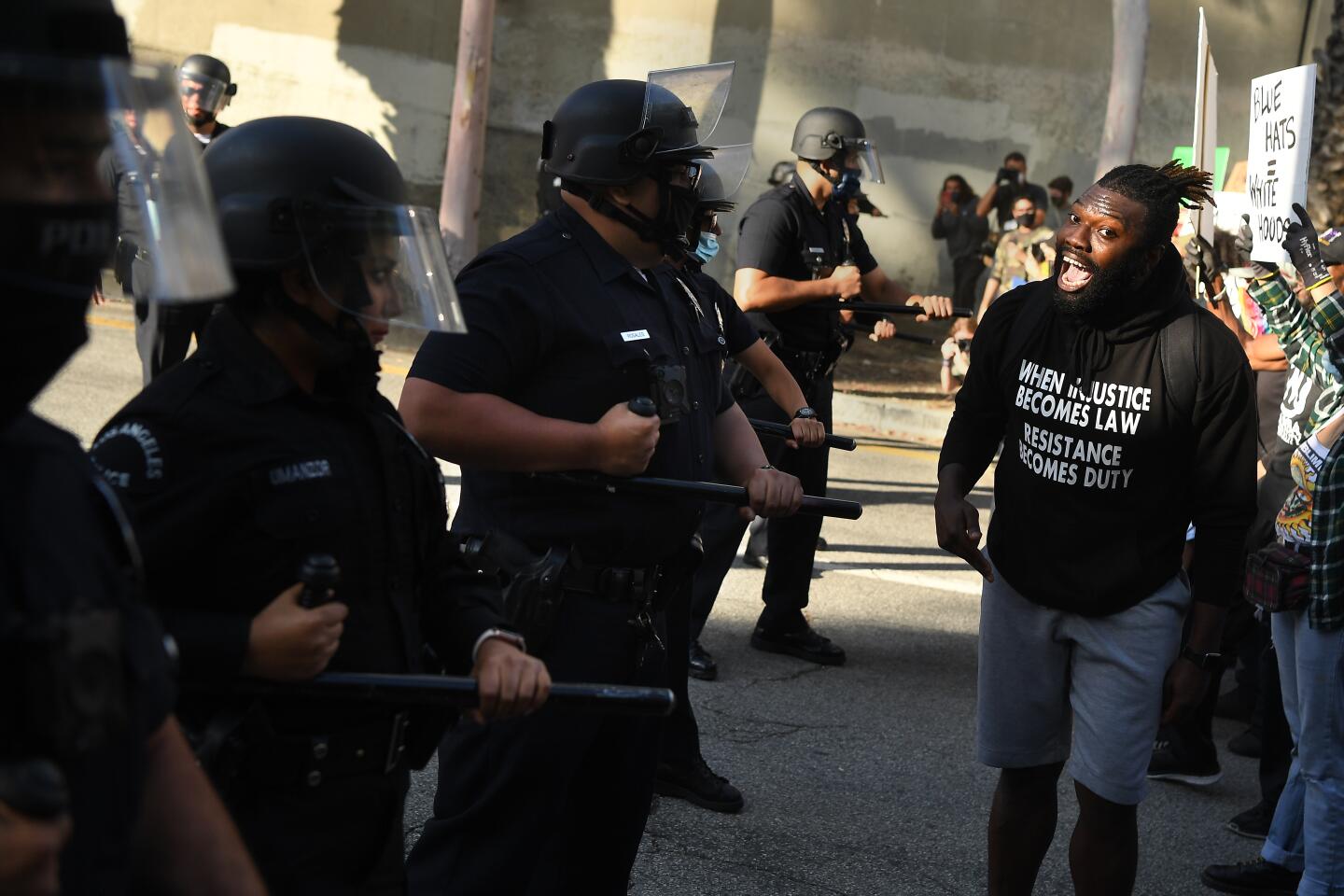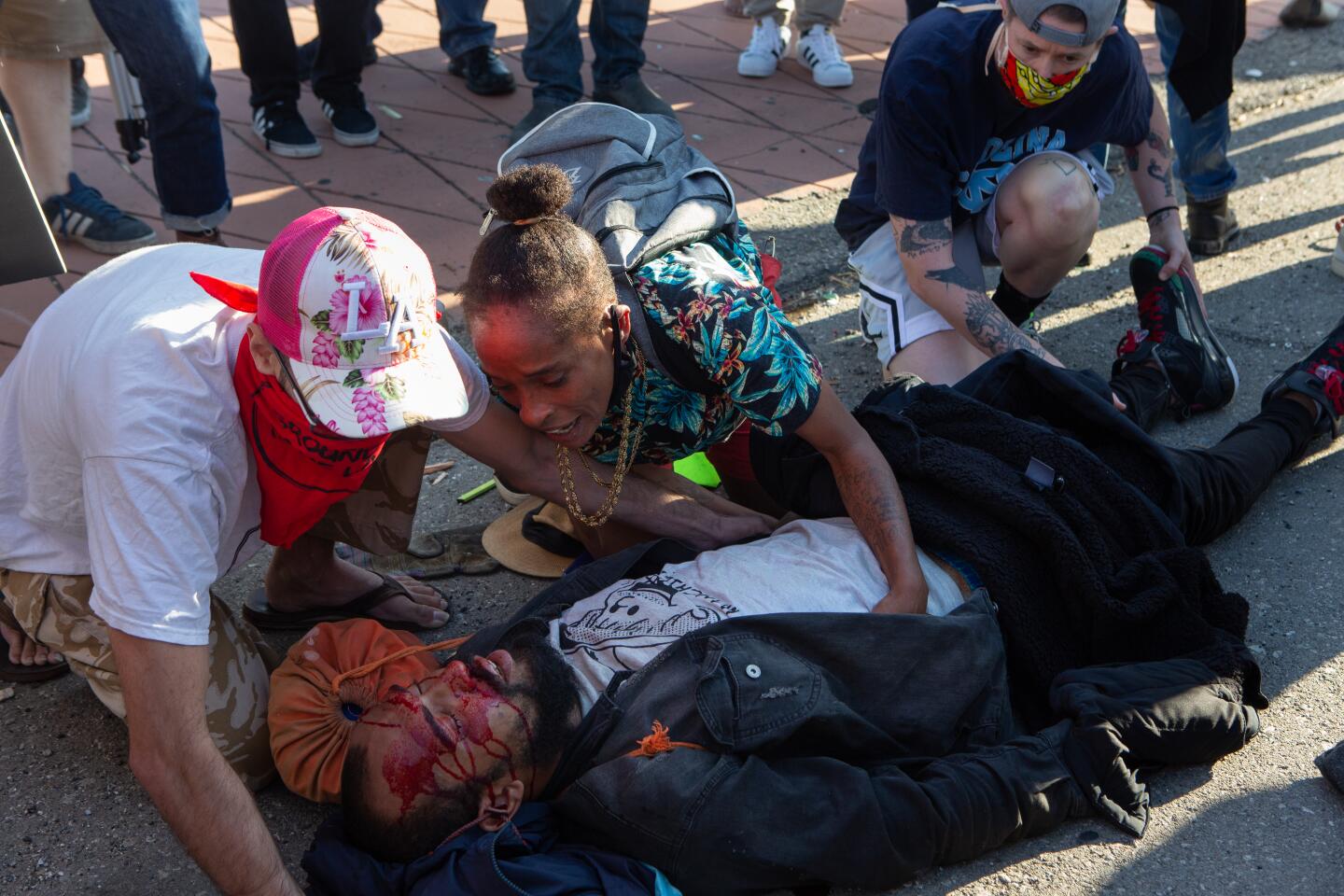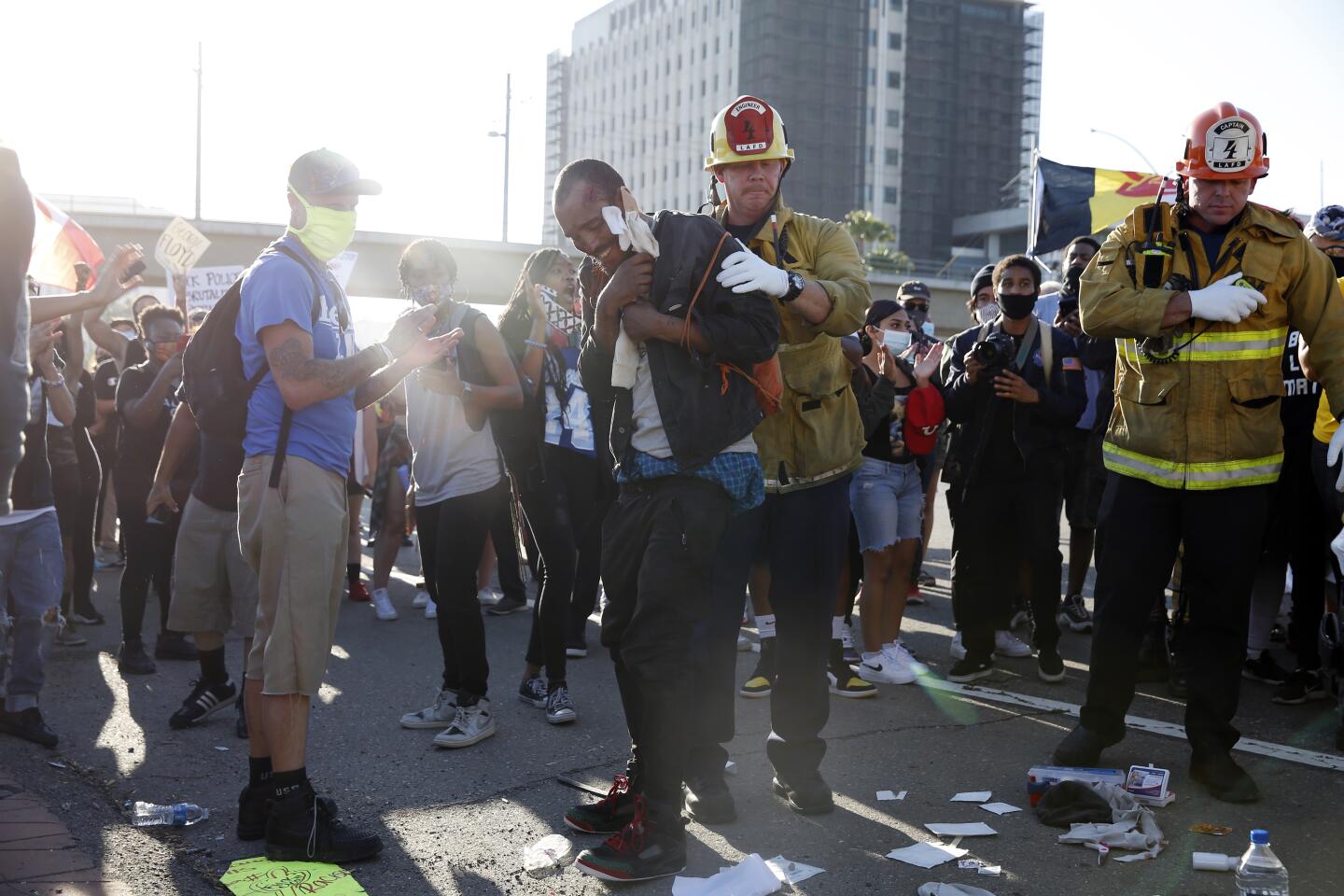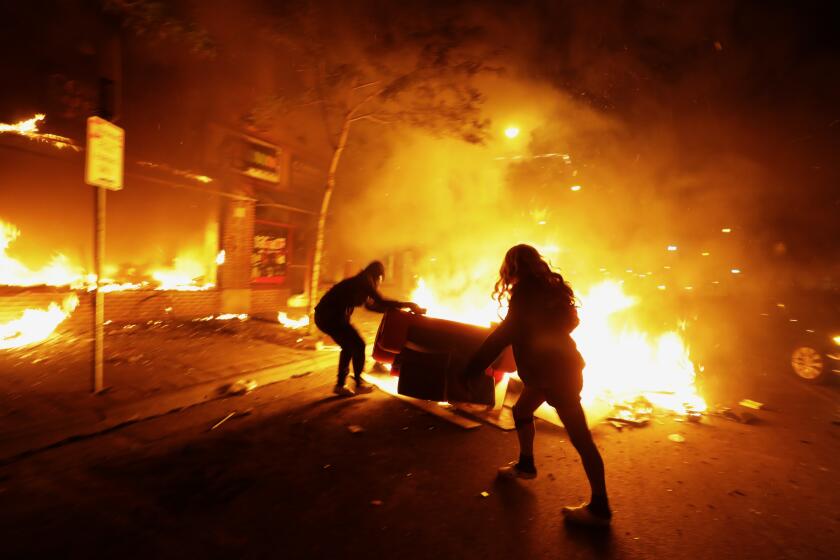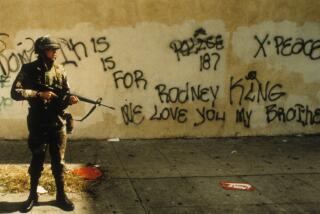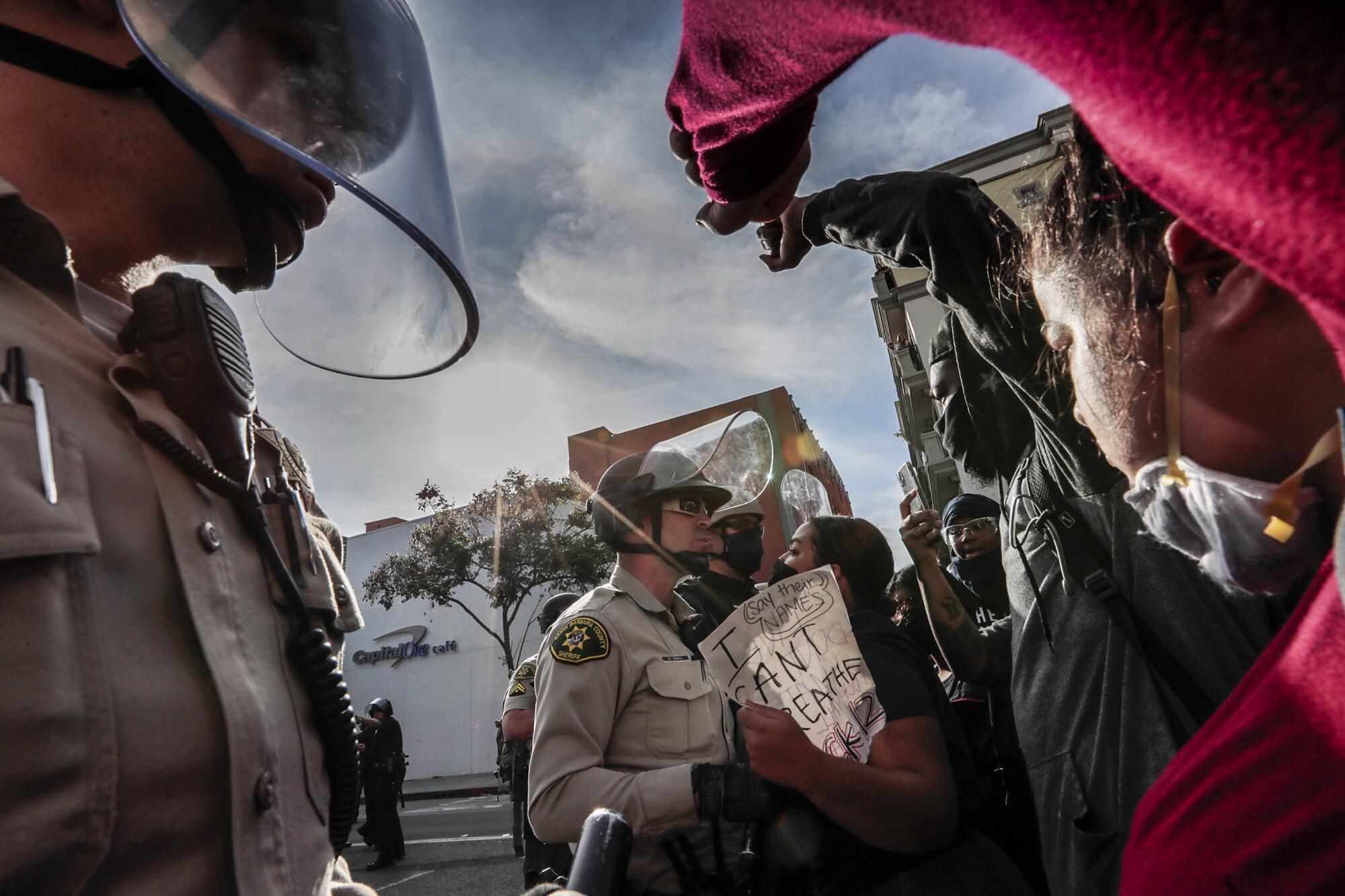
- Share via
National Guard troops arrived in Santa Monica on Sunday evening and were headed to Long Beach after both cities were hit by extensive looting.
It was a surreal end to a surreal day in Southern California as demonstrators once again gathered en masse in the midst of the coronavirus outbreak to protest the death of George Floyd, an unarmed black man who died last week in police custody after a white Minneapolis police officer pinned him down by his neck for several minutes.
National Guard troops and police officers guarded the barricaded steps of Los Angeles City Hall. Emergency alerts on phones warned Los Angeles County residents of a mandatory overnight curfew.
In Santa Monica, looters spent hours in the city’s upscale business district stealing items and setting several fires. In Long Beach, an outlet mall and some downtown shops were hit as protesters screamed at looters and begged them to stop. Caltrans closed westbound lanes of the 10 Freeway at Bundy Drive to prevent people from coming into Santa Monica. Hundreds were arrested.
Protests in downtown Los Angeles, Huntington Beach, Santa Ana and elsewhere were largely peaceful.
In Long Beach, hundreds of protesters — many chanting and holding signs reading “No Justice, No Peace” and “Black Lives Matter” — walked at about 3 p.m. from the city’s downtown and through Alamitos Beach as residents stood on sidewalks and balconies, shouting words of support.
But less than two hours later, hundreds of people began looting stores at the Pike Outlets. People smashed windows with hammers and trash can lids. Some protesters yelled for the looters to leave the stores alone. Others shouted, “Let’s hit Nike!” before running toward the athletic store.
Several minutes later, a mob rushed back and stormed into Forever 21, slipping on clothes scattered on the floor. At G by Guess, a man used a hammer to smash the store’s door before another man intervened and asked him to stop. Suddenly, the would-be looters began punching the man.
Chandarley Lim, 28, stood in the middle of the street that runs through the outdoor mall yelling, “Peaceful protest!”
“This is sad, man,” she said of the looting. “This is not a good look. Don’t let the bad examples ruin it for the rest of us.”
Shortly after 6 p.m., Long Beach police declared an unlawful assembly in the area, signaling that arrests would soon follow. About an hour later, police and demonstrators were at a standoff on Broadway and Pine Avenue. At least one protester threw a water bottle at the officers standing along Pine, prompting them to shoot rubber projectiles into the crowd.
Looting continued into the night, and someone set fire to a men’s clothing business in downtown Long Beach.
A similar scene unfolded in Santa Monica. Hundreds of people walked from the Santa Monica Pier north along Ocean Avenue, carrying signs and chanting. Some protesters were in a tense standoff with police, who were firing non-lethal weapons after some demonstrators threw objects toward them.
A little before 2 p.m., dozens of looters stormed Santa Monica Place, smashing the windows of Louis Vuitton and several other stores. They left before police arrived.
Paul Cain, who owns the Britannia Pub in Santa Monica, said he called police early in the afternoon to ask about safety in the area. They told him the protesters were peaceful and that he had nothing to worry about.
But soon, he saw waves of crowds on the street outside of his business. He ushered his customers sitting on the patio inside, and they watched looters storm the area.
“The people were outside eating and drinking, and all of a sudden it arrived,” he said.
Looters also ransacked the Vans store at 400 Broadway, stealing shoes and skateboards. People carried merchandise past the Promenade as police guarding 3rd Street watched them. They ran to a nearby alley, found what looked to be the back entrance to a store, and swarmed inside.
Amid sirens blaring and shouts of “police!” the group ran back out of the alley, carrying shoe boxes. Some of them were picked up by a waiting car. They rushed to stuff the merchandise inside while police on motorcycles approached.
A few blocks away, at 7th Street and Broadway, people were seen breaking into a pharmacy, using a skateboard to shatter the window before climbing inside. Next door, people smashed the window of a jewelry store.
At least one sheriff’s patrol car parked outside the civic center was set ablaze. Police shut down all off-ramps into Santa Monica from the 10 Freeway and Pacific Coast Highway and told people to avoid the downtown area.
In response to the protests across the region, Los Angeles County Sheriff Alex Villanueva announced a countywide curfew beginning at 6 p.m. Sunday and ending at 6 a.m. Monday.
But the looting throughout Santa Monica continued into the evening. Protesters crashed store windows with hammers and ran in, taking what they could before police arrived. Store alarms and police sirens sounded throughout the city.
Inside the Britannia Pub, Cain periodically shouted and pointed out the window toward people with their arms full of merchandise from the Gap and other stores.
“Take a picture of that,” he said. “He must be carrying his body weight in jeans.”
Protests also took place Sunday afternoon in downtown Los Angeles, including a march from Pershing Square to City Hall. National Guard troops established a perimeter around City Hall, joining officers from the Los Angeles Police Department.
“This is the opportunity for our generation to decide who we want to be as Americans,” Elevn St. James, who organized the protest, said into a megaphone from the steps of City Hall. “I can’t help but think, maybe this is the dream that Dr. King died for.”
At some point, he said, “Peace wins,” and urged the crowd not to escalate the violence.
“We can’t give them any more reason to shoot and kill us,” he said. “No more names.”
The crowd shouted back: “No more names.”
Neissa Diabate, 27, stood nearby holding a sign that read, “America would not exist without the black community.”
“It’s actually wild that we have to be out here in the middle of a pandemic,” she said. “America has taught us that peace does not get us far.”
At 7:45 p.m., nearly two hours after police warned them that they had violated curfew orders and faced arrests, a few hundred demonstrators departed City Hall and began streaming south on Hill Street. They filed past an empty Grand Central Market, past boarded-up storefronts, past wary security guards who assured them that they, too, had no tolerance for police brutality, and past stone-faced National Guard troops.
When an LAPD helicopter circling overhead turned its beam onto the procession, marchers paused to extend middle fingers to the pilot.
At one point, a marcher flung an M-80 firecracker into a group of police officers stationed at Main and Ninth streets. After it exploded, officers briefly fired rubble projectiles at the marchers, who took off running.
In Huntington Beach, police declared a protest with about 500 people near the pier to be an unlawful assembly about 1 p.m. The crowd shrunk considerably, but police fired pepper balls at some demonstrators who did not disperse, according to reports from the scene.
There were no reports of vandalism, but several people were arrested, said Angela Bennett, public information officer for the Huntington Beach Police Department.
Sunday’s demonstrations capped a weekend of violent protests in Southern California, with numerous buildings, including in the upscale Grove shopping center in the Fairfax District, being set on fire.
Los Angeles police said 398 people were arrested Saturday on suspicion of crimes including burglary, looting, vandalism, failure to disperse, and firearms and curfew violations. Five LAPD officers were injured, with two of them hospitalized, officials said.
The most seriously injured officer was struck by a brick in the Fairfax area and suffered a fractured skull, authorities said. An officer also suffered a broken arm, and another’s leg was broken during clashes with protesters.
LAPD Chief Michel Moore said the officer whose skull was fractured underwent surgery Saturday night. “I believe he will survive,” he said at a Sunday news conference.
The unrest — which undercut a weekend meant to be focused on the the reopening of restaurants, barbershops and hair salons that had been shuttered due to the coronavirus outbreak — spurred cities across the region to enact overnight curfews.
The cities of Beverly Hills, Santa Monica, West Hollywood, Culver City, El Segundo and Torrance announced curfews for Sunday into Monday, as did the city of Santa Ana in Orange County.
In West Hollywood and Torrance, the curfews will be in effect each night until they are lifted by city officials. In Beverly Hills, the curfew took effect at 1 p.m. for the business district, which includes Rodeo Drive, and at 4 p.m. for the rest of the city.
“Violence, looting, and vandalism will not be tolerated in our city,” Beverly Hills Mayor Lester Friedman said. “It’s unfortunate that the message of the peaceful protesters has been diminished by criminal behavior.”
On Sunday, National Guard troops in full combat gear stood outside shattered storefronts in downtown L.A. as the morning light revealed damage from the days before: broken windows, trash-strewn streets and graffiti-tagged buildings.
By 7 a.m., scores of Guardsmen toting M-4 rifles marched on patrol along Broadway between 7th and 8th streets.
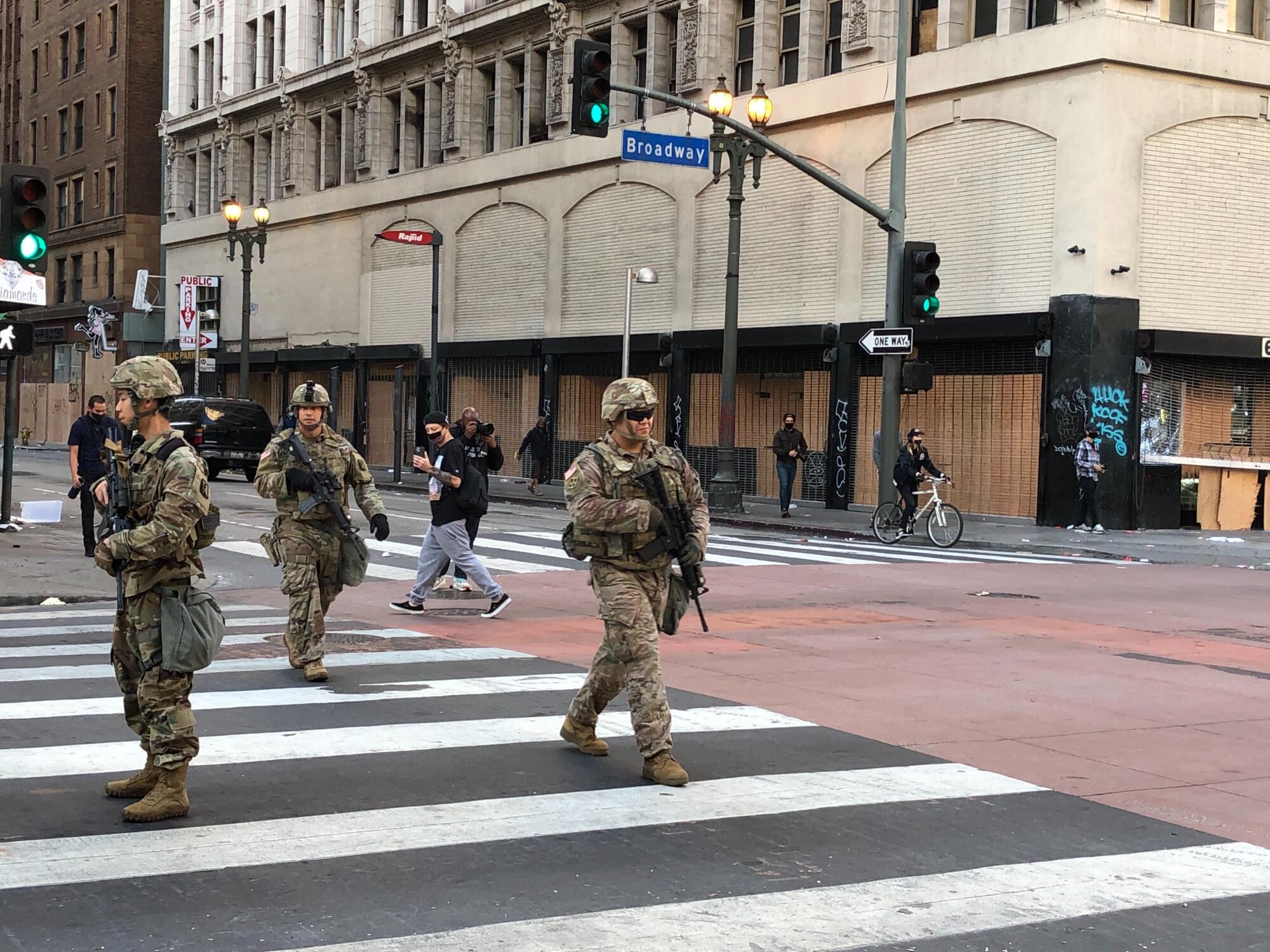
Gov. Gavin Newsom had declared a state of emergency in the city and county of Los Angeles shortly before midnight.
Los Angeles County officials also proclaimed a countywide state of emergency to deal with the unrest.
“This emergency comes as we are in the midst of battling another emergency caused by the COVID-19 pandemic,” County Supervisor Kathryn Barger said Sunday in a statement. “This taxes our resources, but not our resolve.”
The proclamation will help authorities coordinate an emergency response and mutual aid and speed up the procurement of supplies, officials said. It also provides for future state and federal reimbursement of costs the county incurs.
The decision to call in the National Guard was criticized by City Councilman Marqueece Harris-Dawson, who represents a portion of South L.A.
“It’s clear that our fear is real that additional law enforcement will only further violence against people of color,” Harris-Dawson said in a statement. “Anarchists are taking advantage of our pain with looting and violence — this is not Black Lives Matter or members of our community who have suffered from systematic racism and oppression — these are domestic terrorists.”
The last time the National Guard patrolled the streets of L.A. was during the 1992 riots, which erupted after the police officers who beat black motorist Rodney King were found not guilty in a jury trial.
Many take to the Minneapolis streets again to protest the death of George Floyd, defying a curfew. ‘They dropped the ball,’ one says of local leaders.
Compared with those riots, the events in Los Angeles over the weekend were significantly less widespread and less dangerous.
Although officers were hurt when protesters threw objects at them, there have been no fatalities. The 1992 riots swept across large swaths of Southern California and left more than 60 people dead.
On Sunday, the Metropolitan Transportation Authority apologized to passengers who were left stranded across L.A. County when bus and rail service was suspended Saturday with little warning.
The unprecedented closure of the Metro system drew immediate criticism from advocates and elected officials who said essential workers were left stranded on sidewalks, at stations and in bus shelters in the hours after the 8 p.m. curfews imposed in Los Angeles and other cities.
Metro’s chief executive Phil Washington told KNX 1070 News Radio that the agency chose to shut down service because he had seen “a lot of damage,” and was concerned for the safety of Metro employees.
Washington said Metro supervisors were driving around the city on Saturday night to look for people at bus stops, then calling nearby bus yards and asking them to dispatch vehicles to pick them up.
On Sunday morning, a Metro spokesperson said the agency would reimburse trips taken in a taxi, Uber or Lyft after the system shut down. Anyone seeking a refund should call Metro customer service at (323) 466-3876.
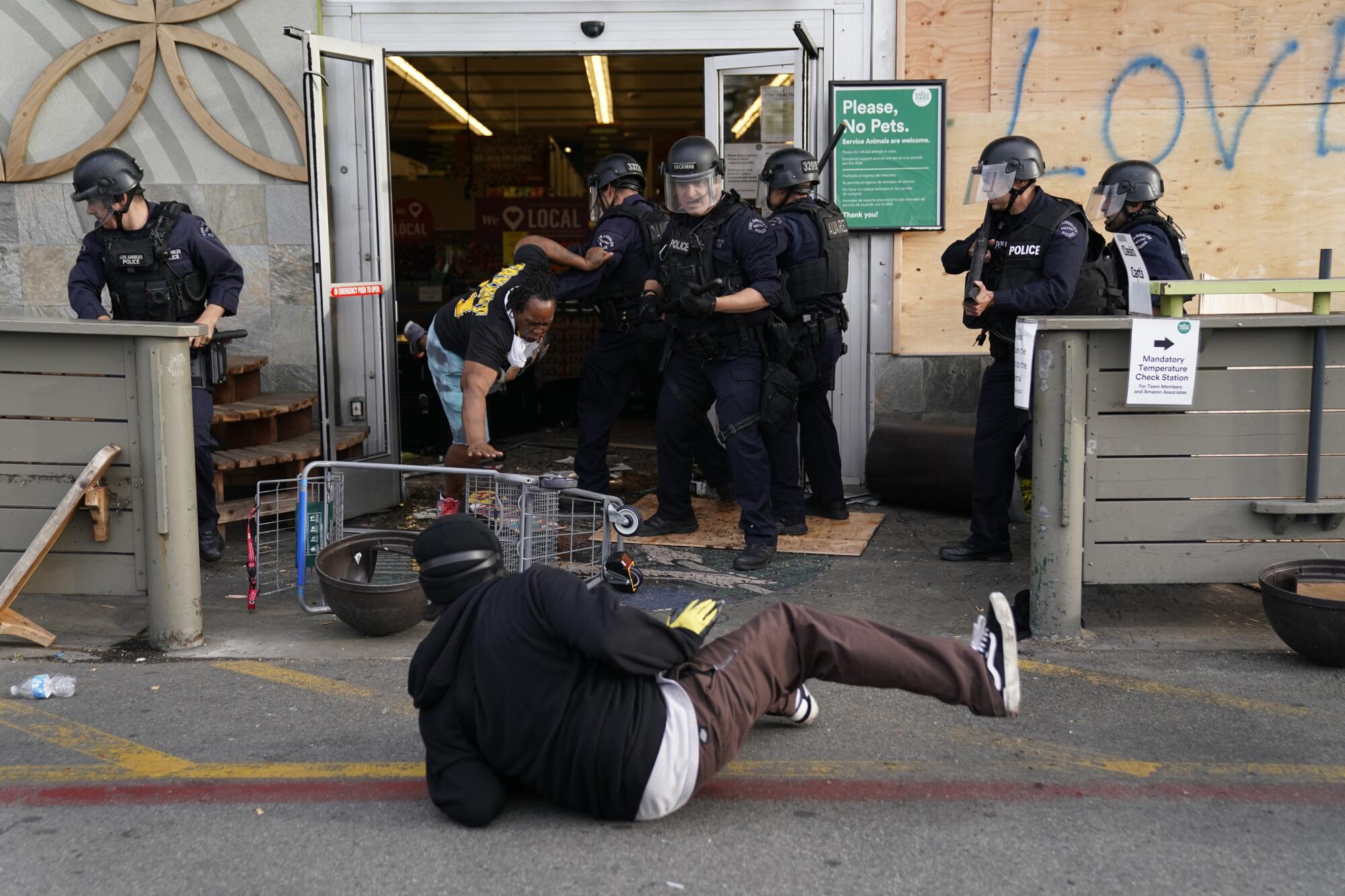
Lindsay Pierce was operating on only about an hour of sleep when she headed to Melrose Avenue on Sunday morning to survey the damage to her business. What she had seen on her security cameras Saturday night had made her ill.
The Melrose Avenue business owner had been monitoring her shop, Wax, via security cameras as the protests moved through the Fairfax district. At about 11 p.m., she said, three young men darted inside her store after its windows were shattered. They immediately moved to the business’ internet router and disconnected it, cutting off Pierce’s connection.
“I started sweating, I got sick to my stomach, I was just thinking, ‘Please don’t light it on fire,’” Pierce said Sunday morning.
Her survey revealed that all the business’ electronics were stolen, along with some small merchandise.
L.A. City Councilman Paul Koretz, who represents many of the areas that incurred damage, said business districts along Fairfax Avenue and Melrose Avenue had been “devastated” by looting, vandalism and graffiti.
“This was the weekend that the city had given permission for restaurants and retail to emerge from COVID,” he said. “And instead, businesses that were already hanging by a thread are now destroyed.”
Rodney Beckwith, who goes by his artist name, Flewnt, is the manager of Resist 323 on Melrose, a store selling custom clothing and art that had one of its windows smashed. He spent the night inside the store, where a garage door security gate was pulled down in front to protect it.
Beckwith was inside Saturday night when he heard people trying to break in through the back door. He shoved a table saw against the security door.
“All I could do was try to get to the rooftop,” he said. “My survival mode, get high and get out the door. I’m not going to sit down there, they’re breaking through a door, they’re not knocking.”
“I know they’re black lives matter, I’m black but ... they’re doing something crazy,” he said. “... I feel them, I’m with them, but at the same time I’m protecting a business.”
No one was able to breach the security door and get inside.
Eli Ventov has had his store, Reloaded L.A., along Melrose for nearly 12 years. The clothing and jewelry store had just reopened Wednesday after being closed because of the pandemic. On Saturday, as they saw the protests start to grow, workers rushed to Home Depot and got painters paper to cover the windows so no one would break in.
No one did. But in the same building, people broke into the Dr. Martens store. Around 7 p.m., someone threw a bottle with gasoline inside, Ventov said. A fire erupted.
“It went from this store, to this store, to this store,” Ventov said, gesturing to shoe store Tony-K and then to his store.
Ventov stood across the street and watched his business burn.
On Sunday morning, he stood outside the blackened store, where the roof appeared on the verge of collapse and the sky was visible through patches. He grew teary-eyed as a friend embraced him and told him it would be OK.
“I understand where they’re coming from,” Ventov said of the protesters, “but did you really need to come that way?”
Ricky Flores swept inside the clothing store Flashback, where a sign out front read “Now open! Please wear a mask for entry.”
He and his friend had opened the store four years ago, and business was going so well they moved from a smaller space next door to a larger one.
The store had just reopened Friday after being closed since March. But they closed Saturday because of the protests. They watched on the news as buildings across the street burned.
When Flores arrived Sunday morning, around 7 a.m., people were still stealing items from the store, he said. The alarm was blaring and people had broken the security gate the night before. People stole three televisions off the wall, shoes and clothes. They even stole the ice cube trays from the freezer.
“What kind of a sick person takes the ice cube trays out of the freezer?”
Times staff writers Richard Winton, Kevin Rector, Monte Morin, Gustavo Arellano, Alex Wigglesworth, Andrew Campa, Hannah Fry, Kim Christensen, Dakota Smith, Laura J. Nelson, David Zahniser, Kevin Baxter, Leila Miller and Emily Baumgaertner contributed to this report.
More to Read
Sign up for Essential California
The most important California stories and recommendations in your inbox every morning.
You may occasionally receive promotional content from the Los Angeles Times.
